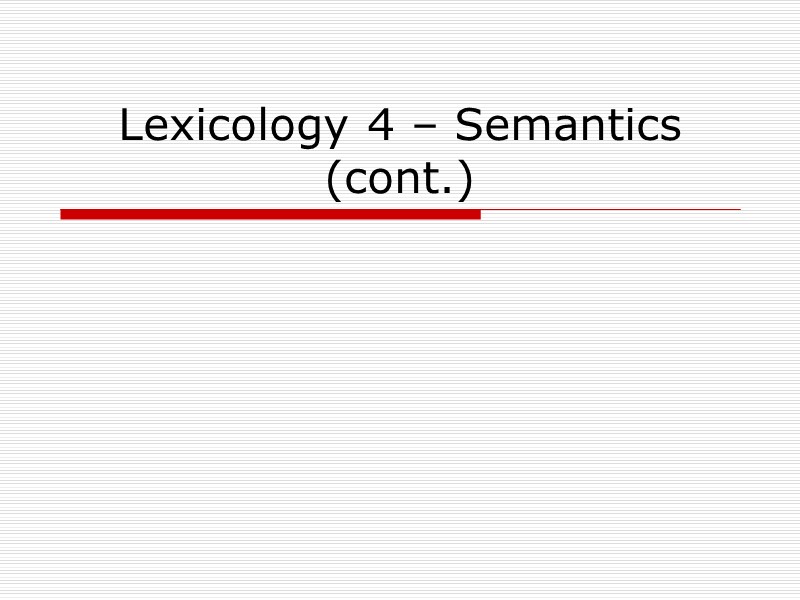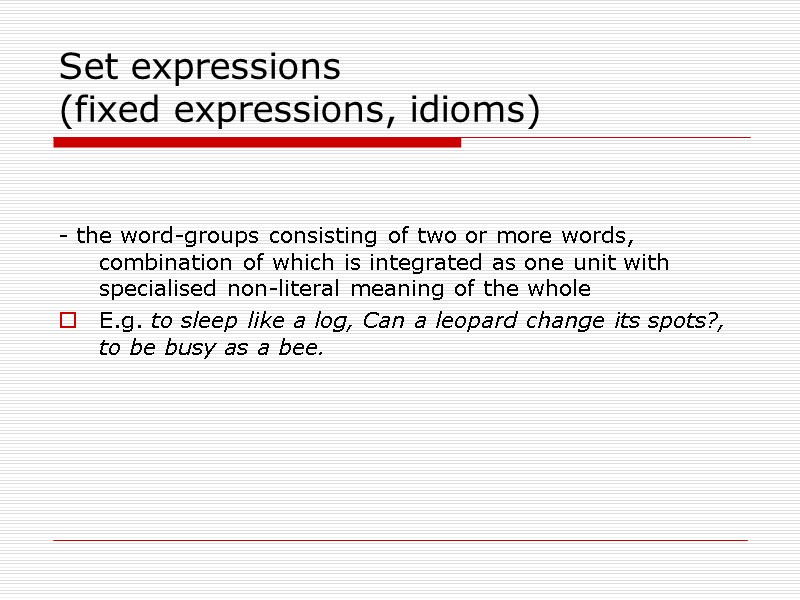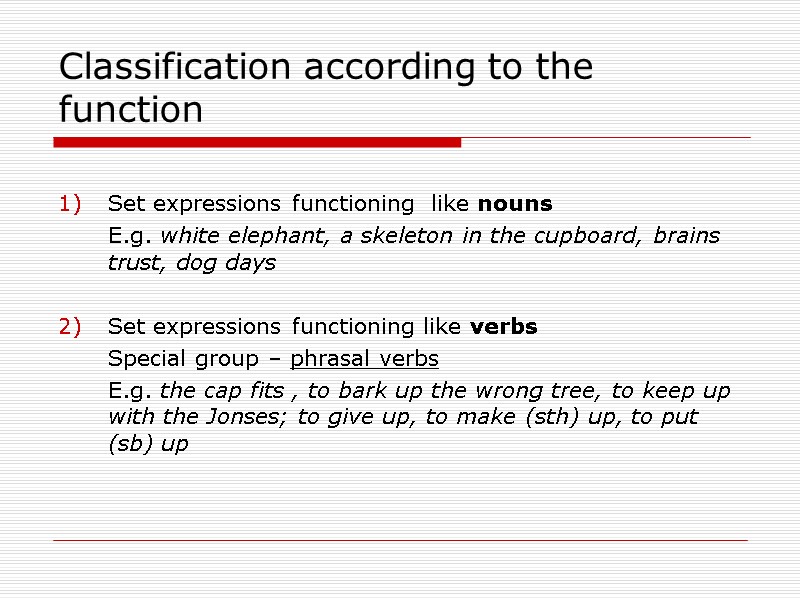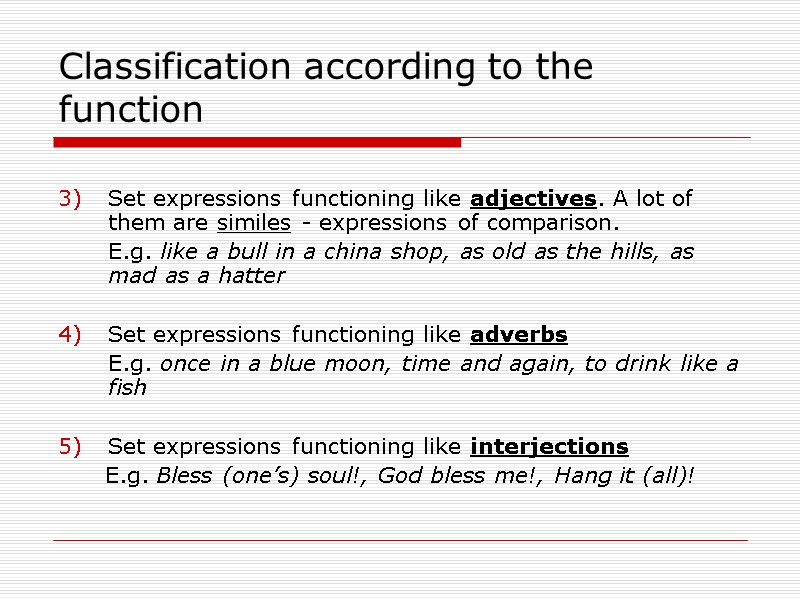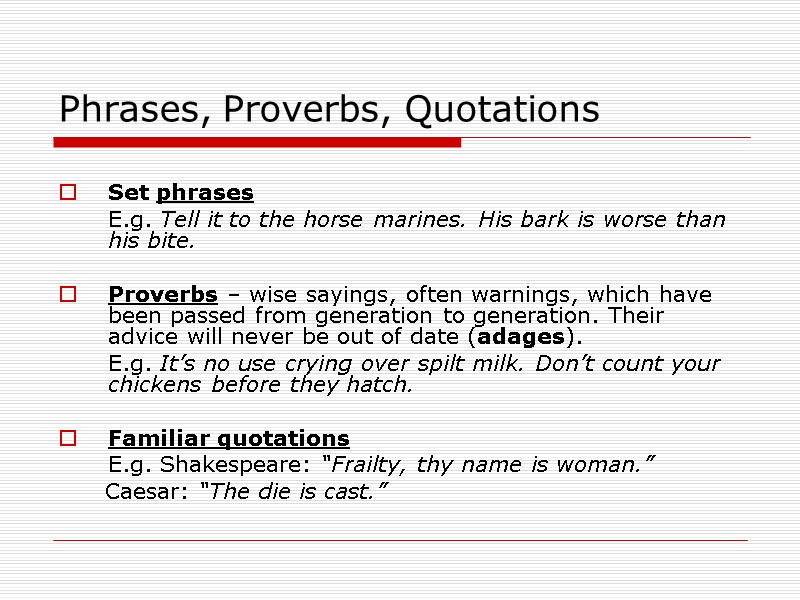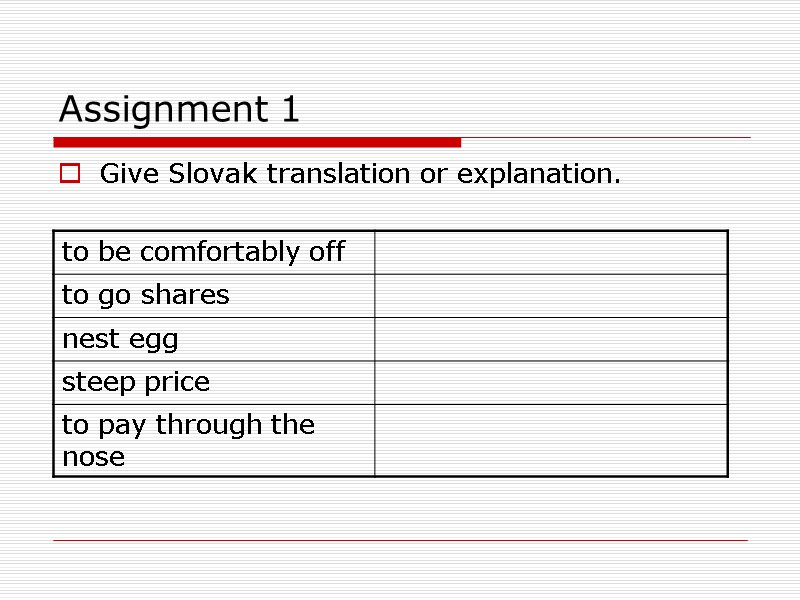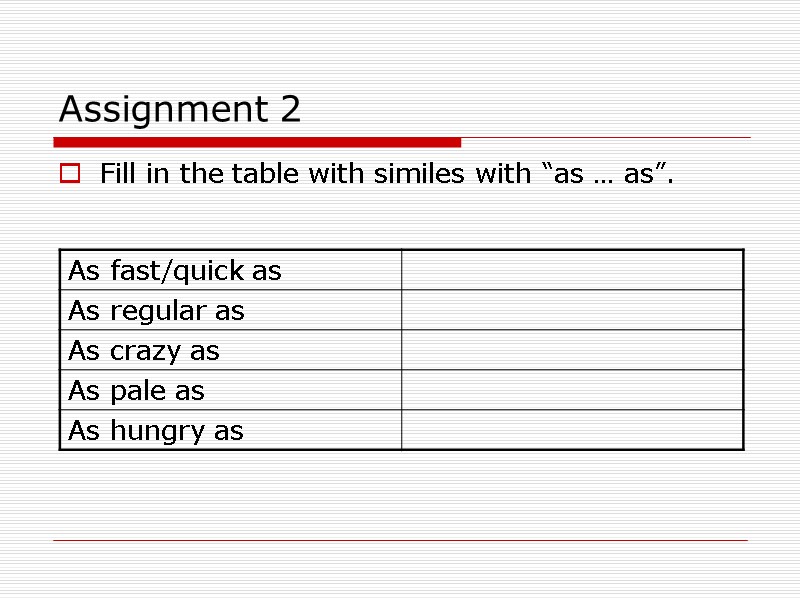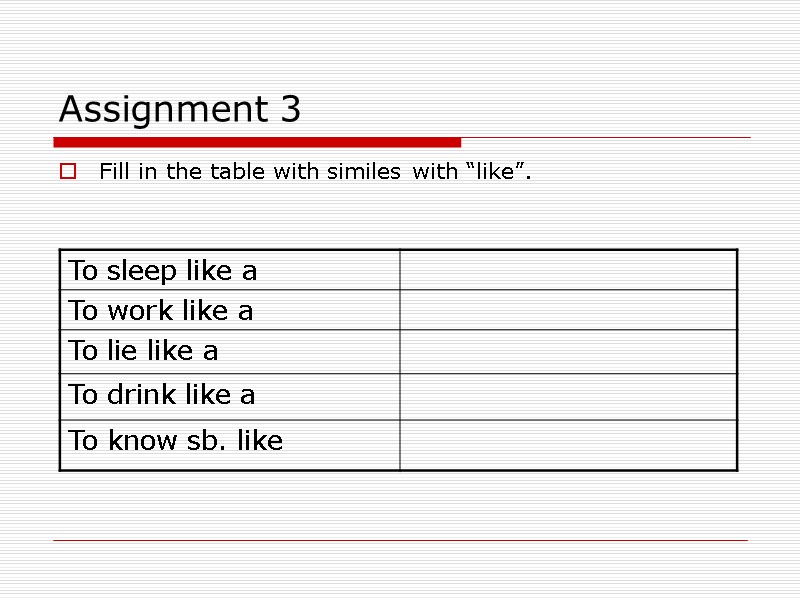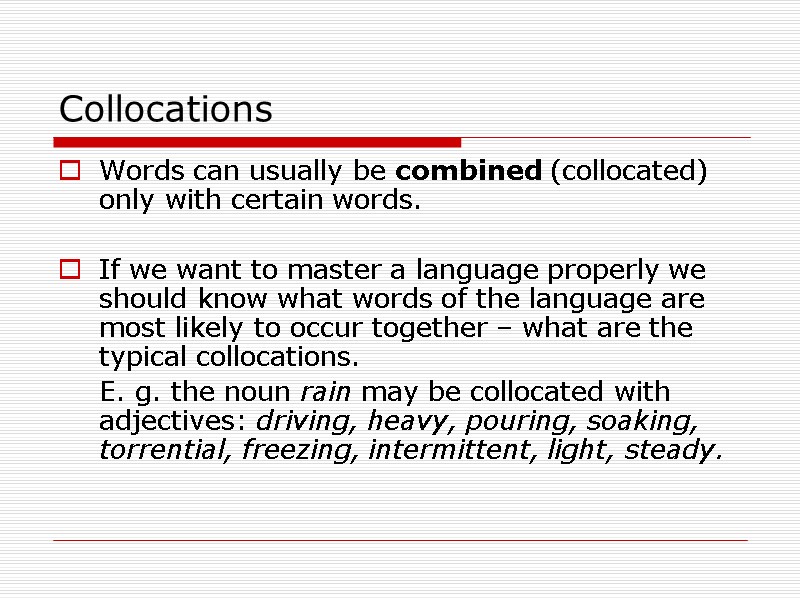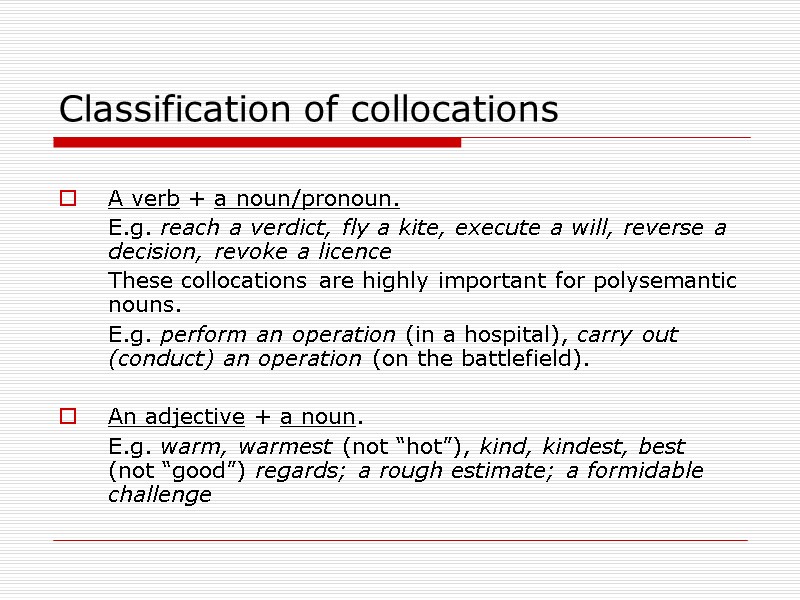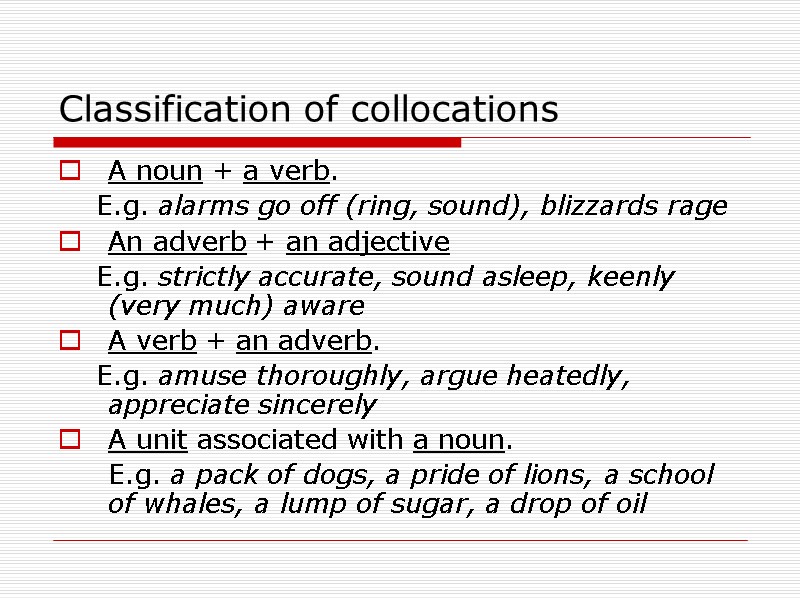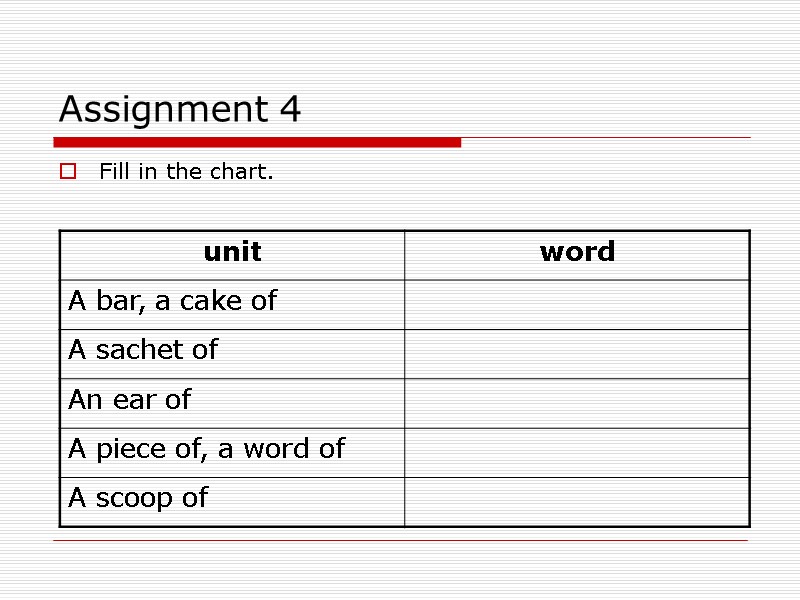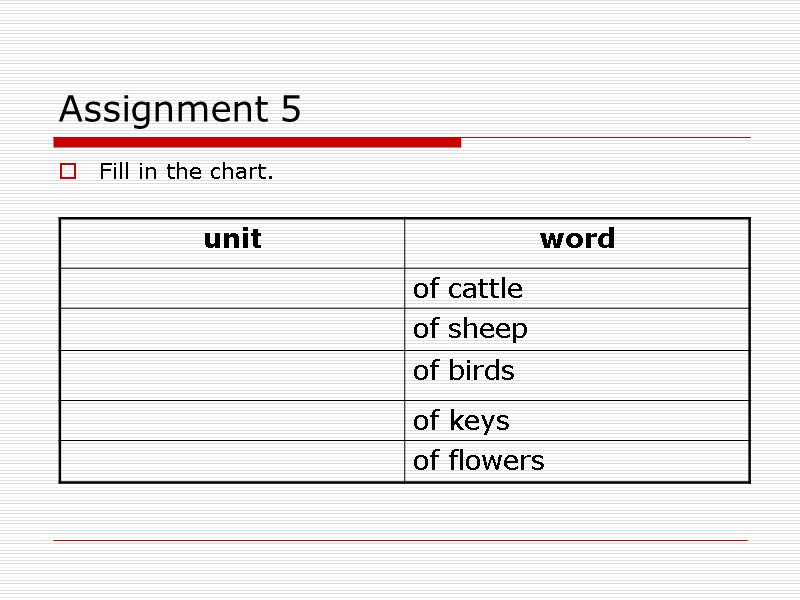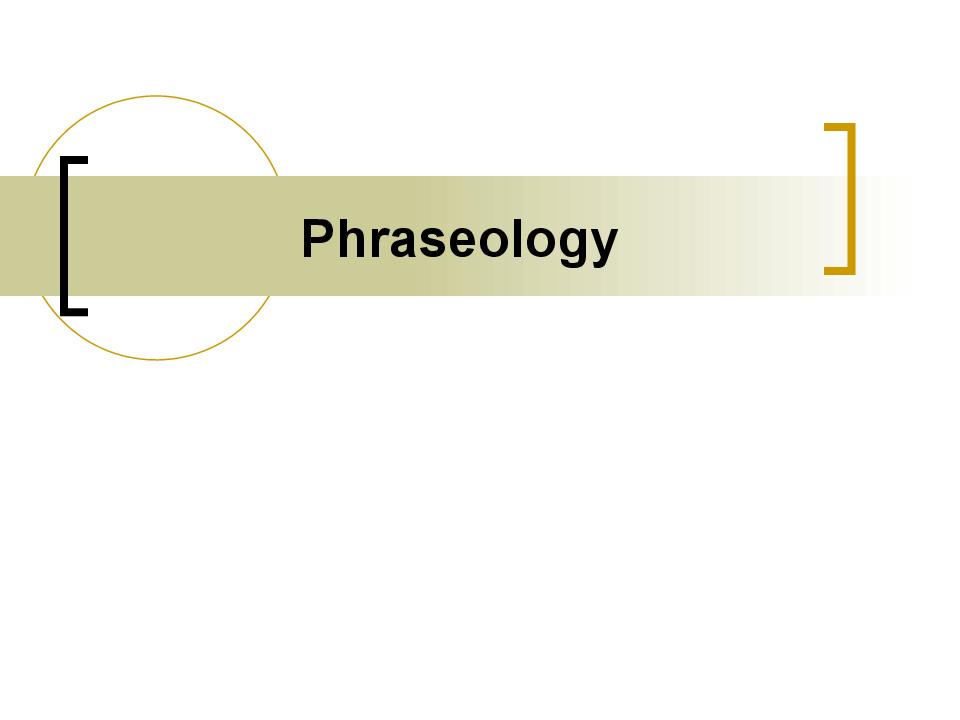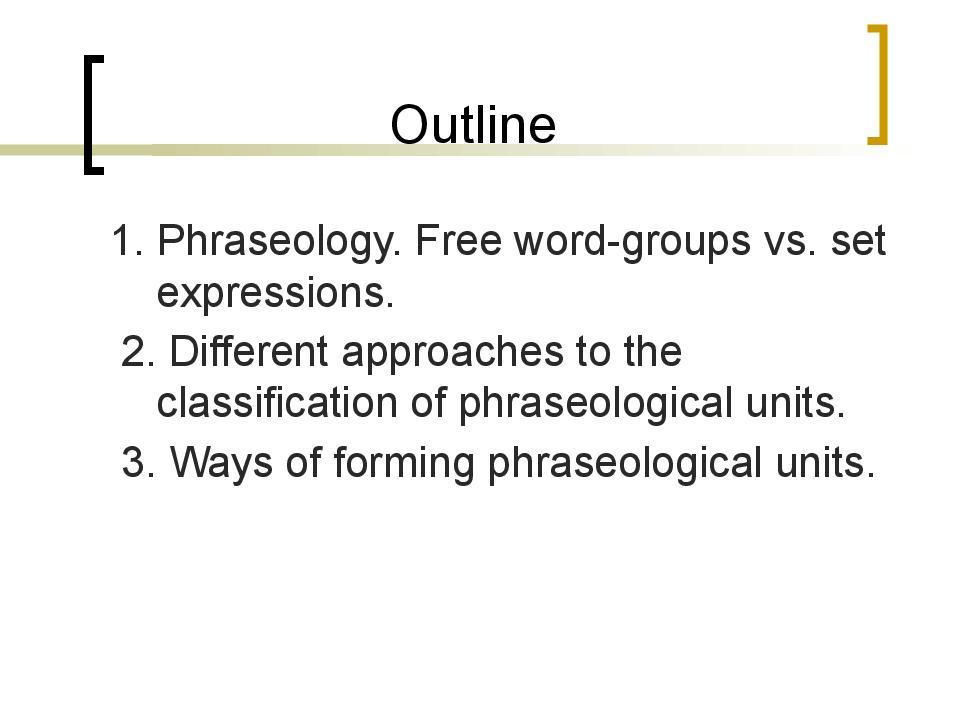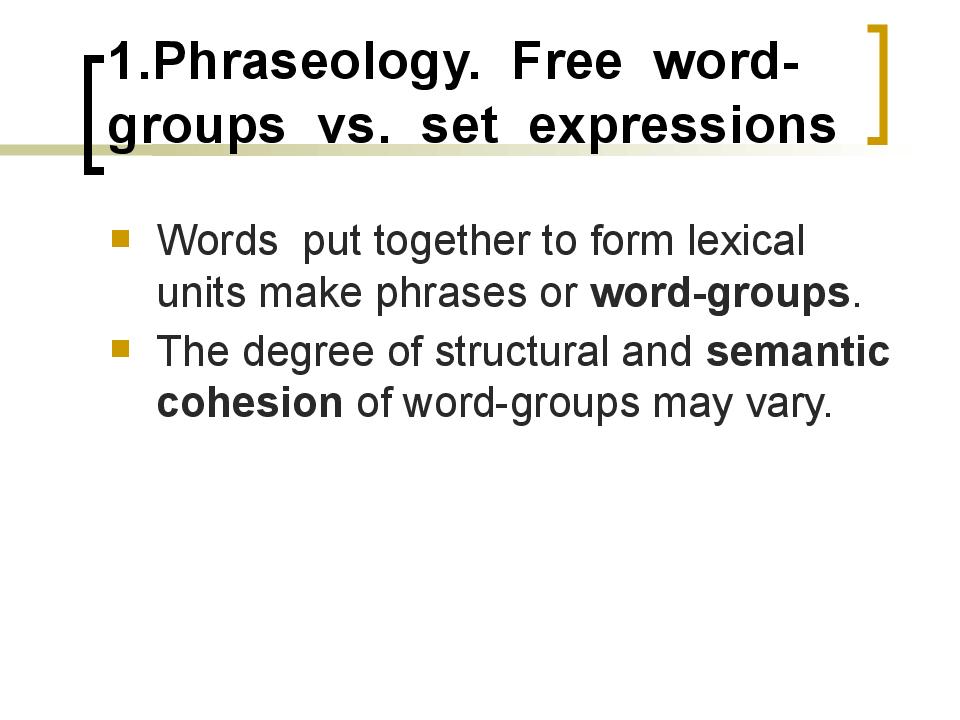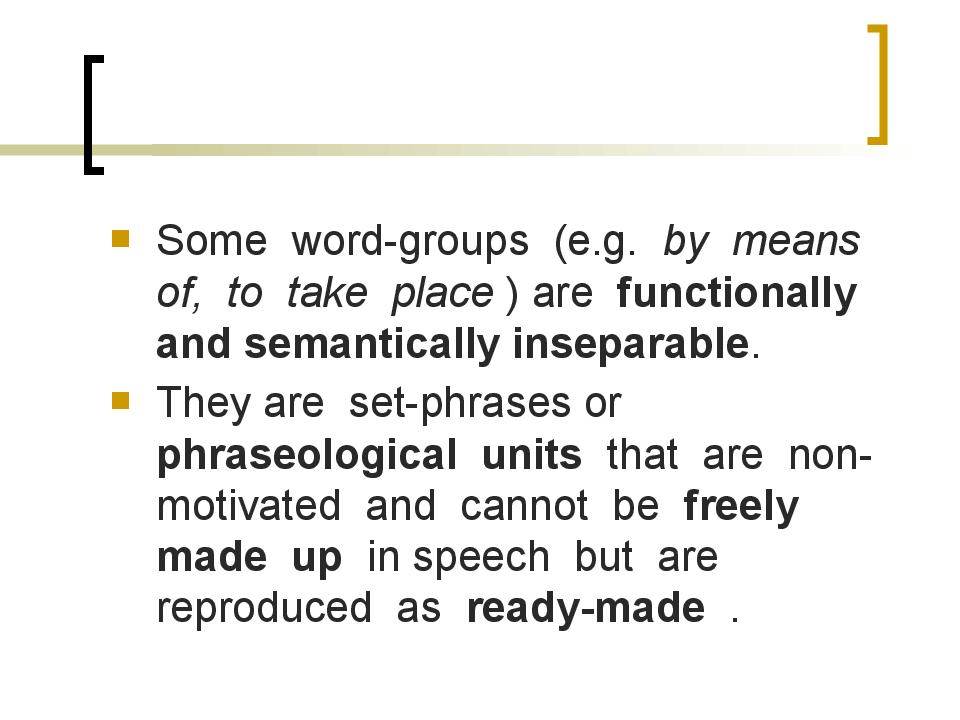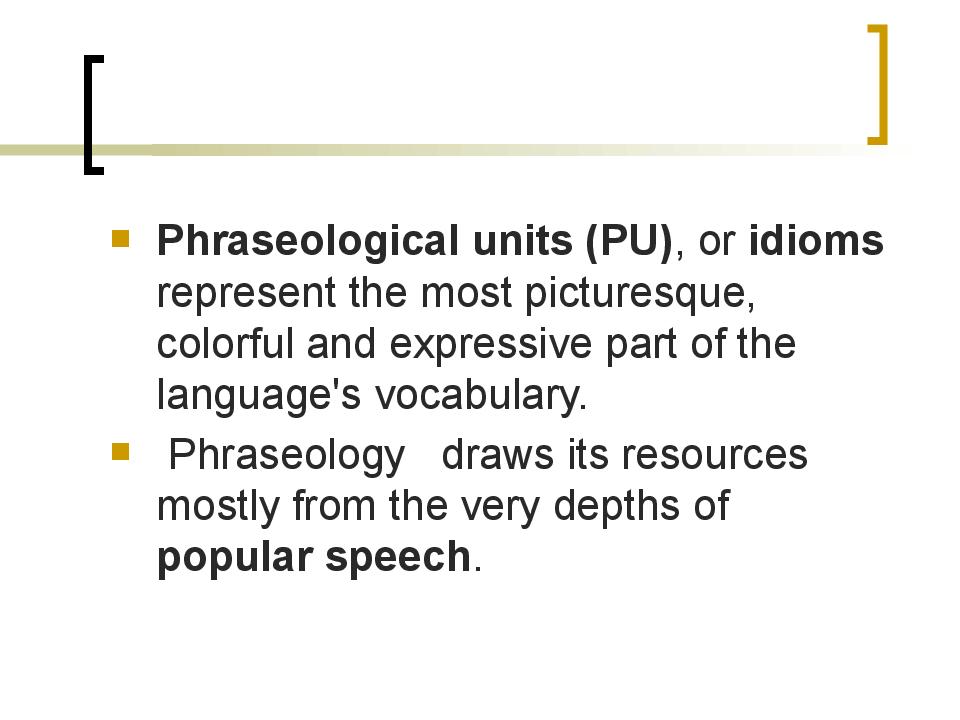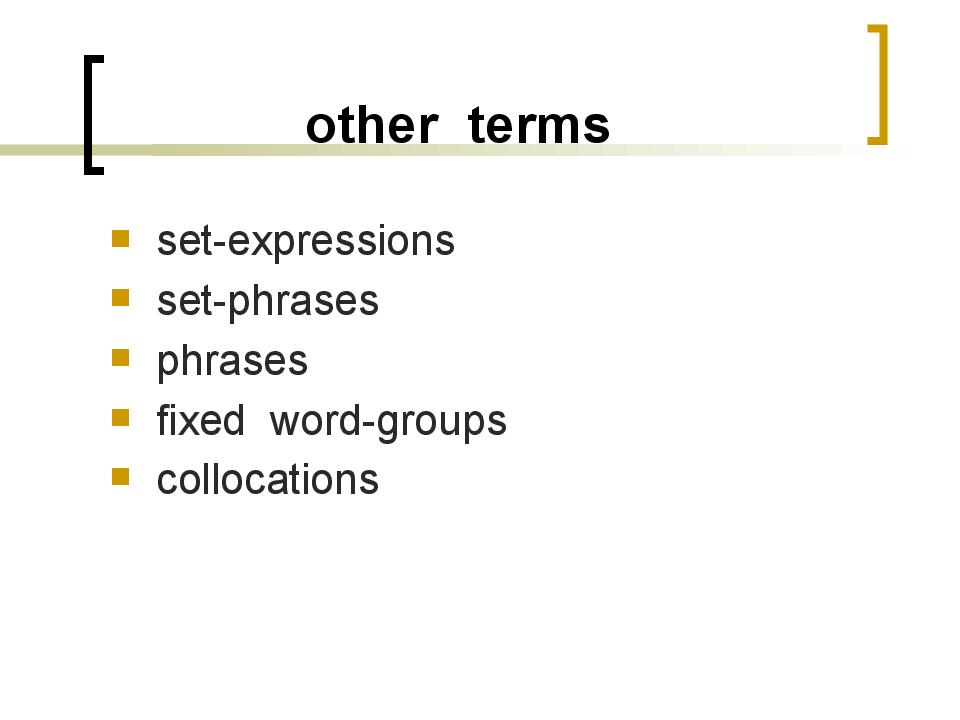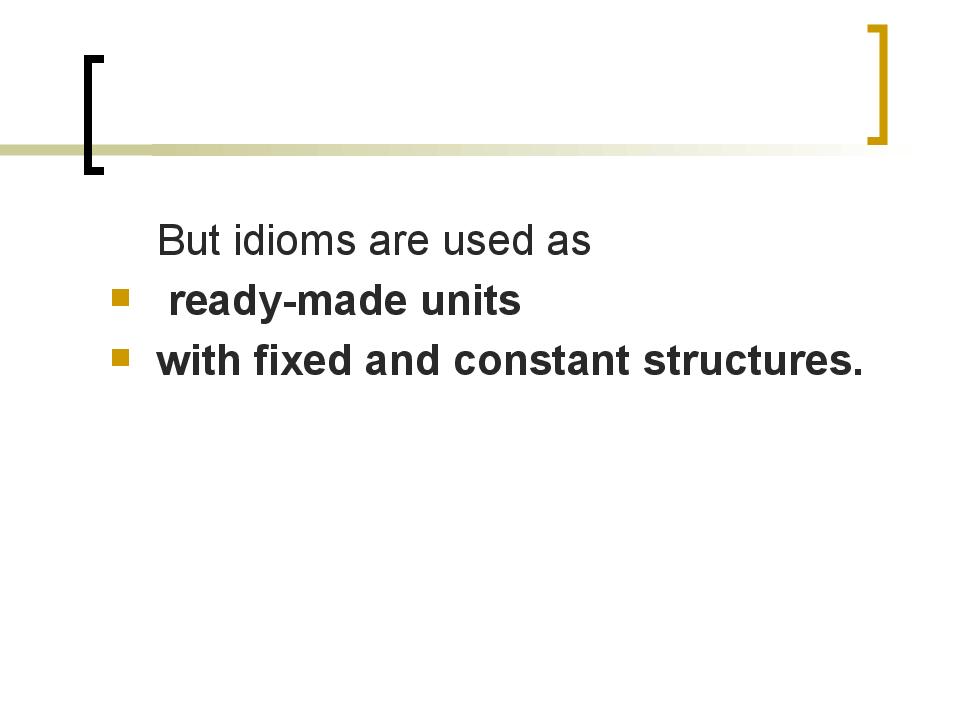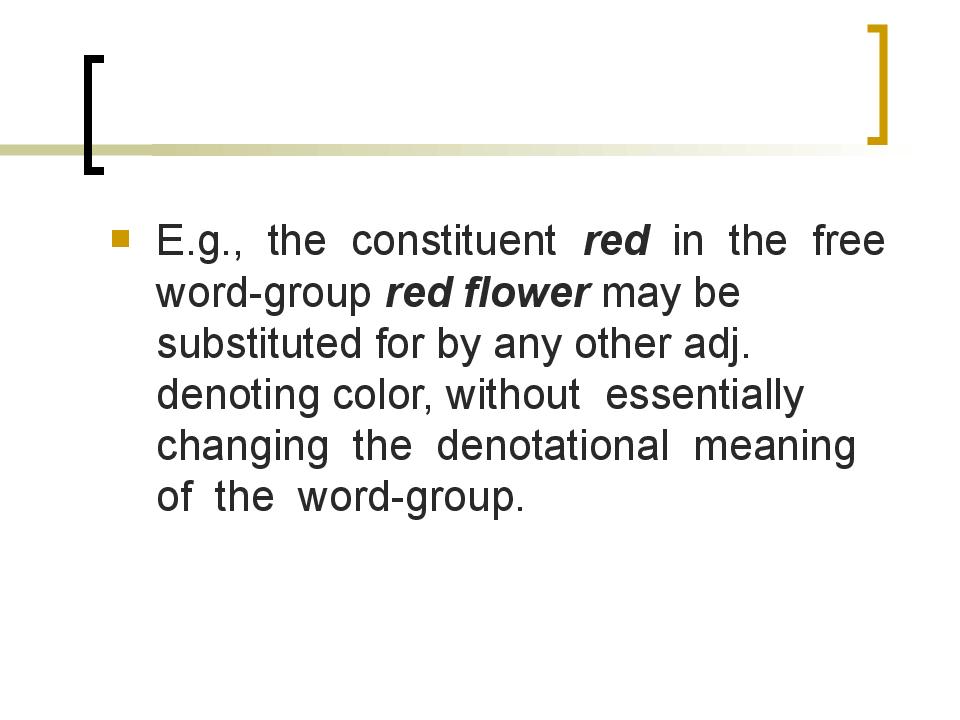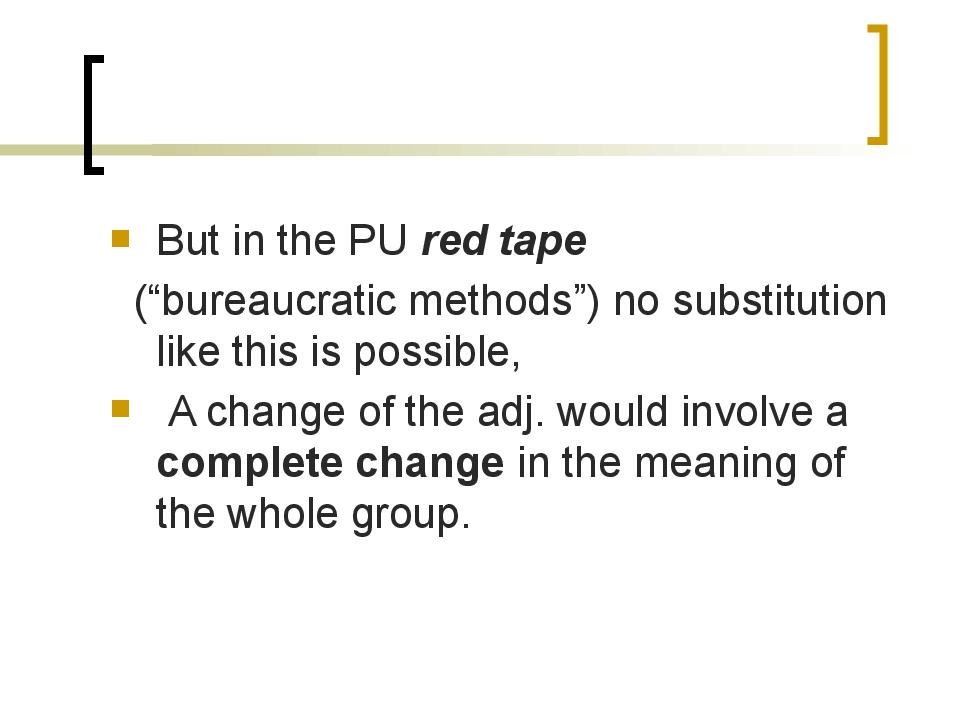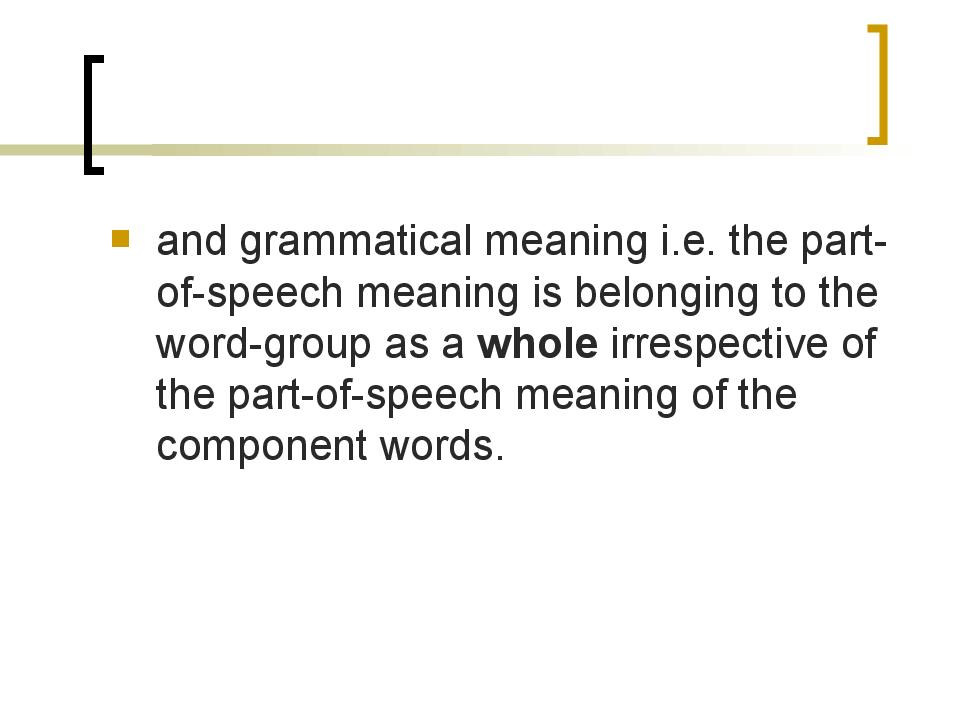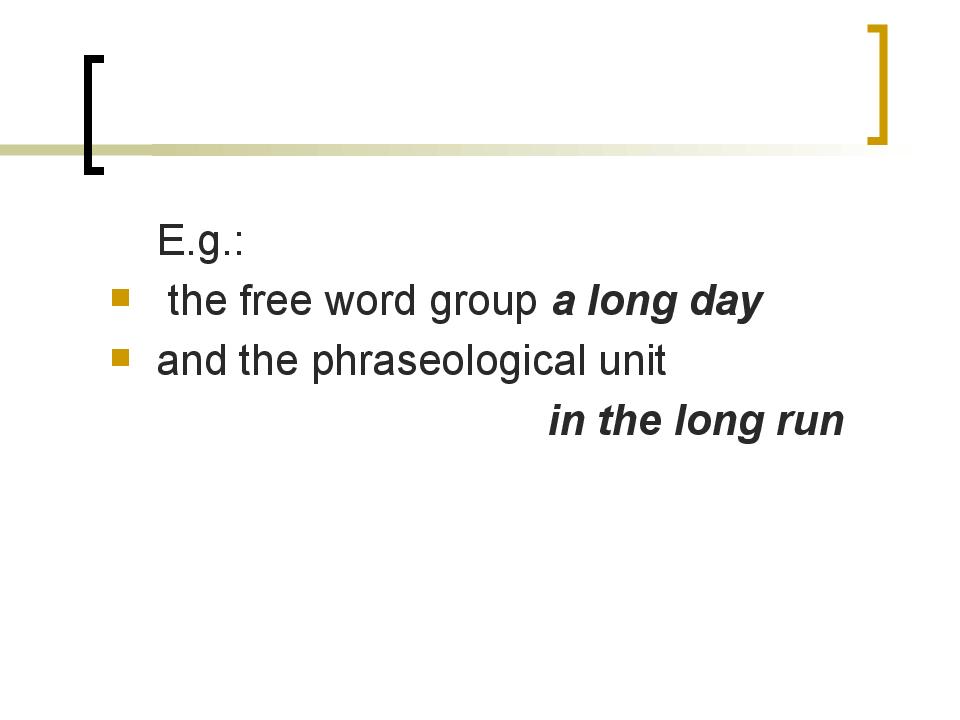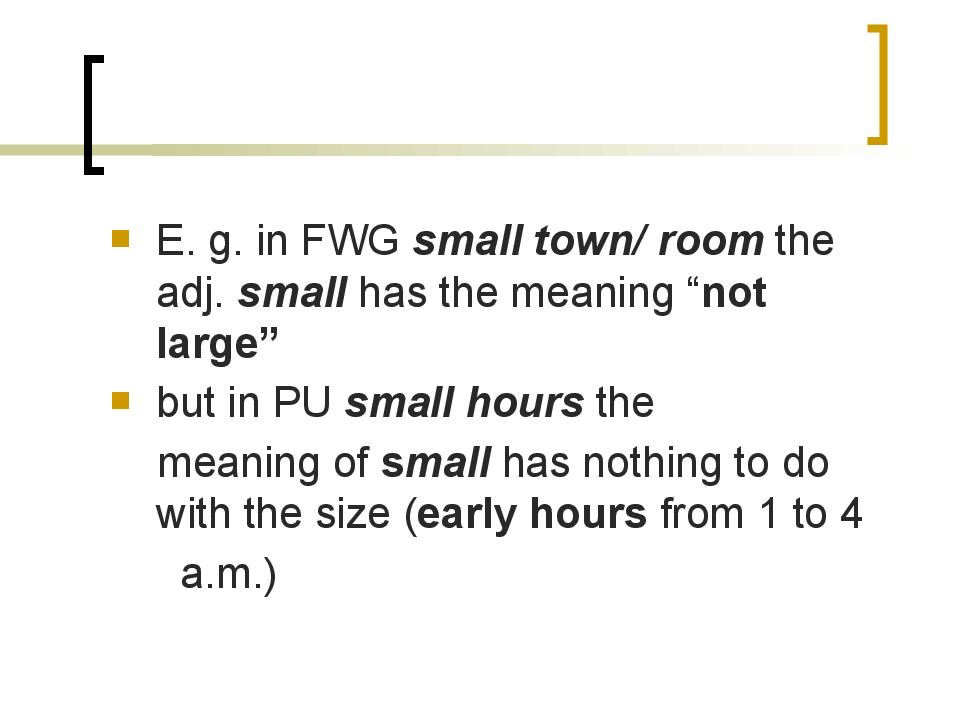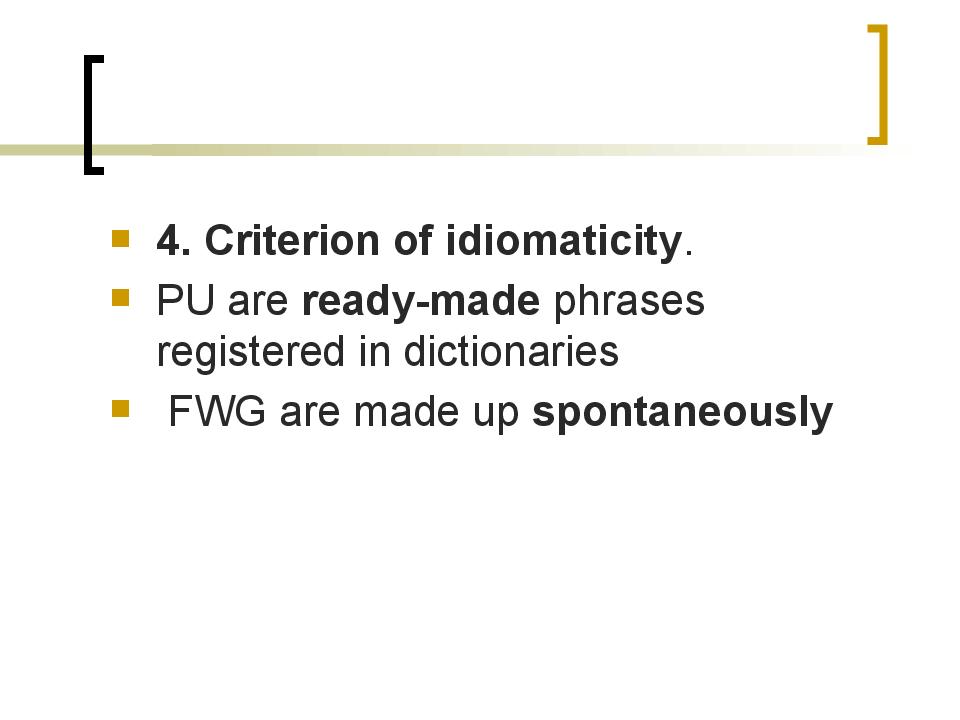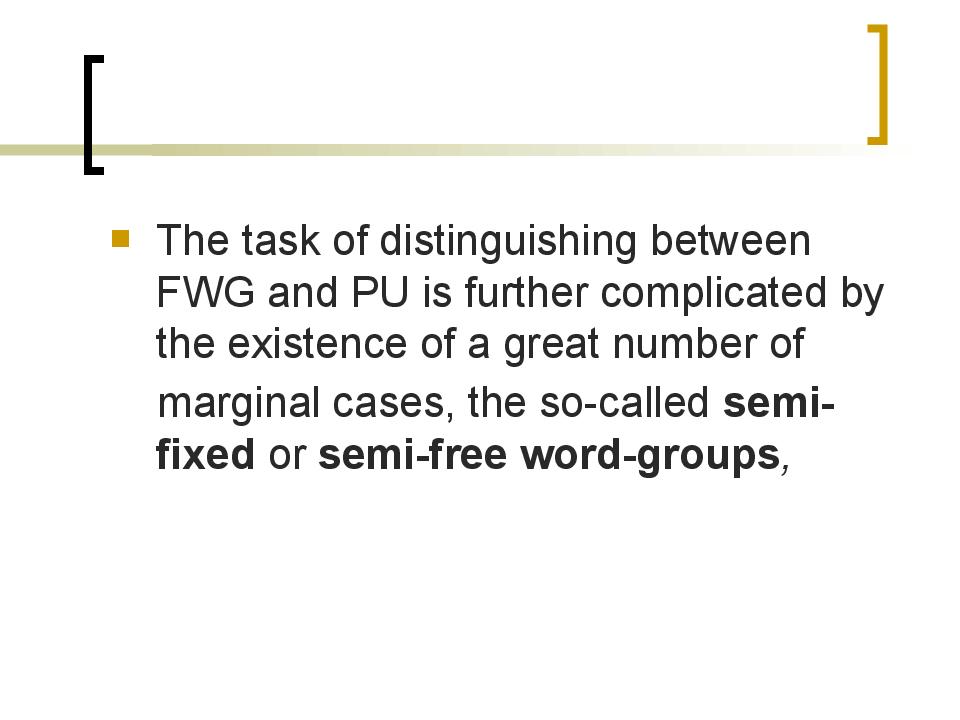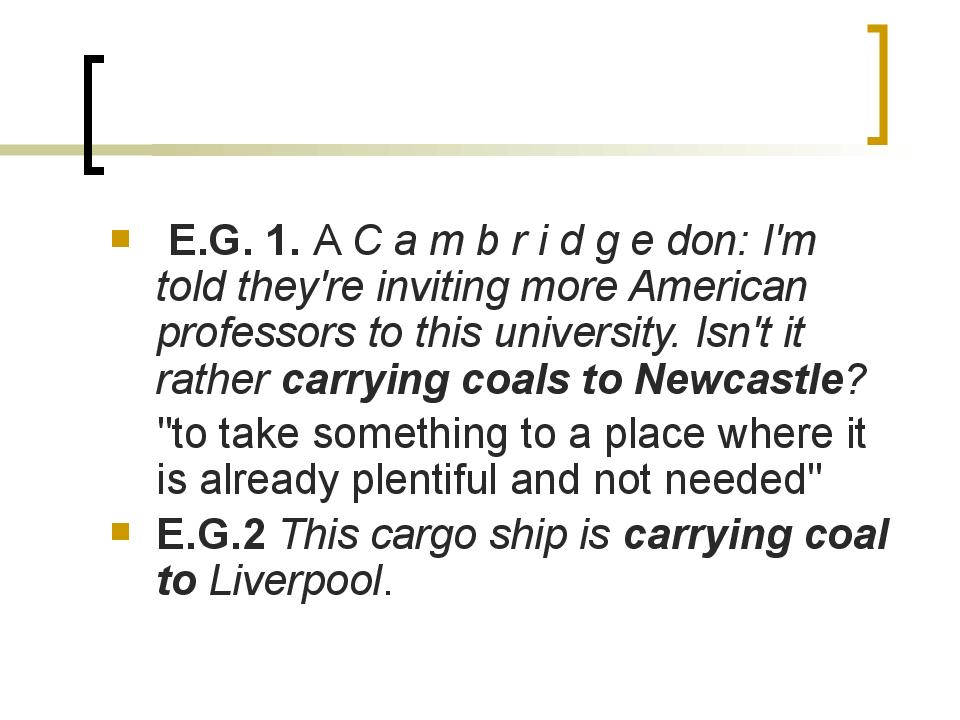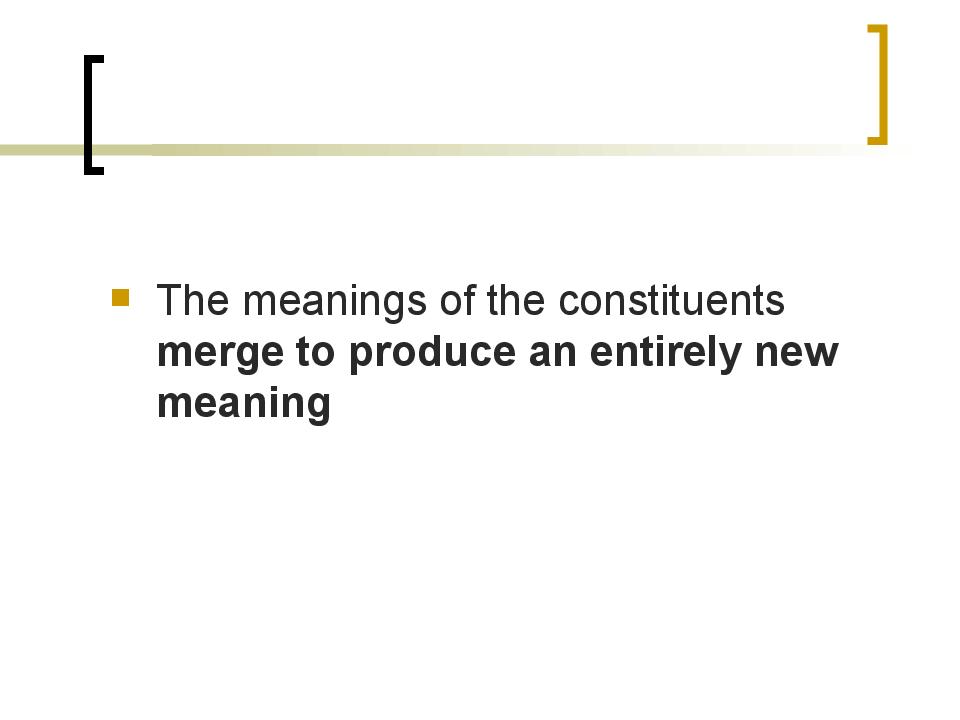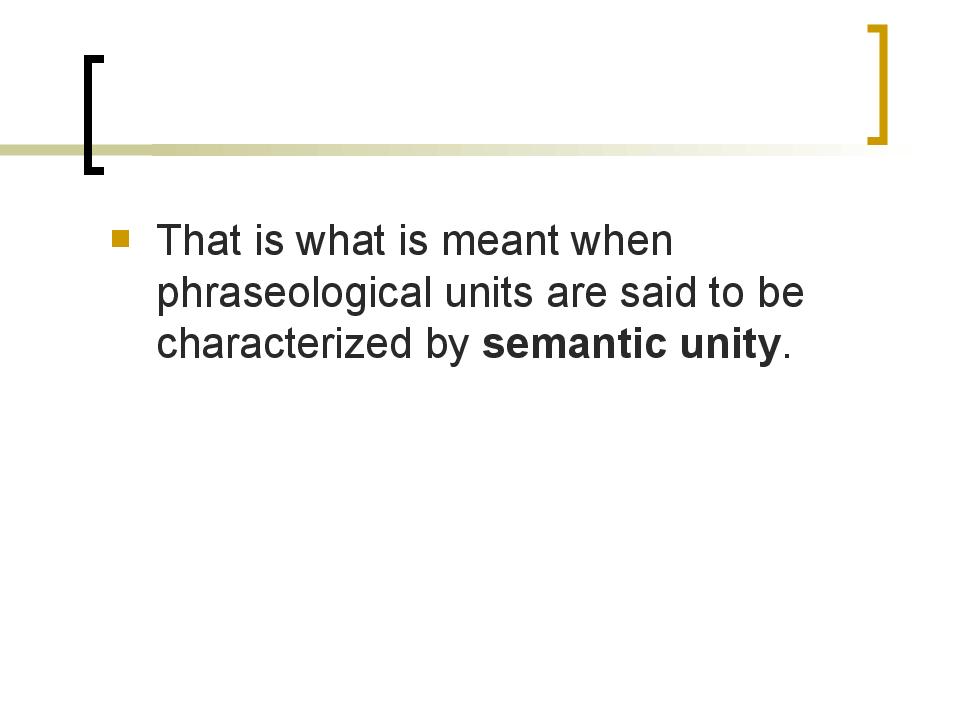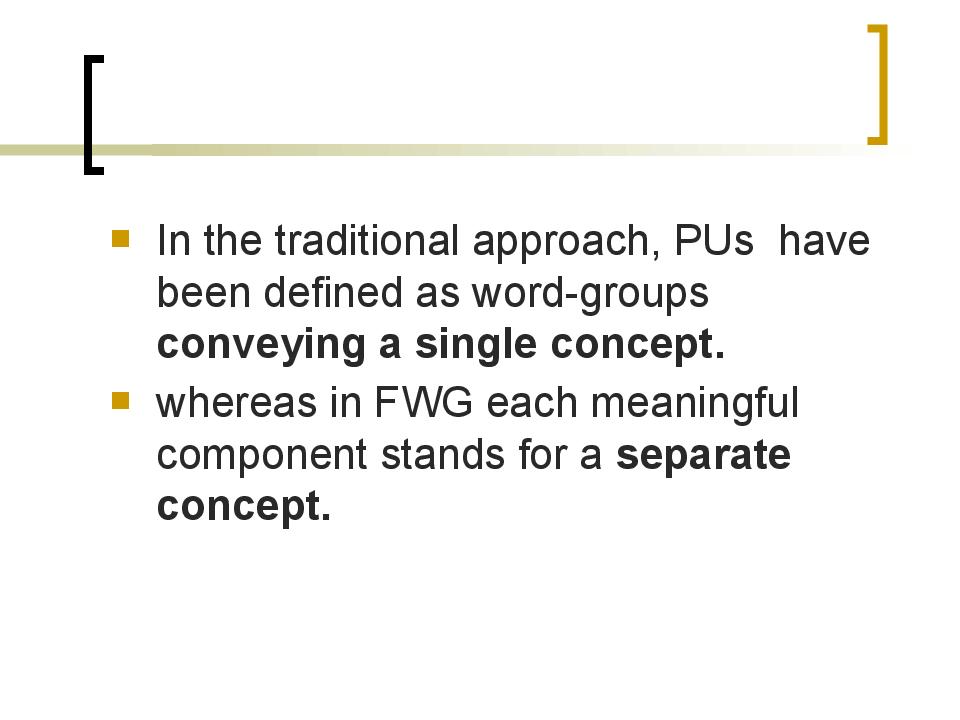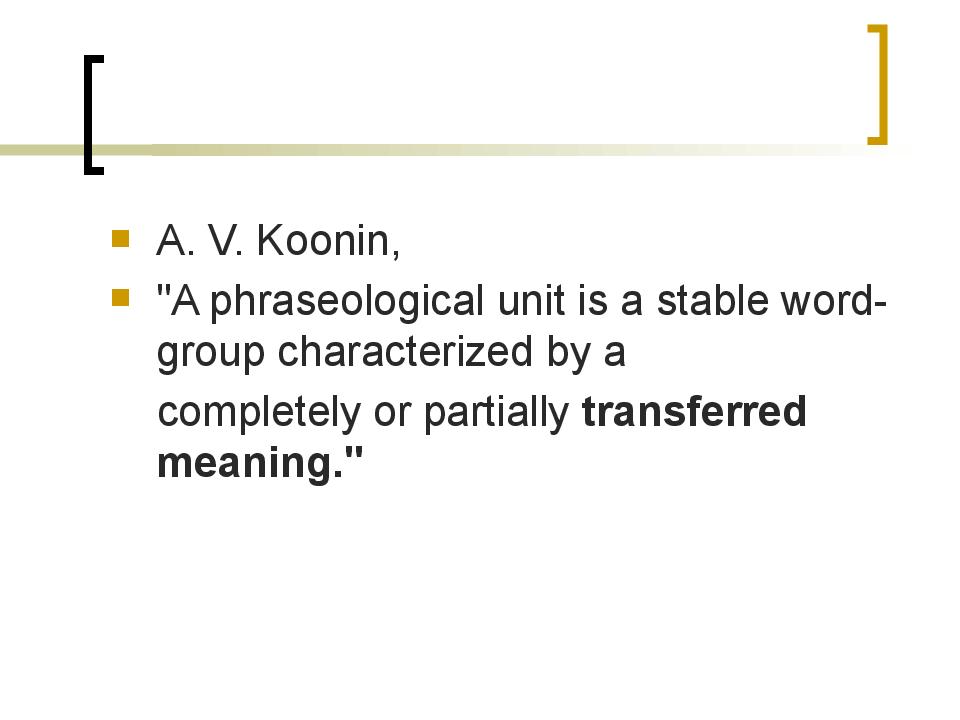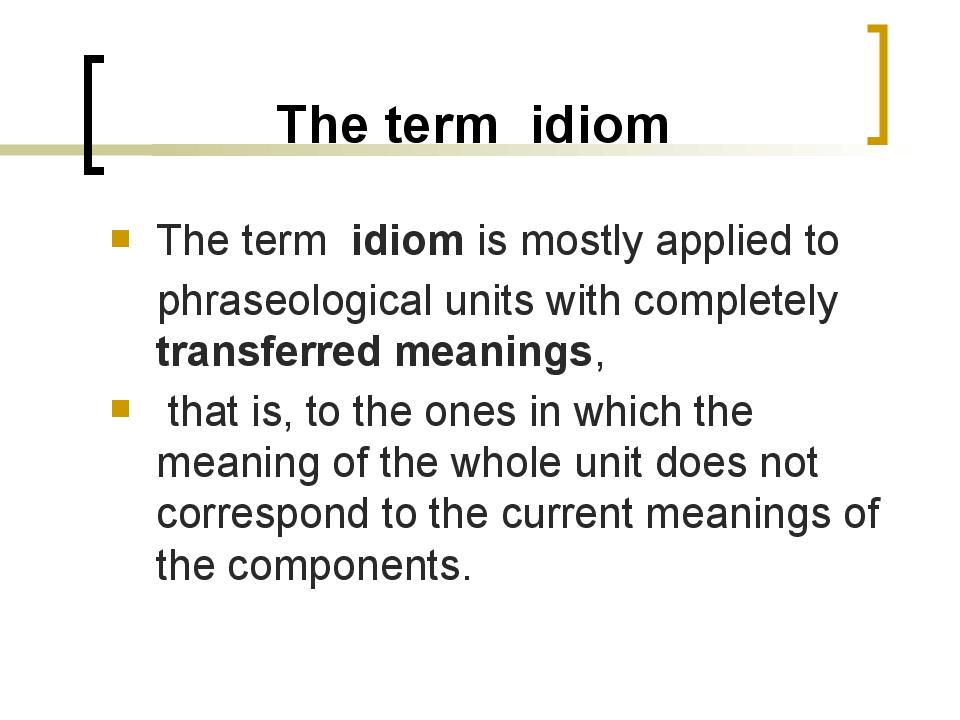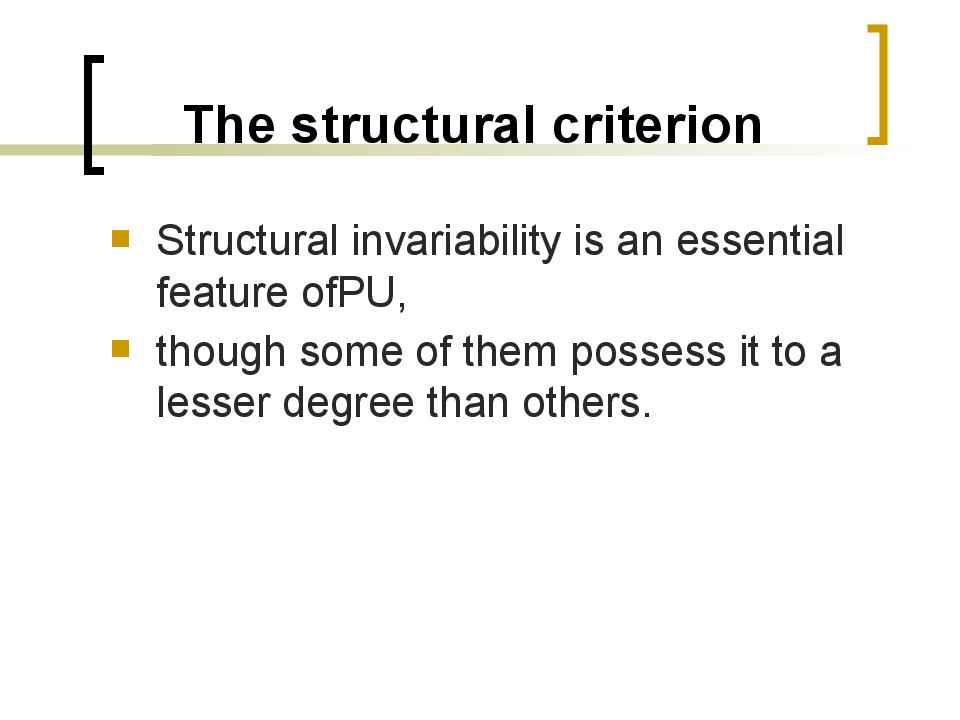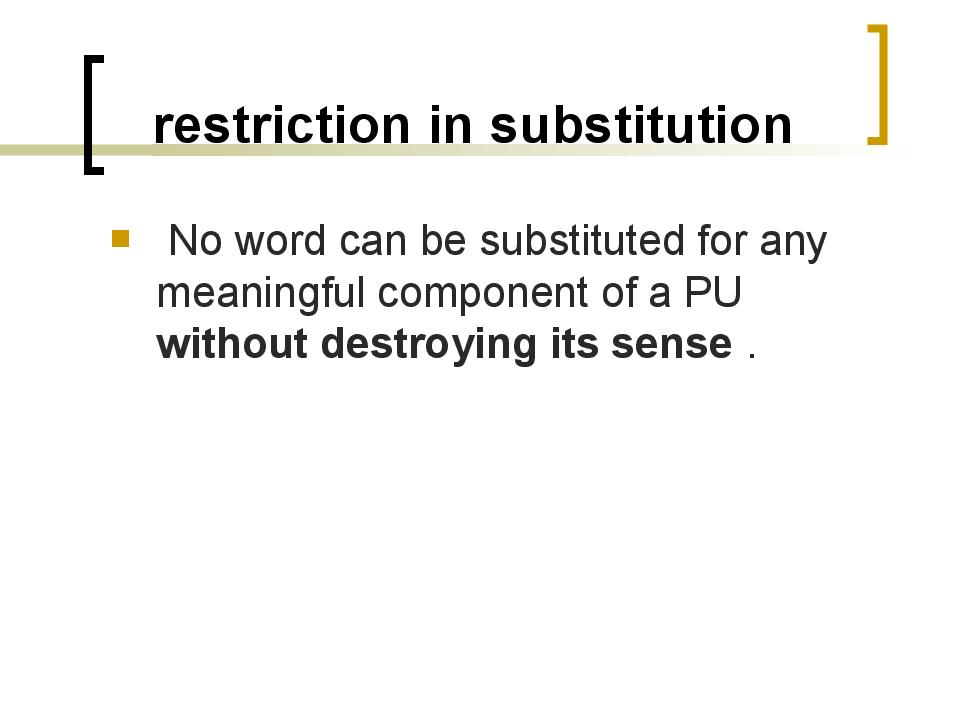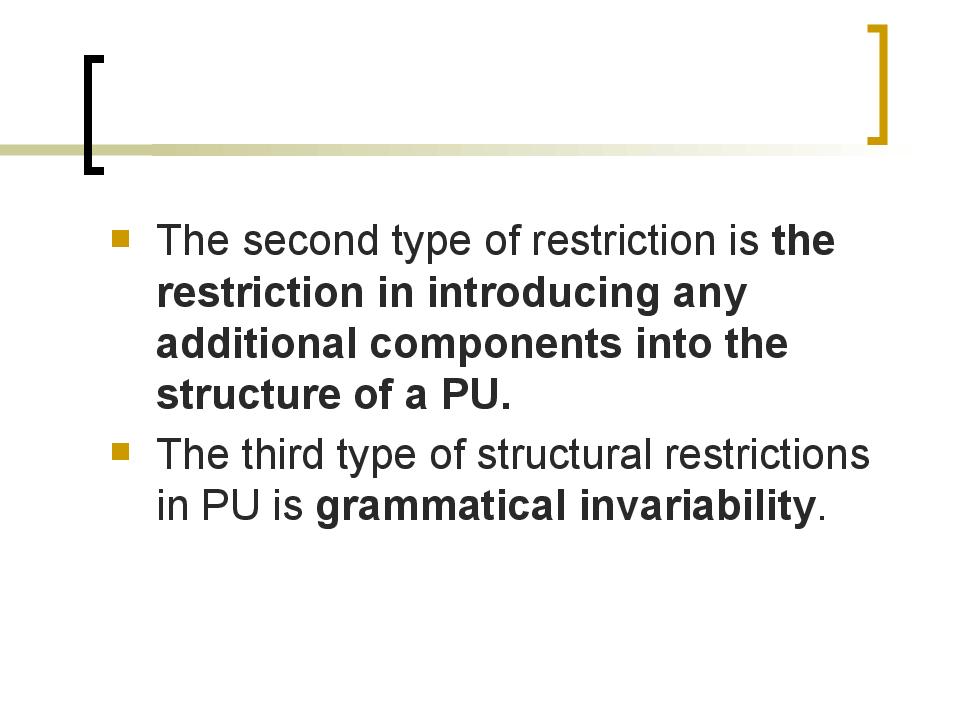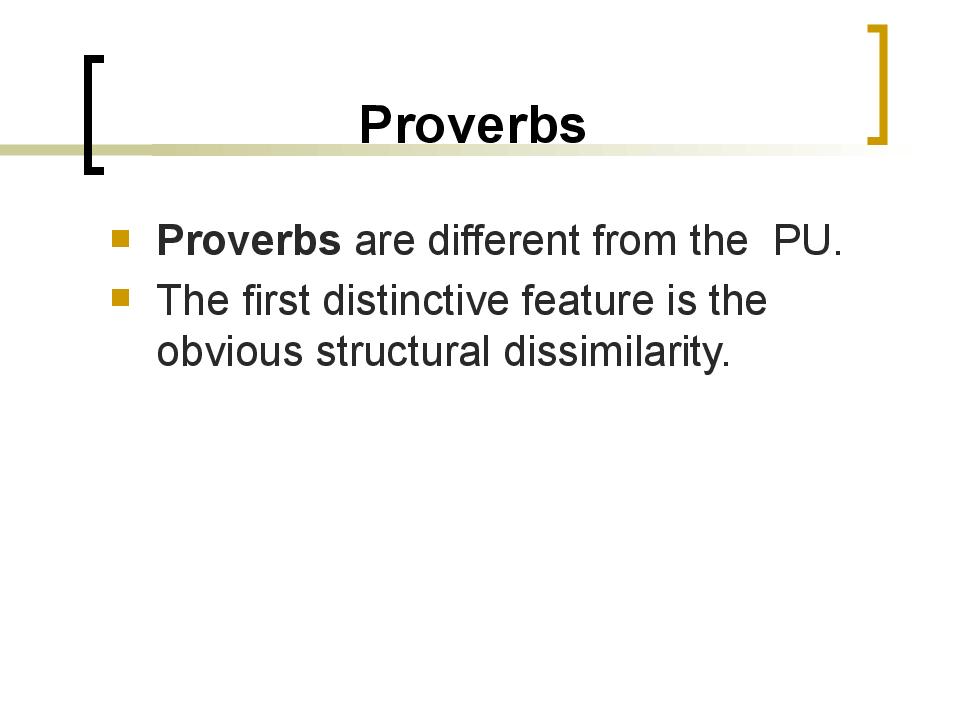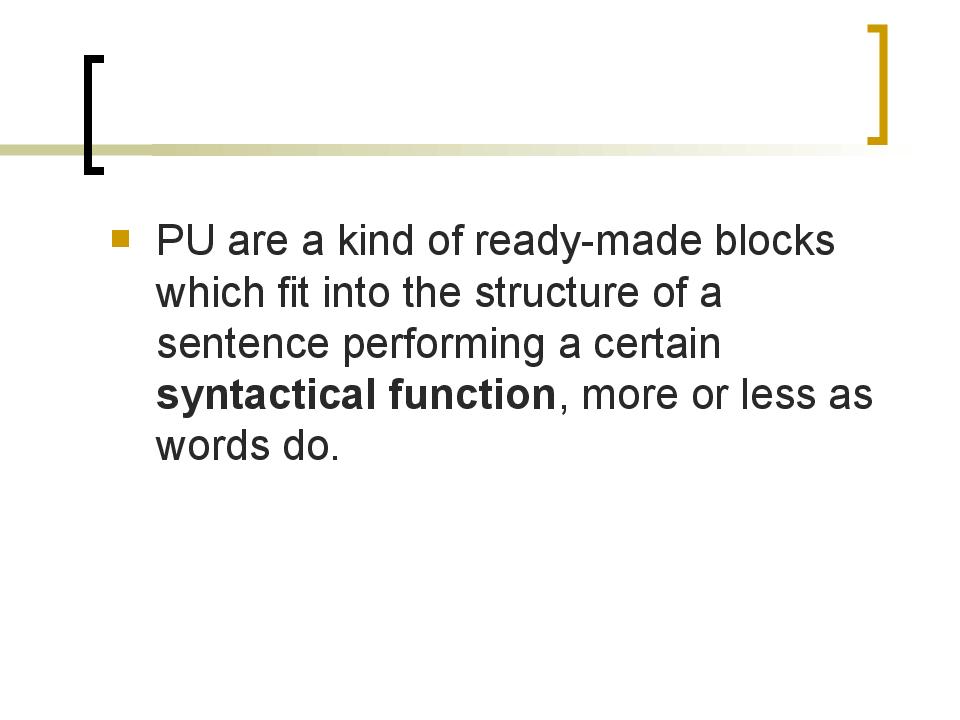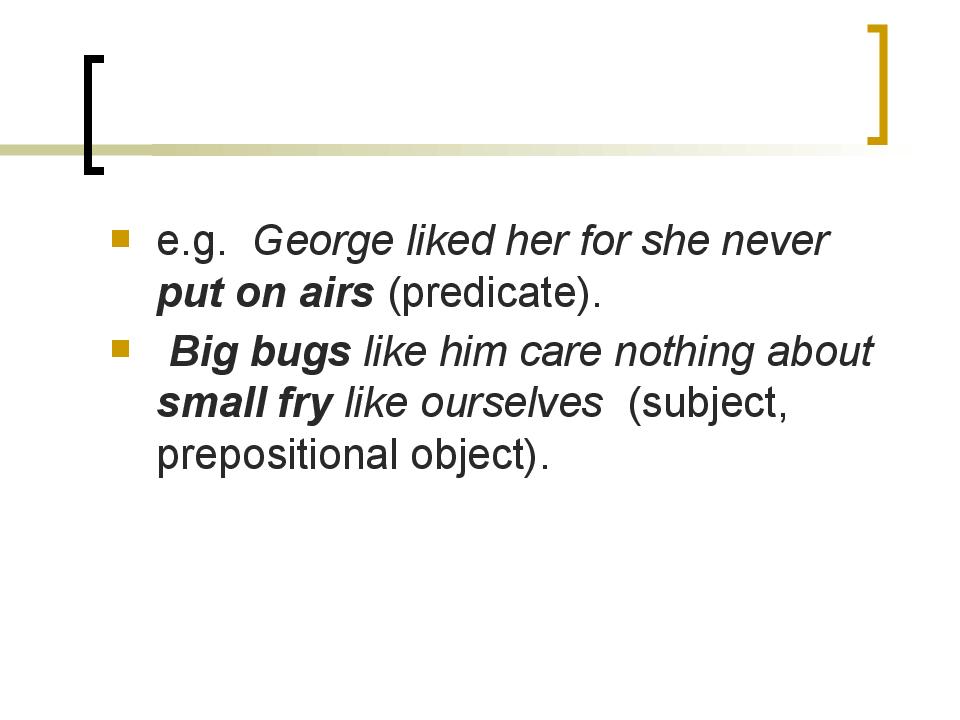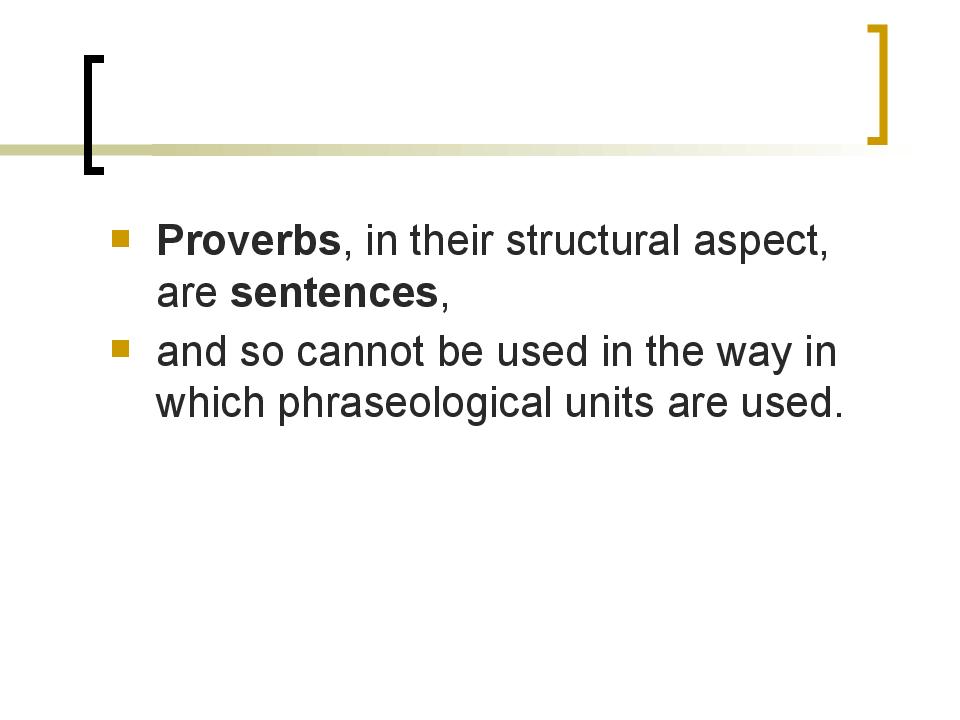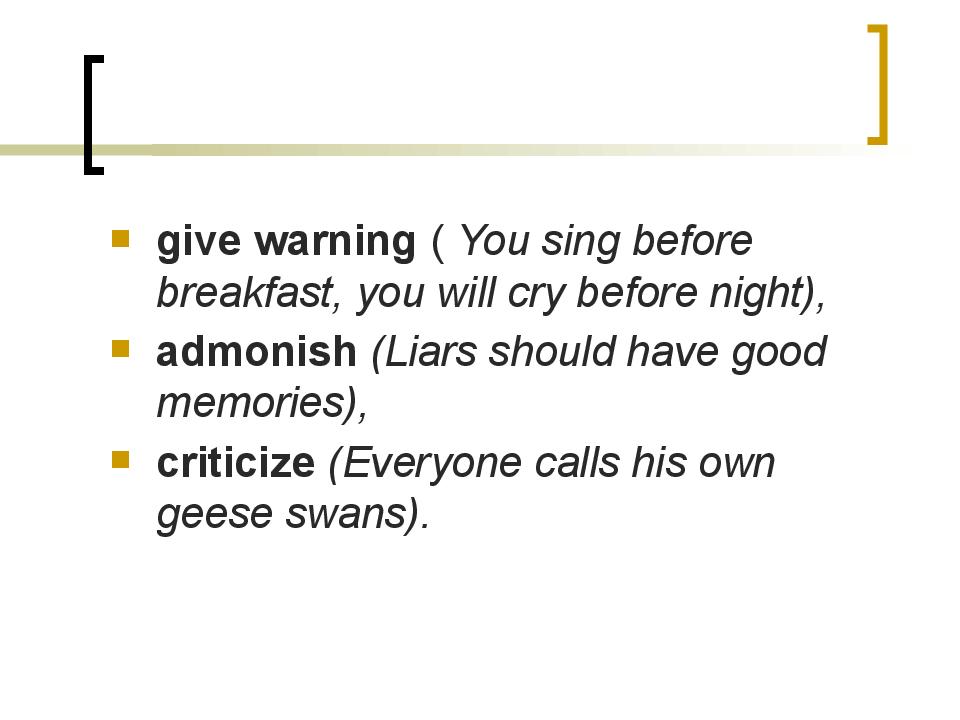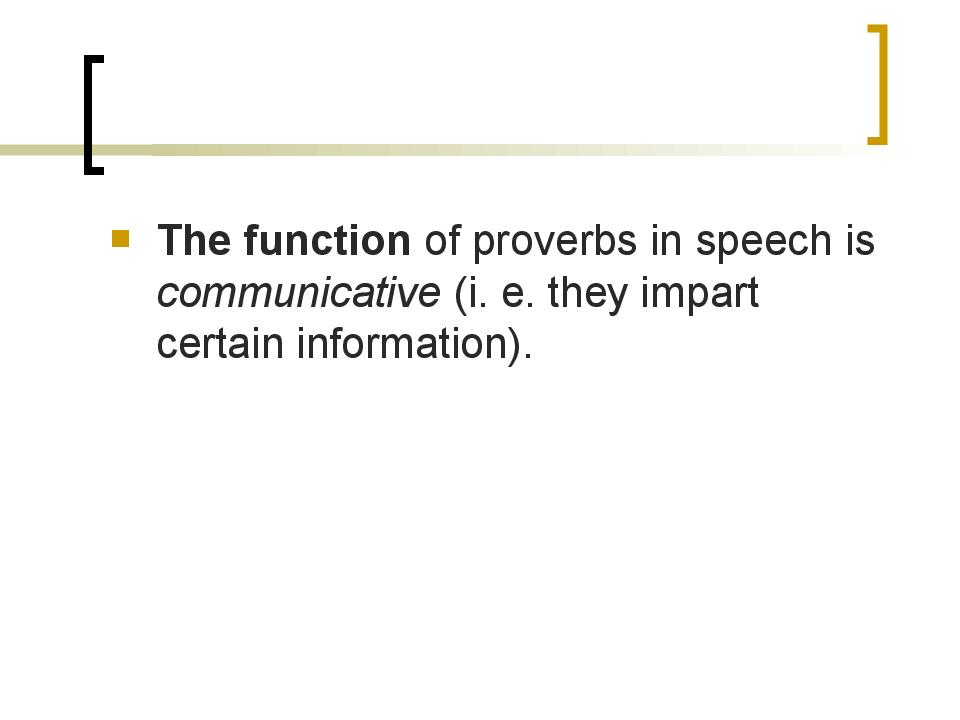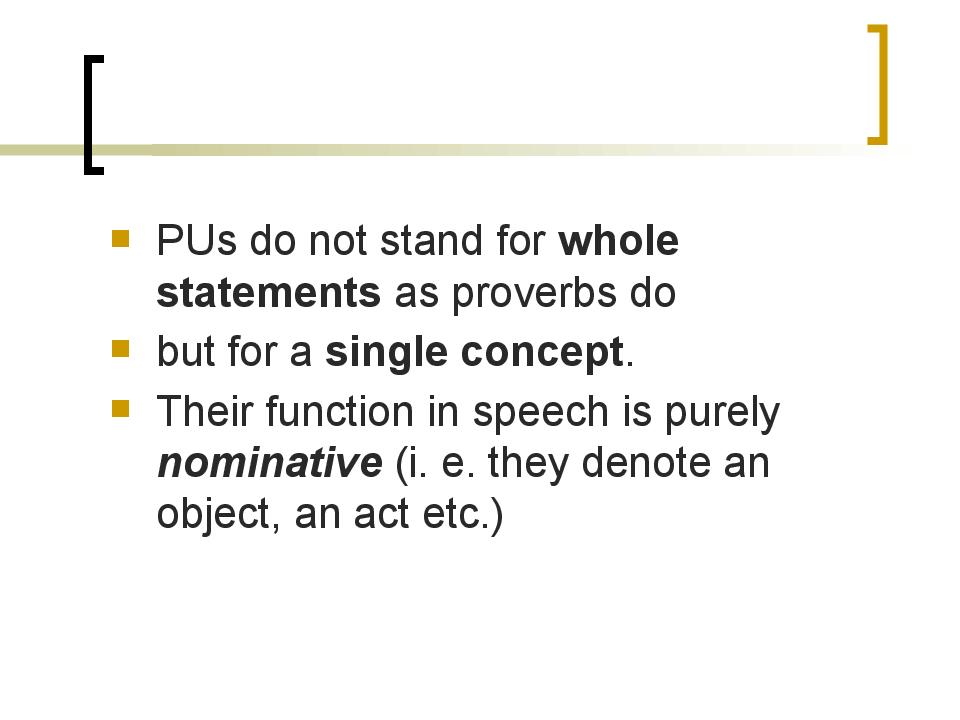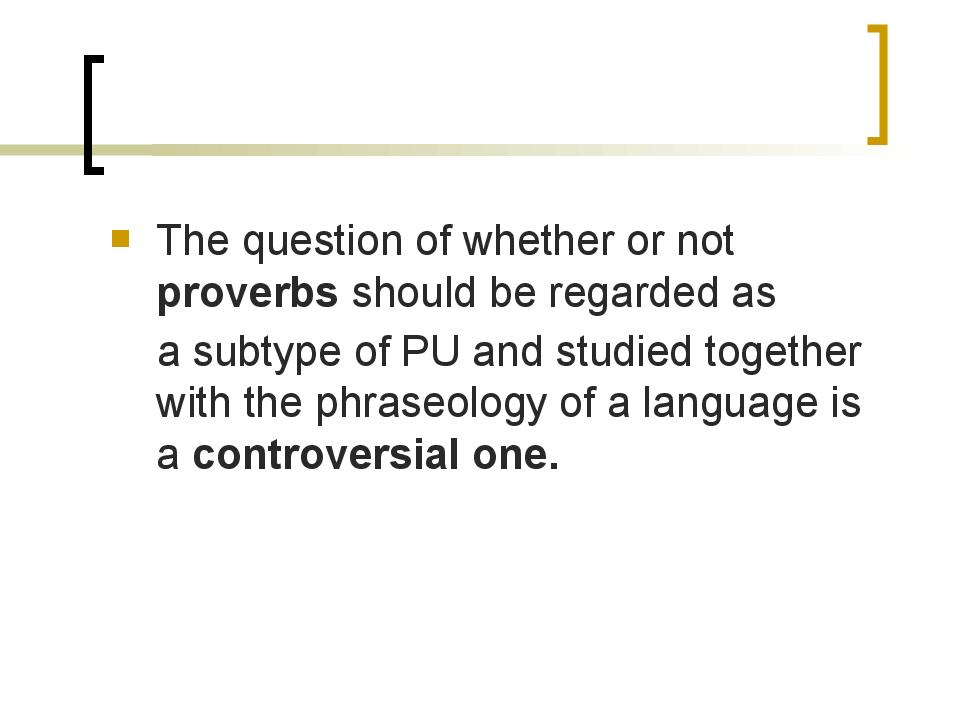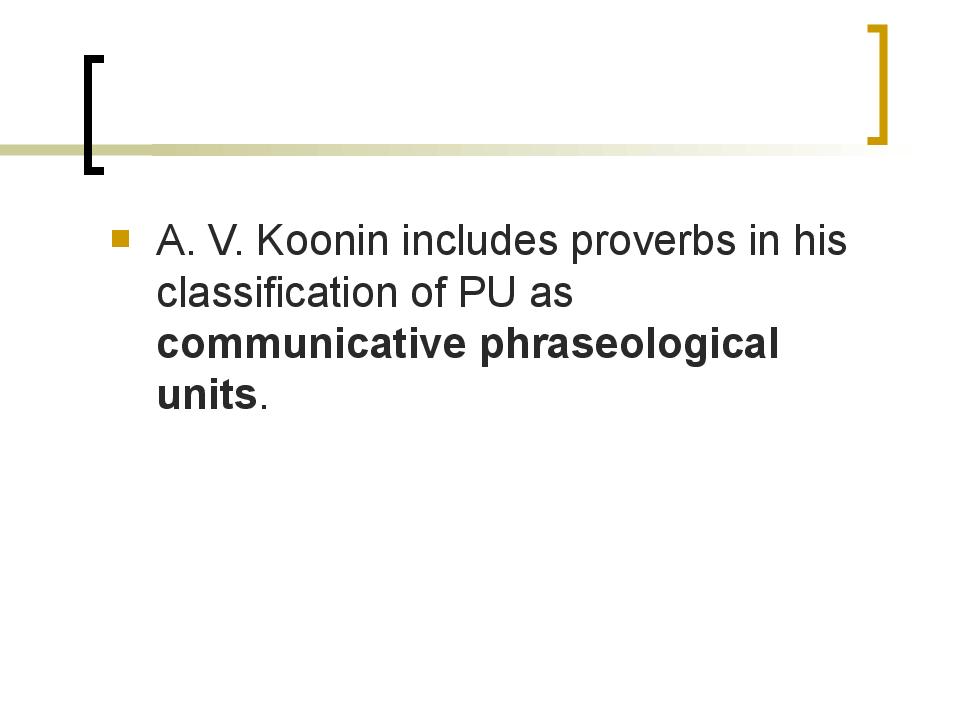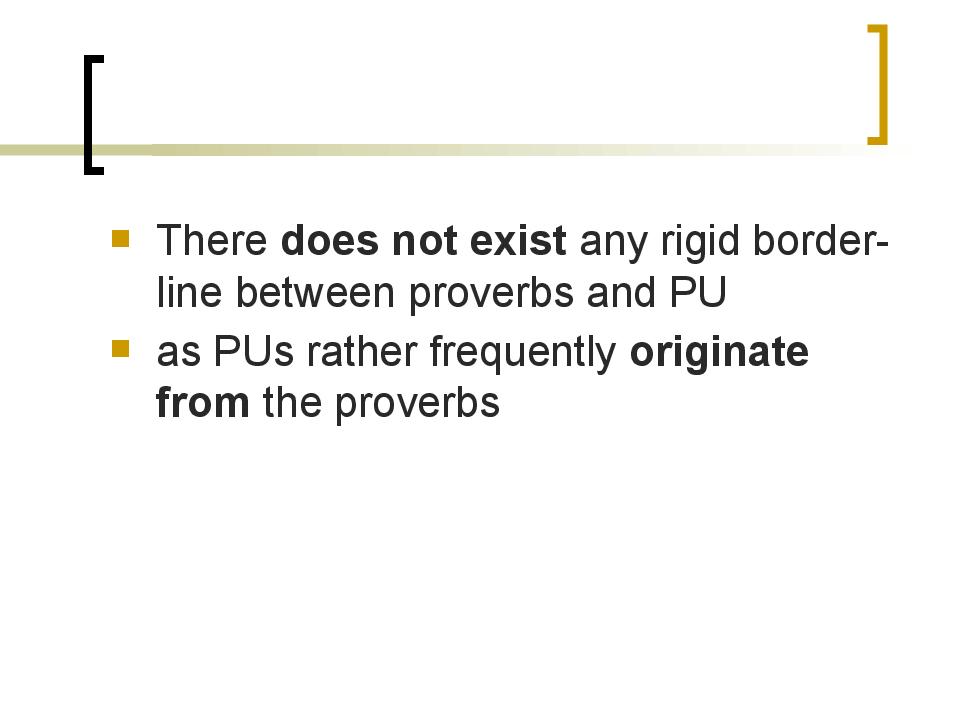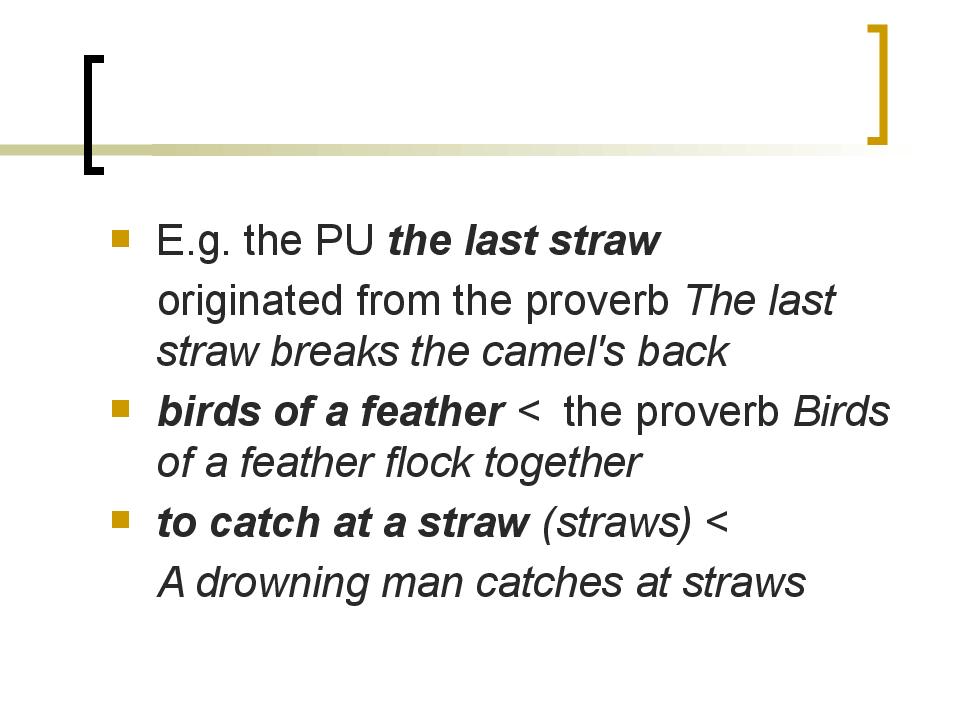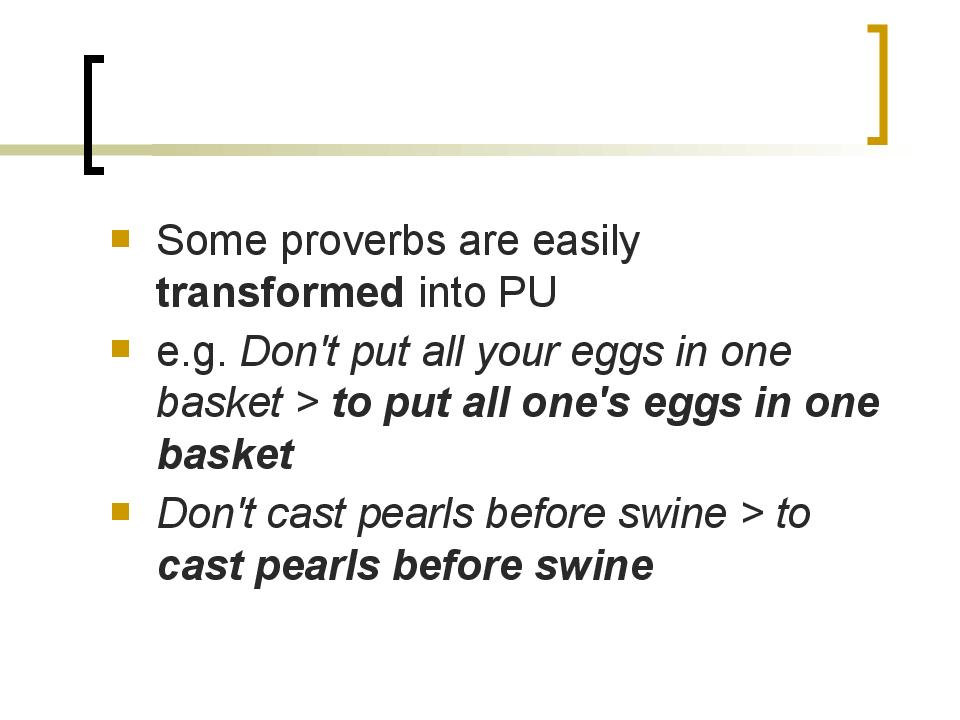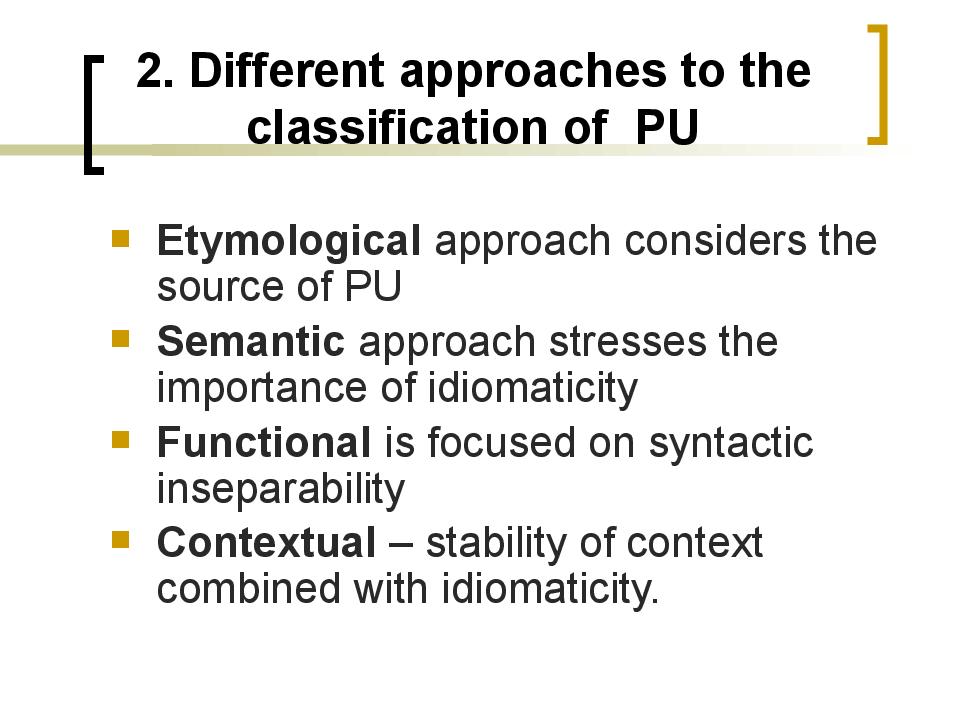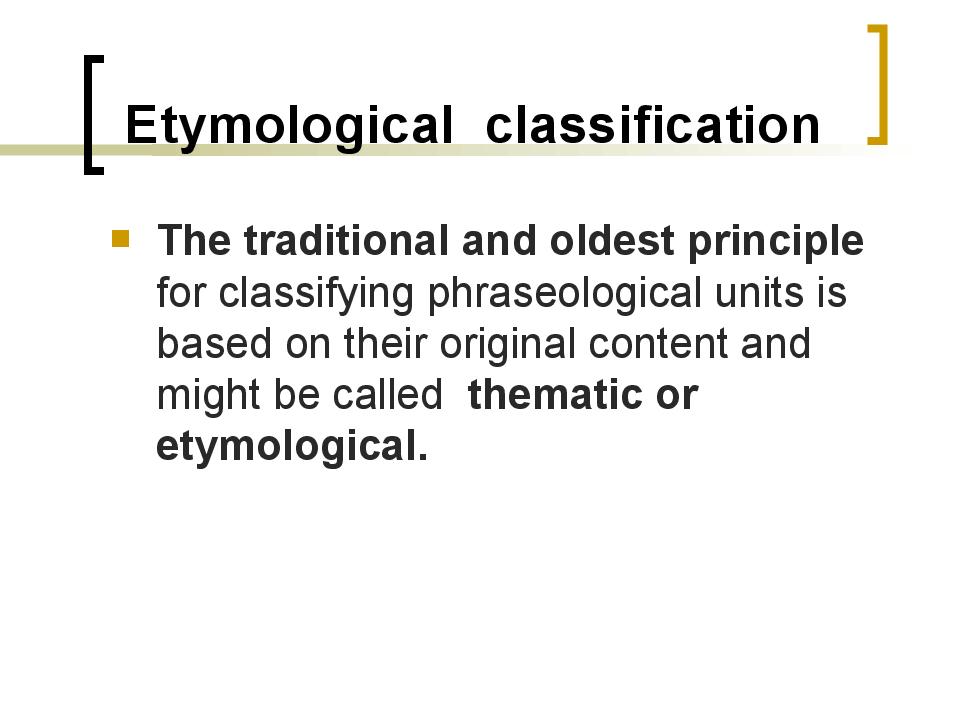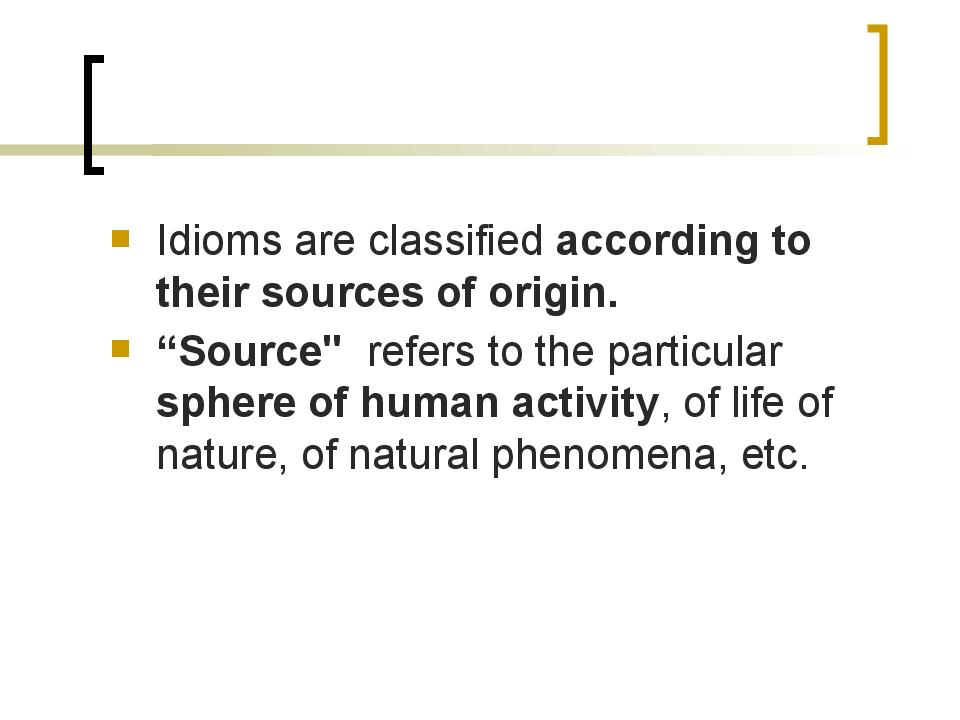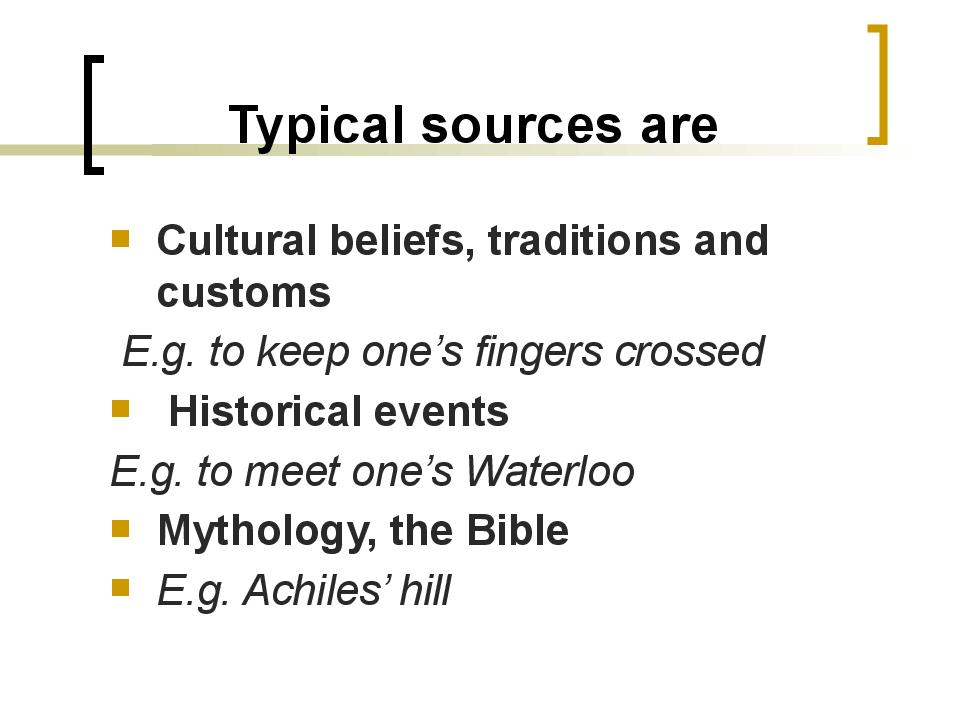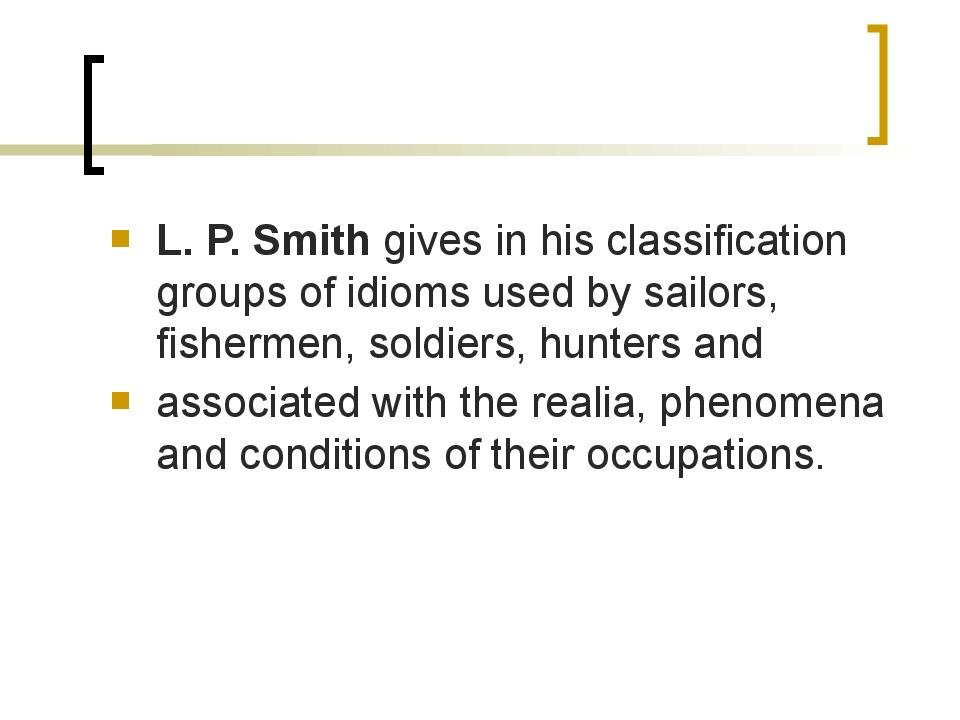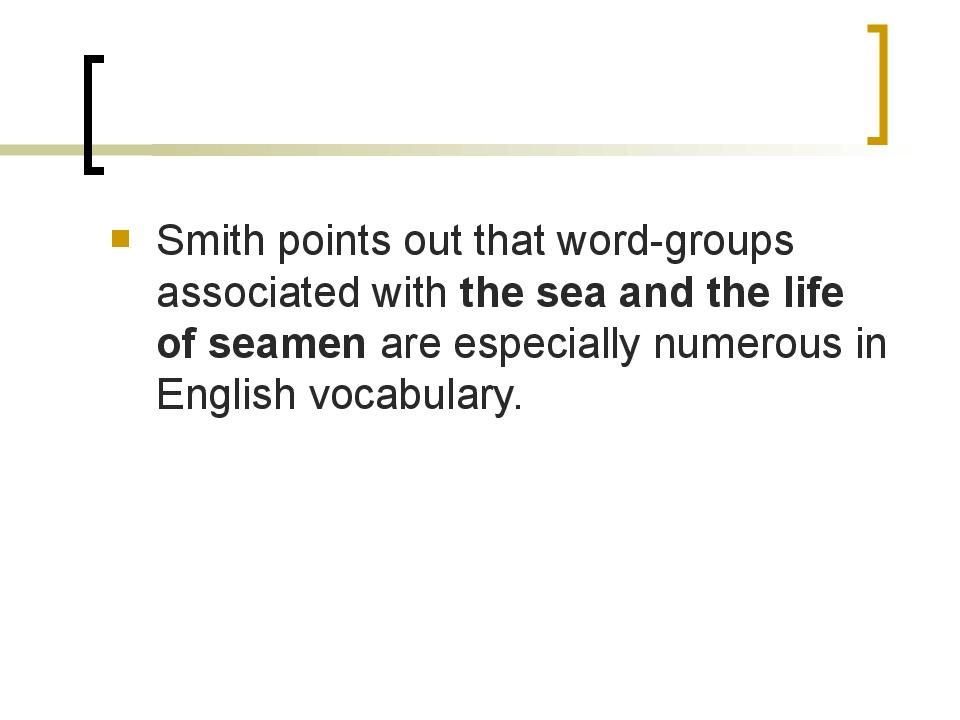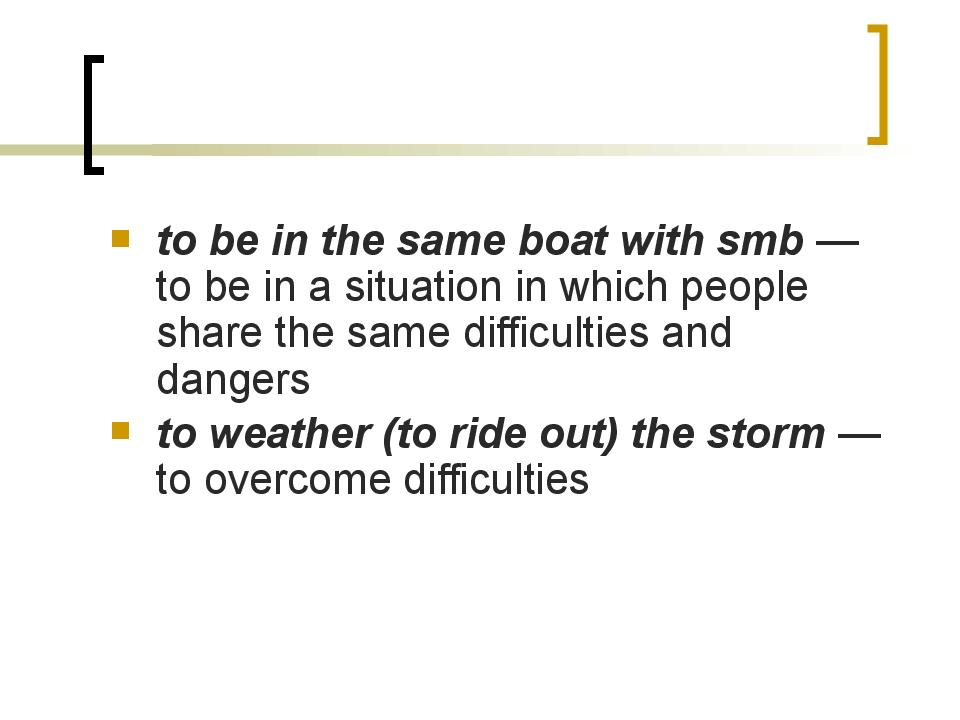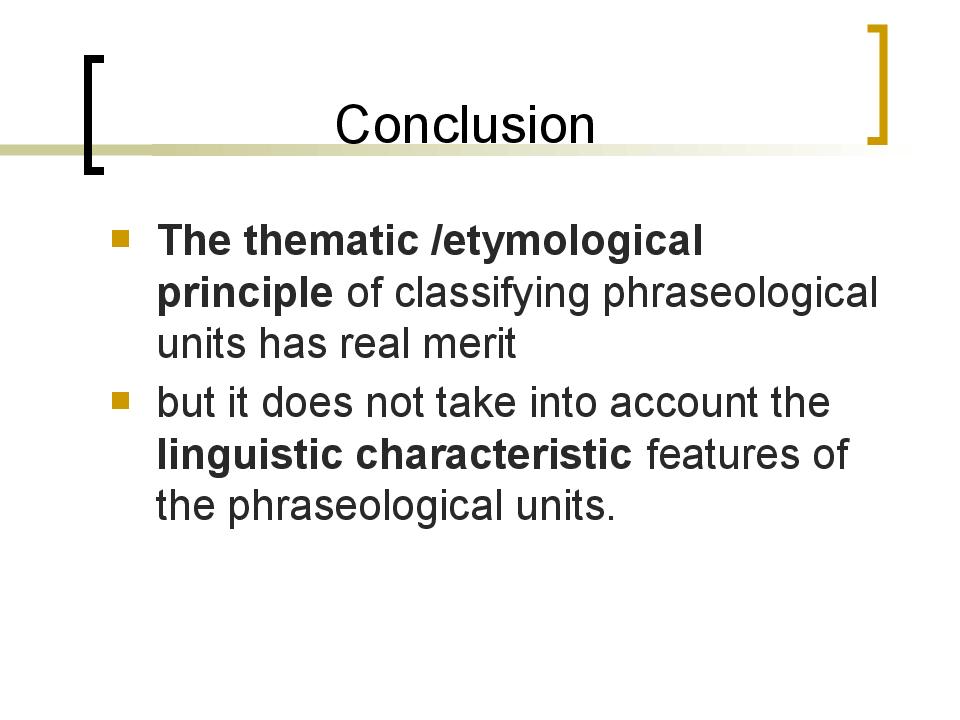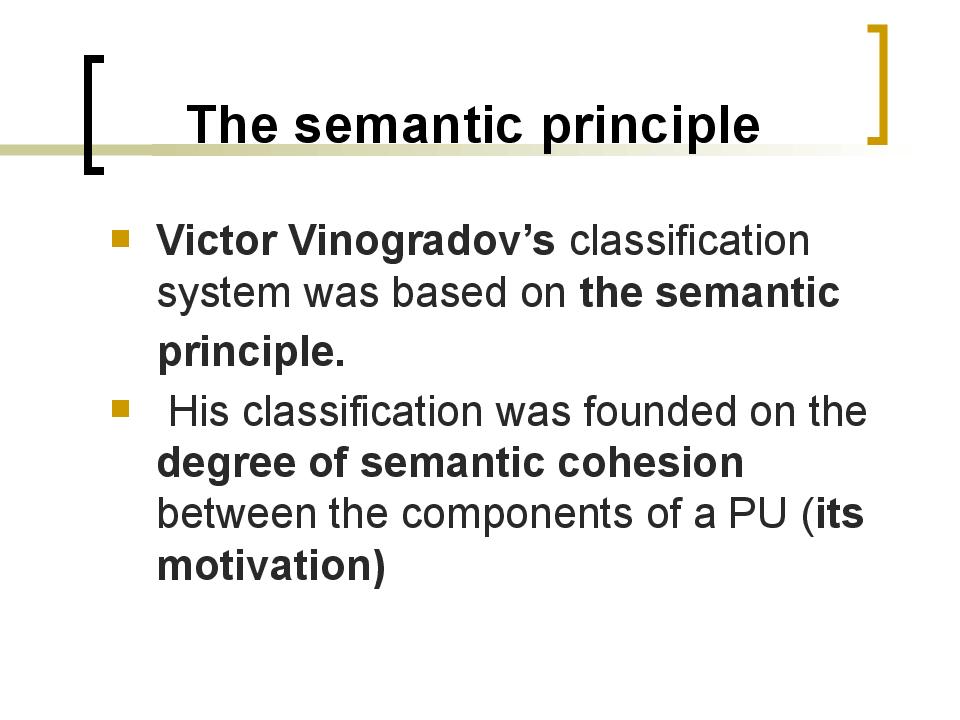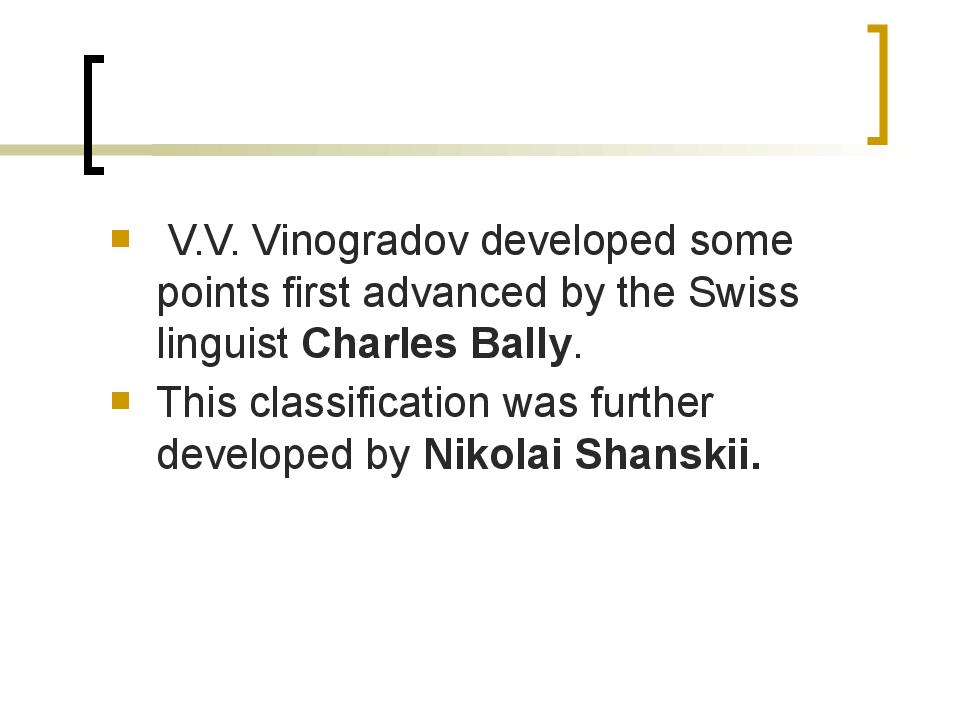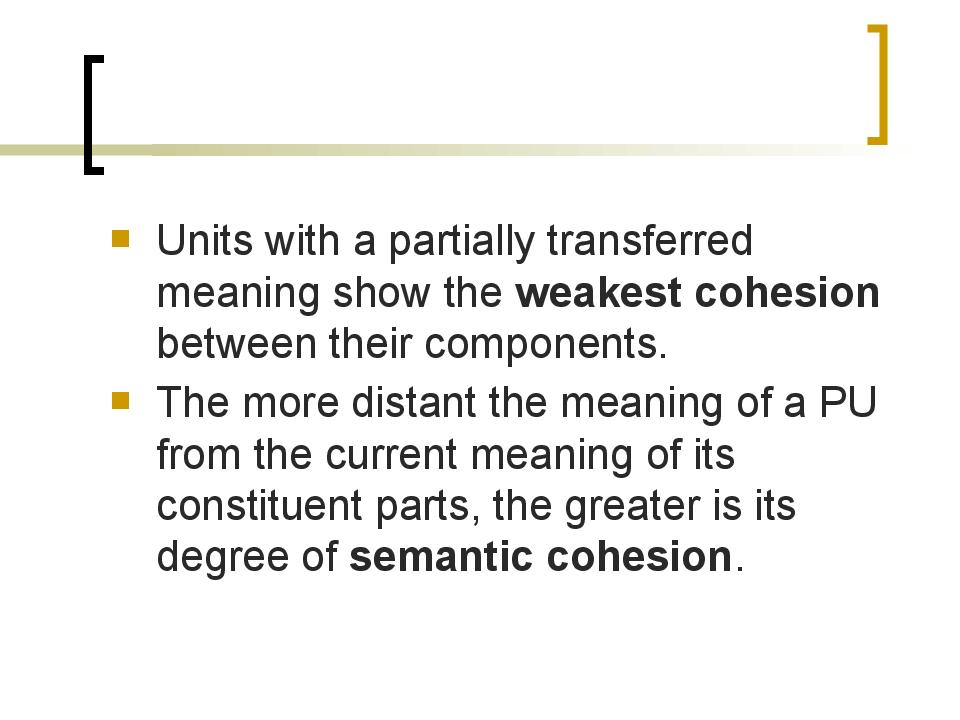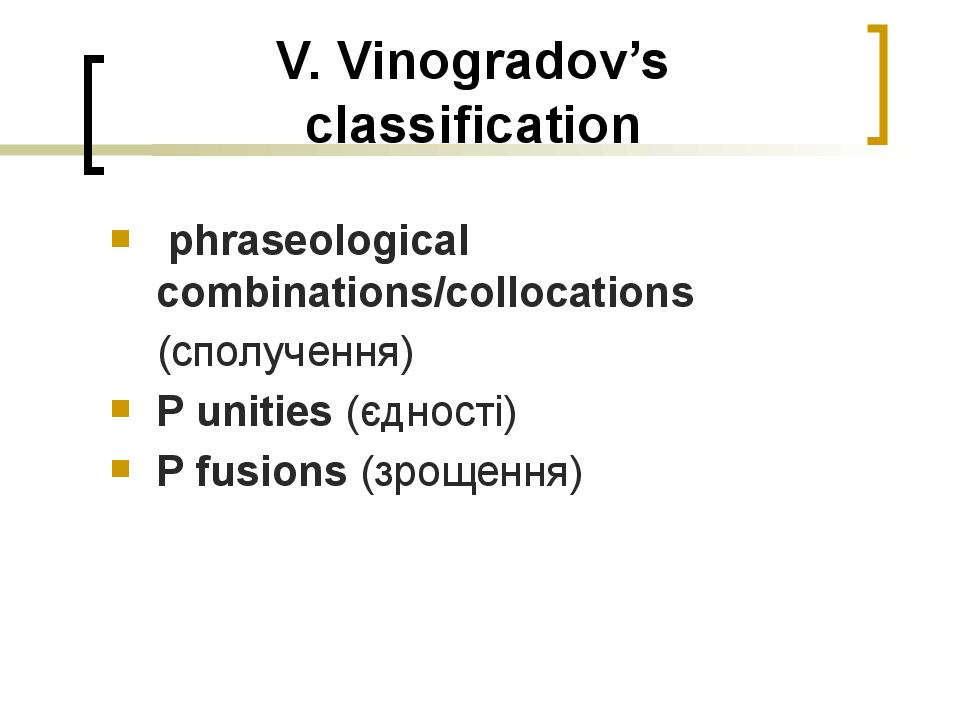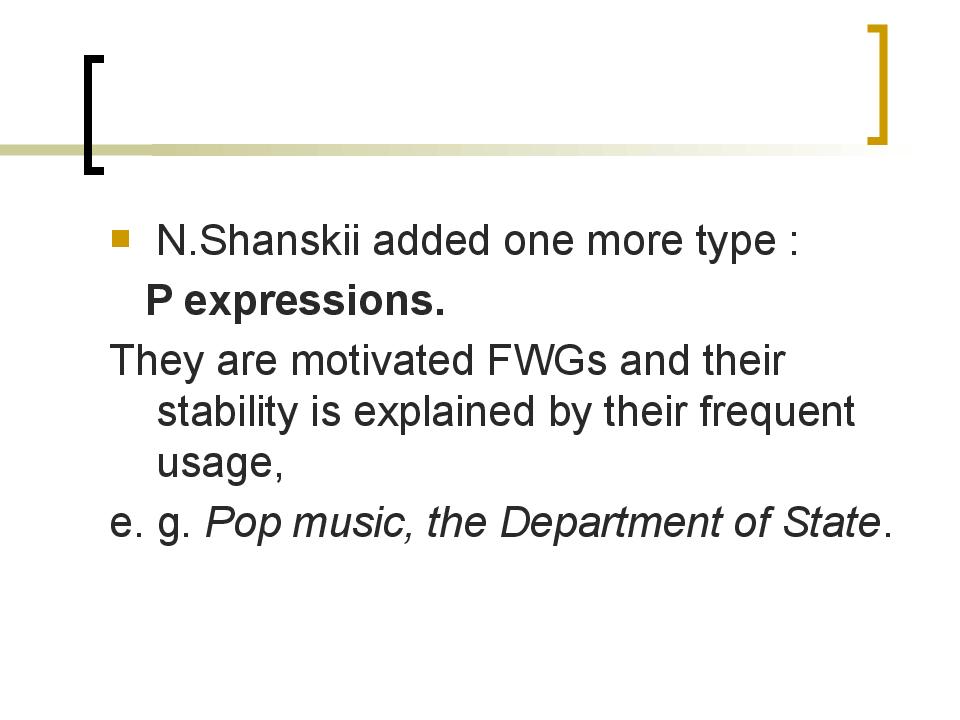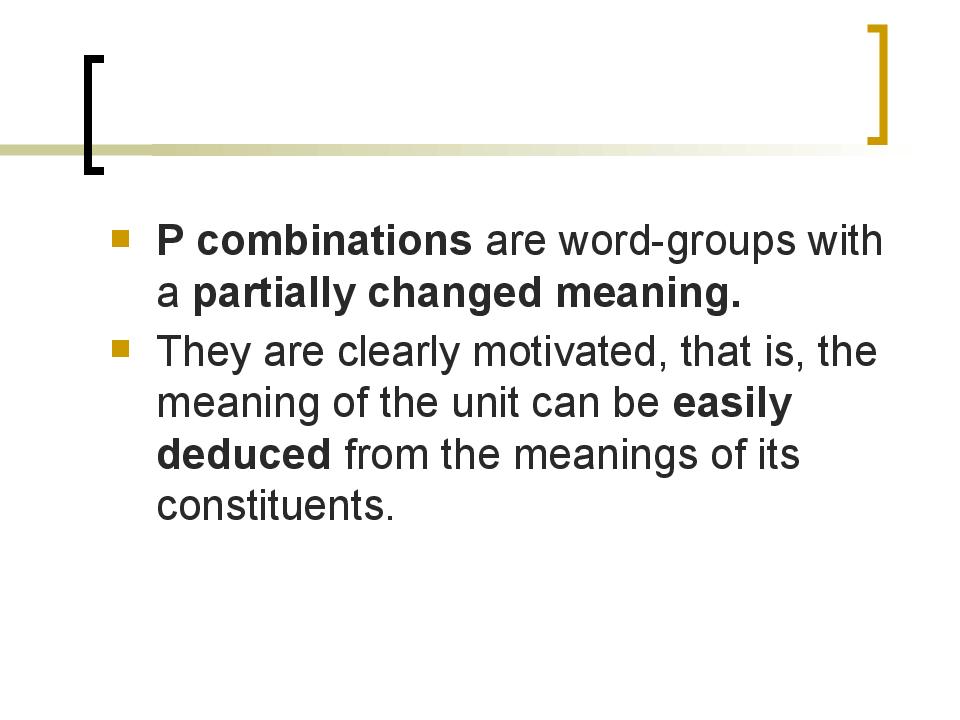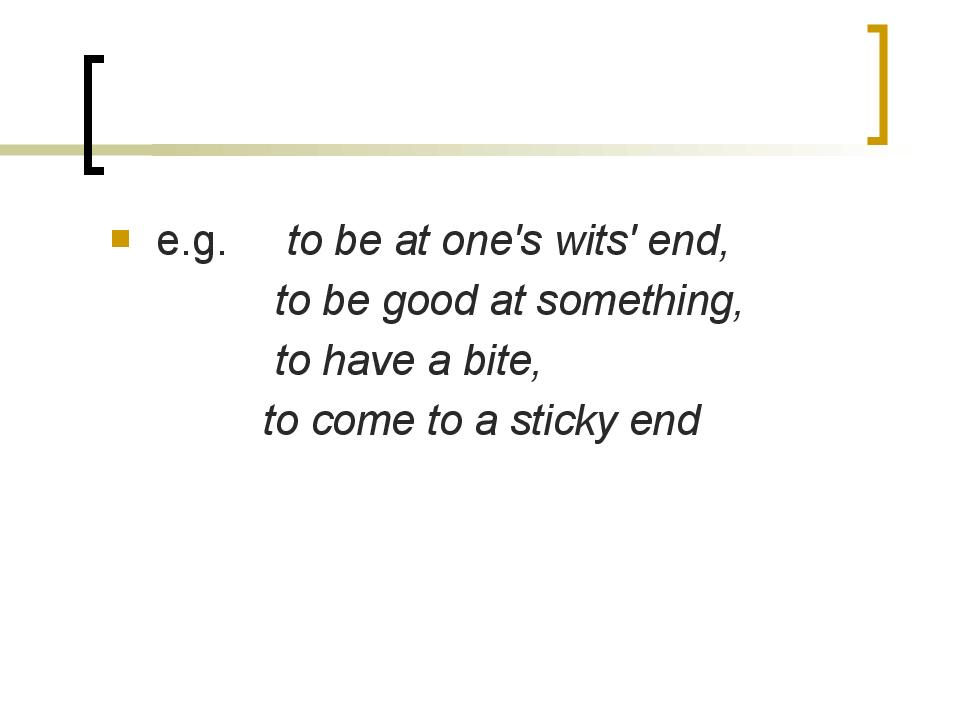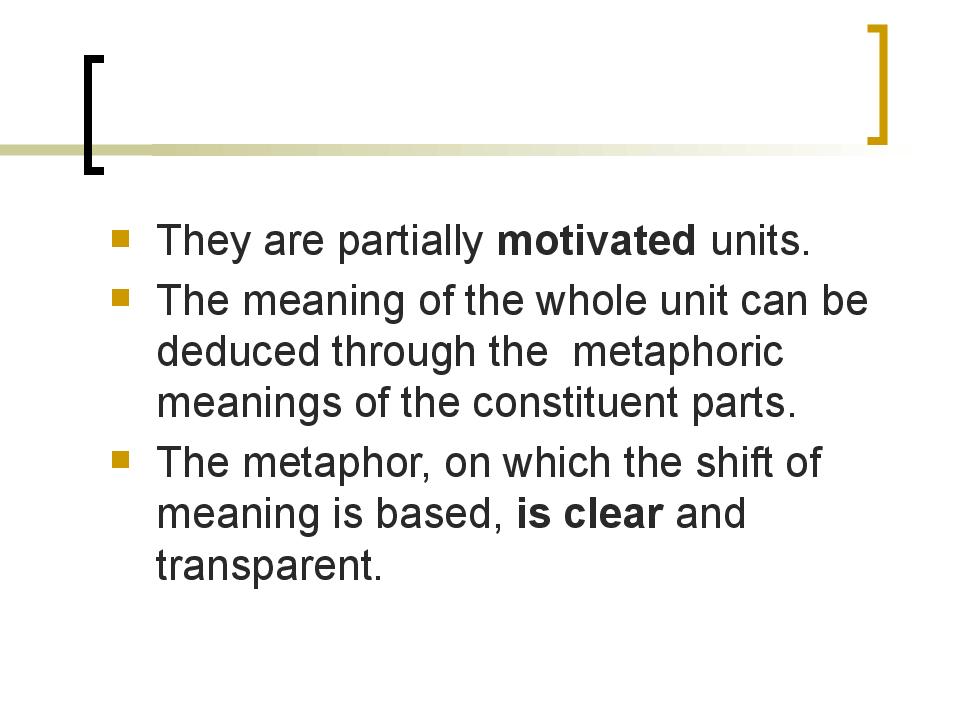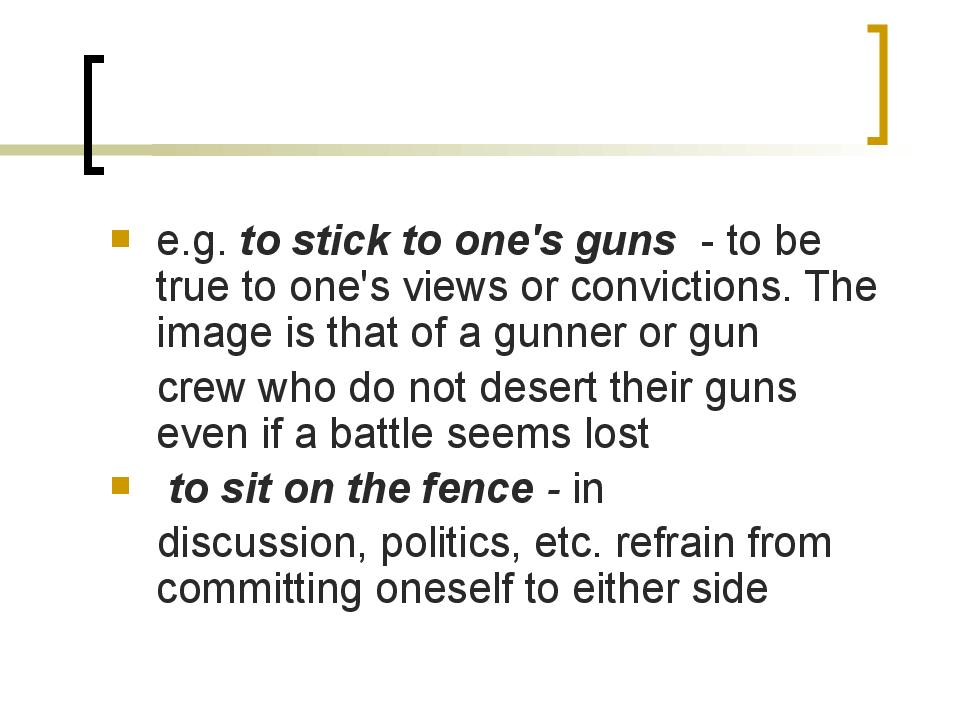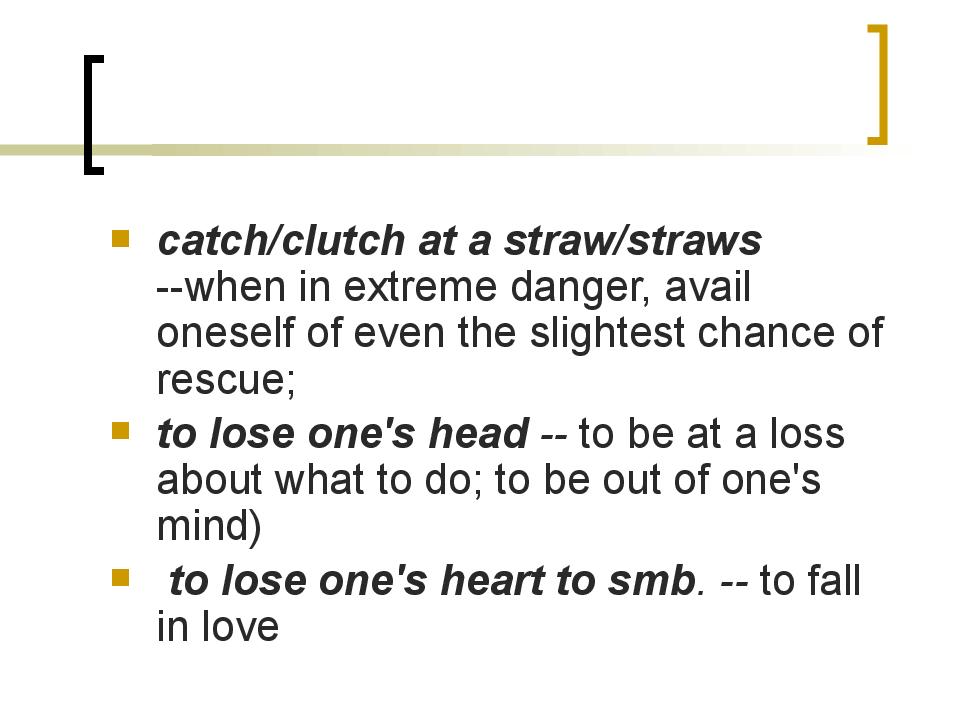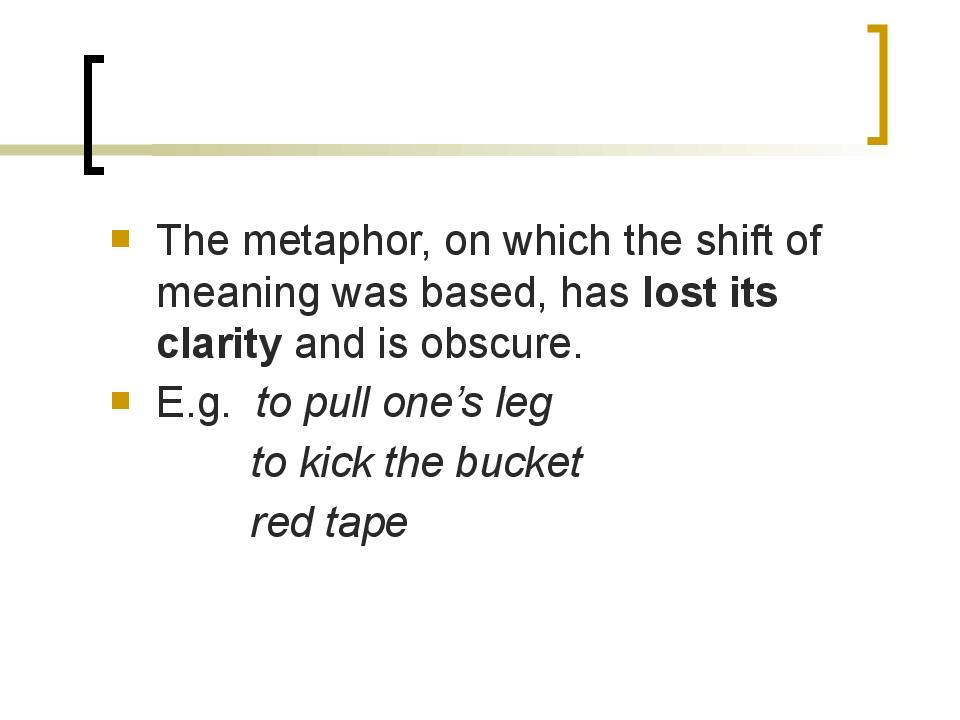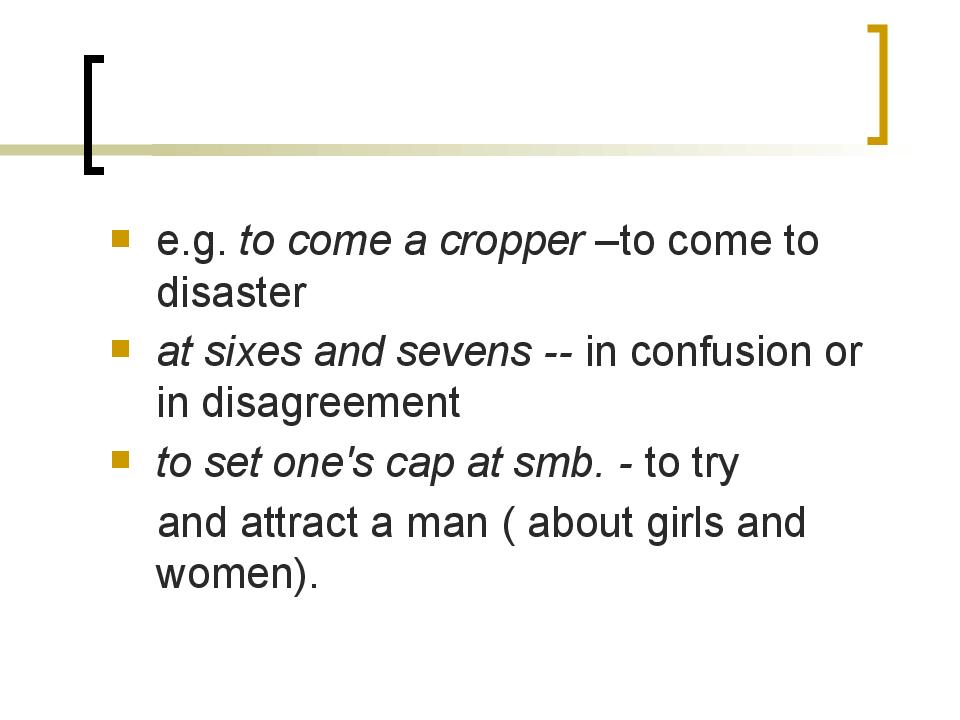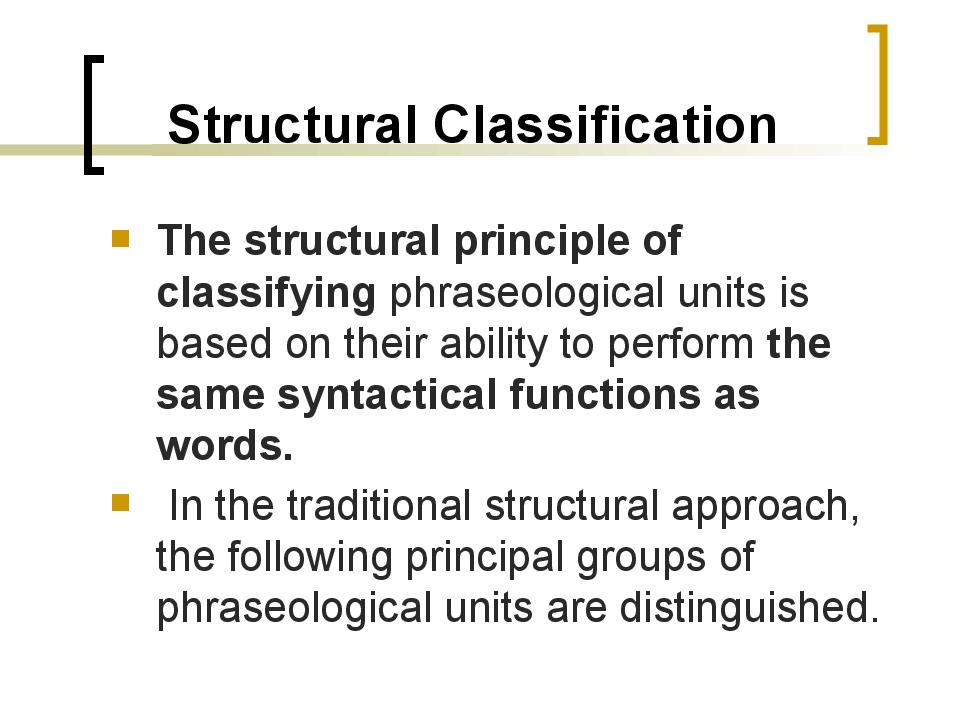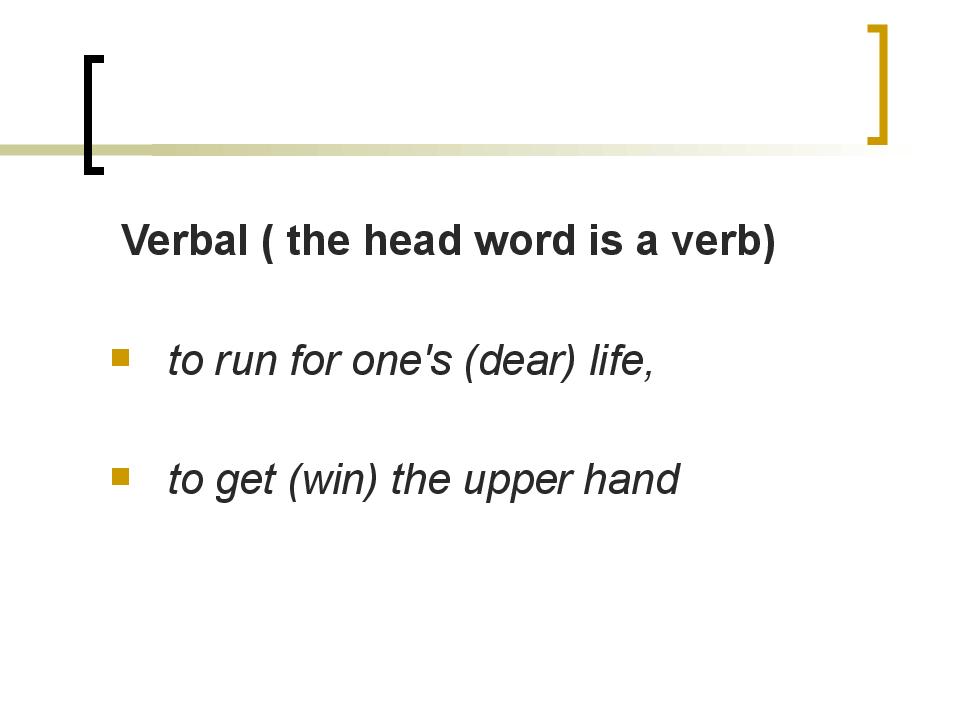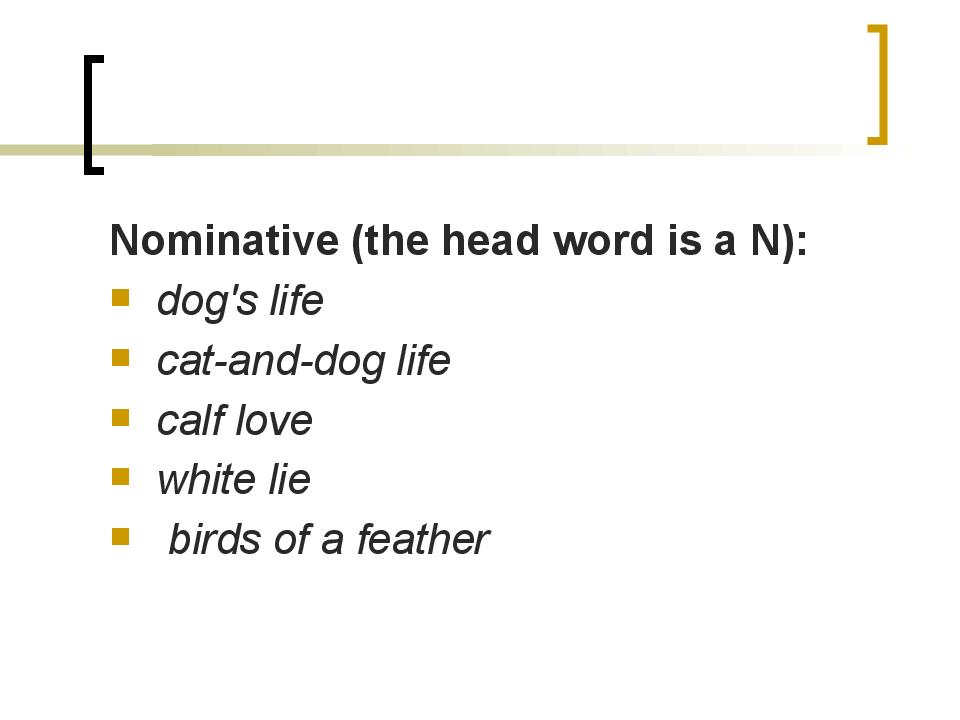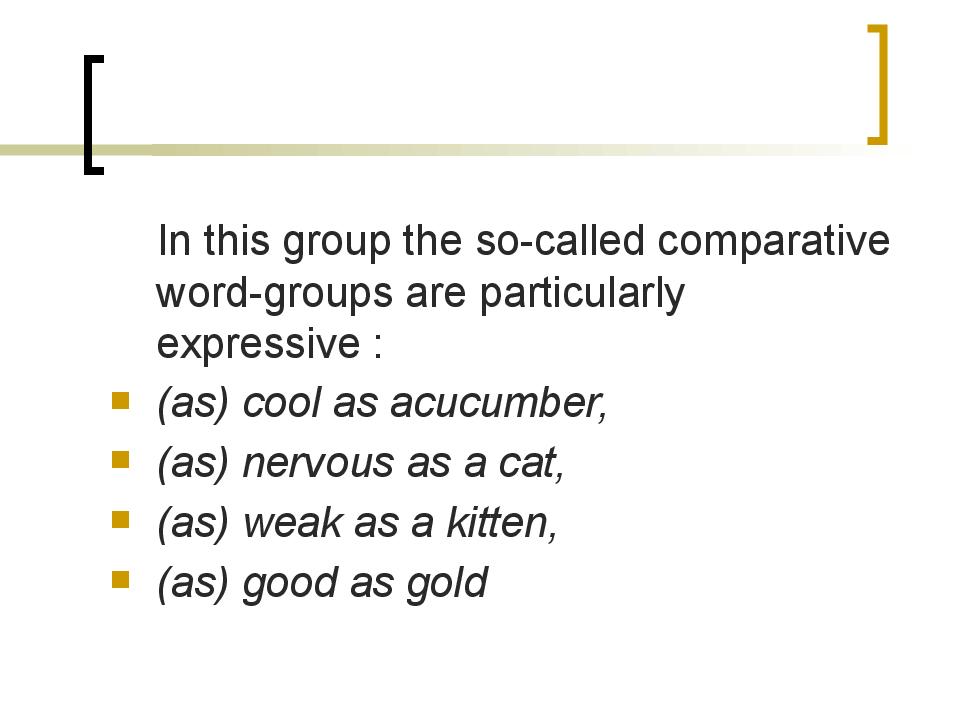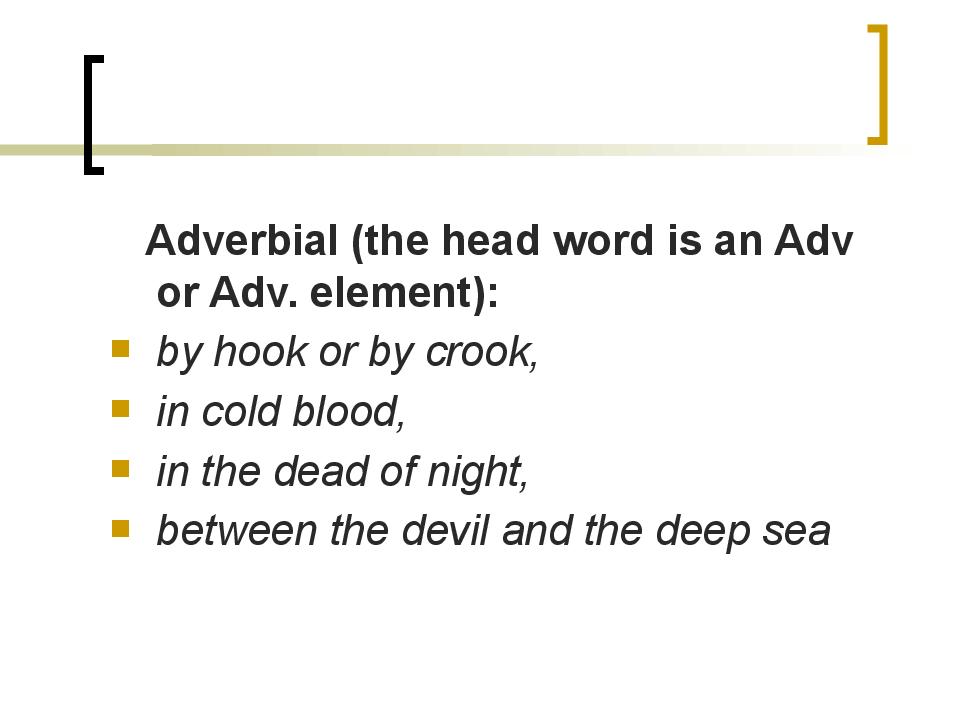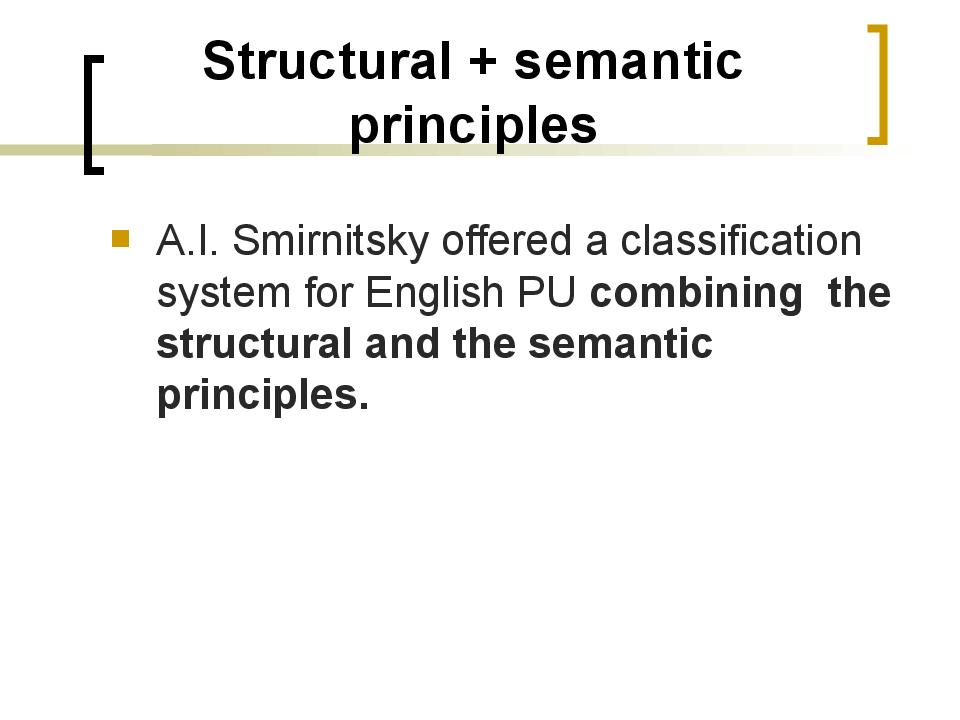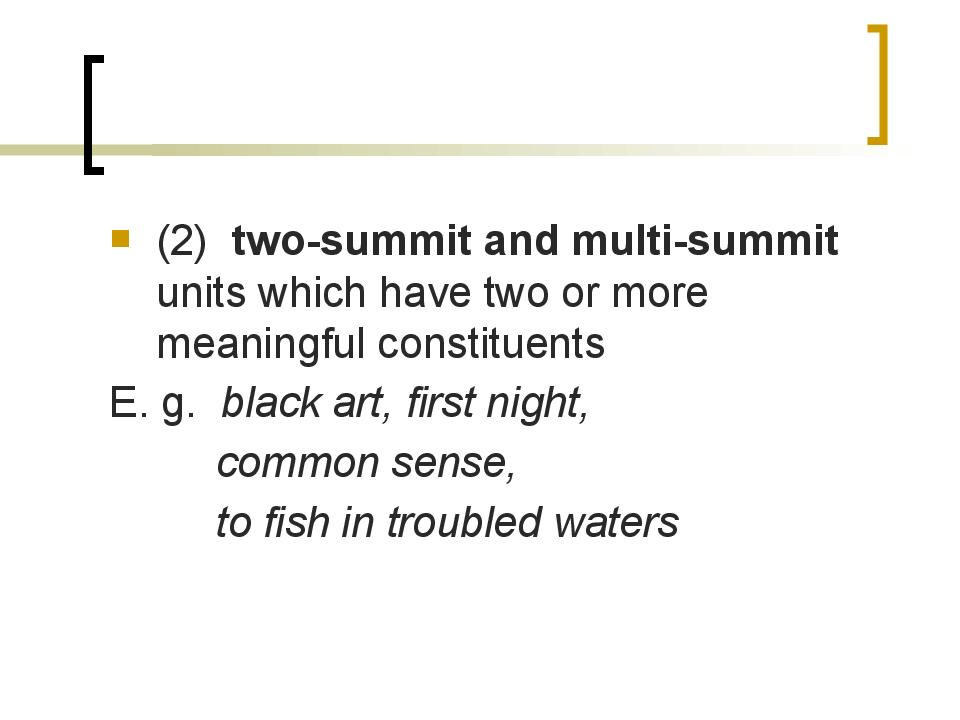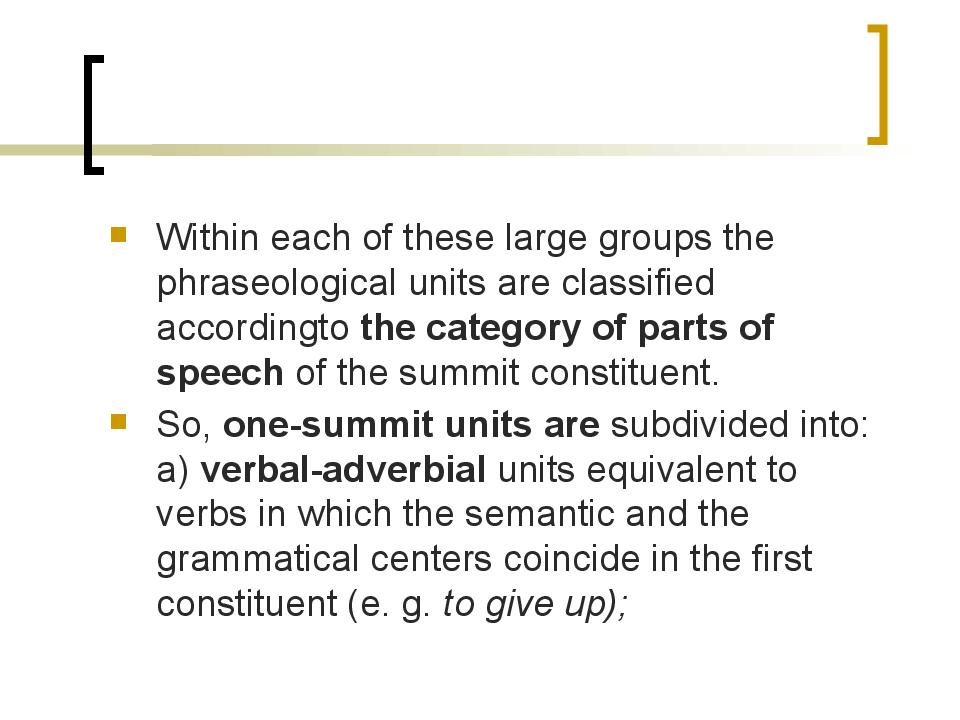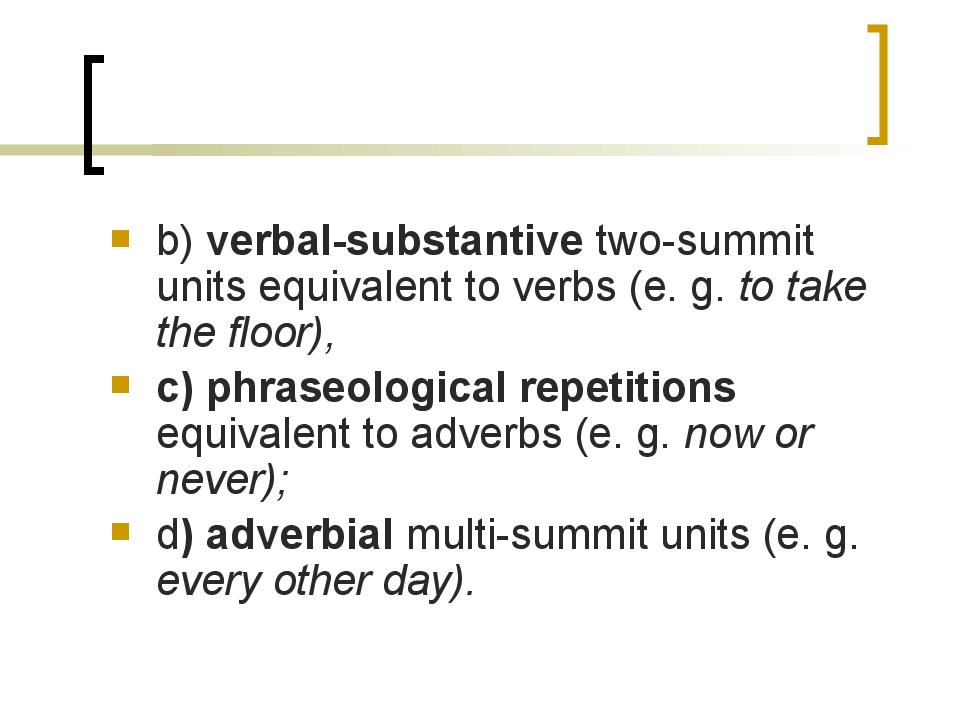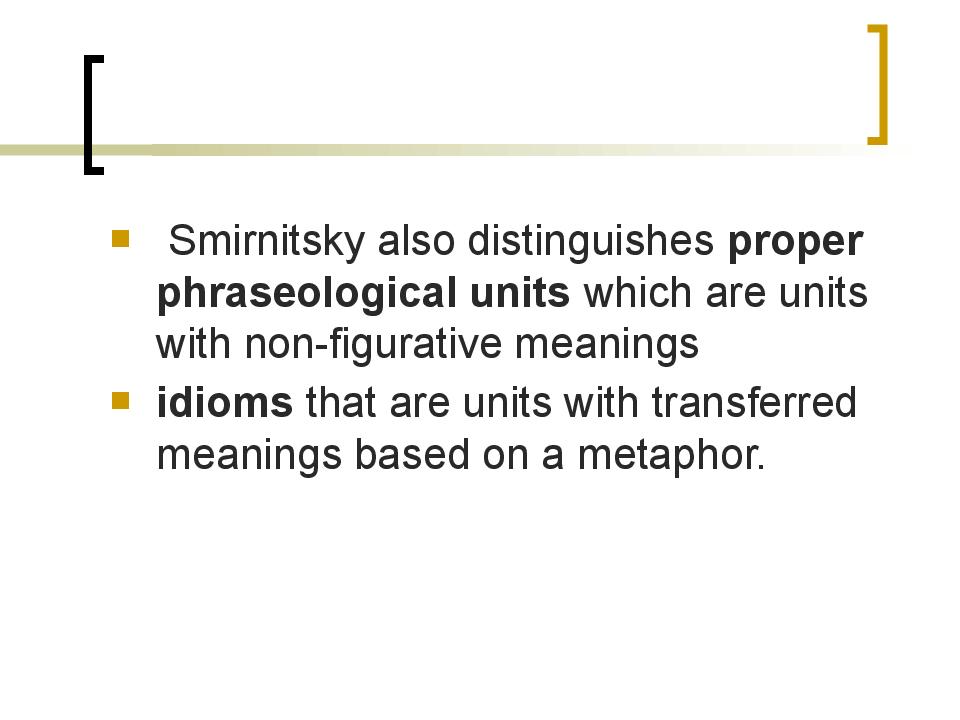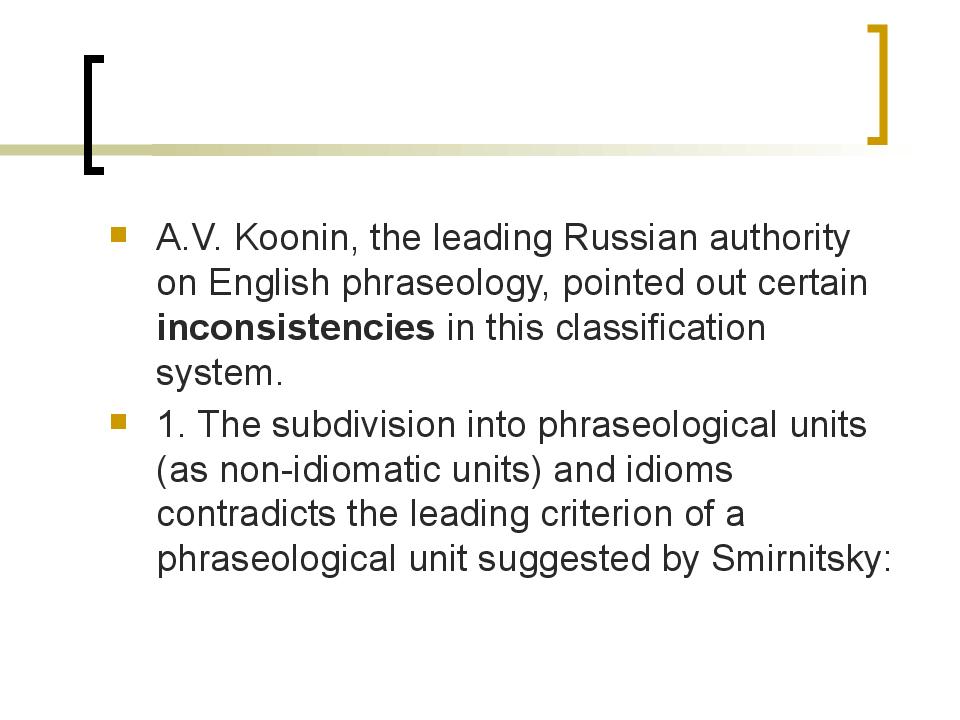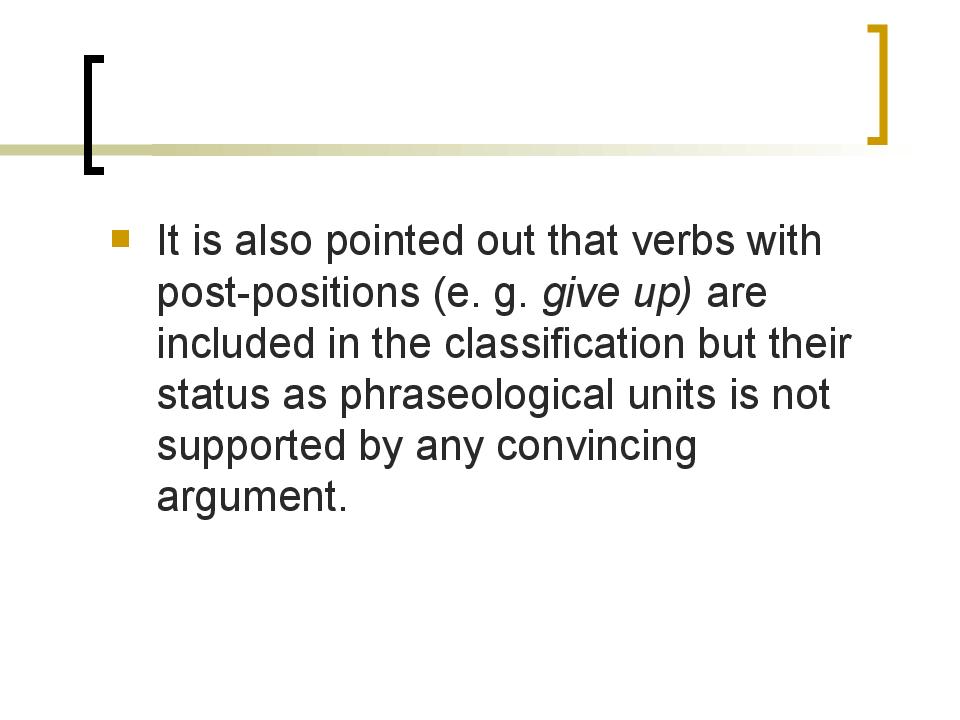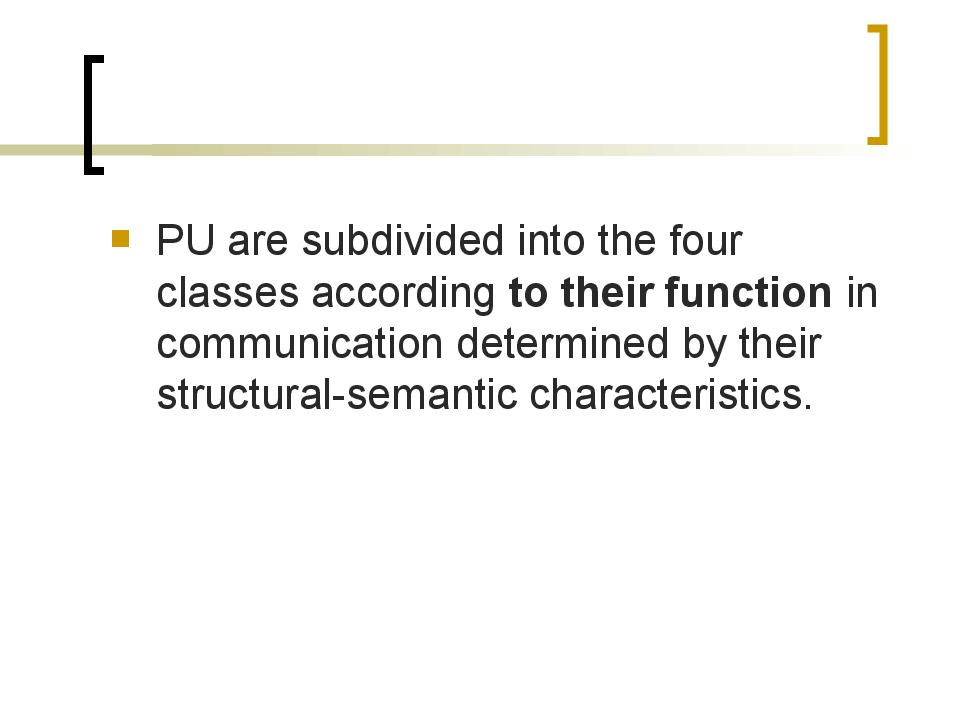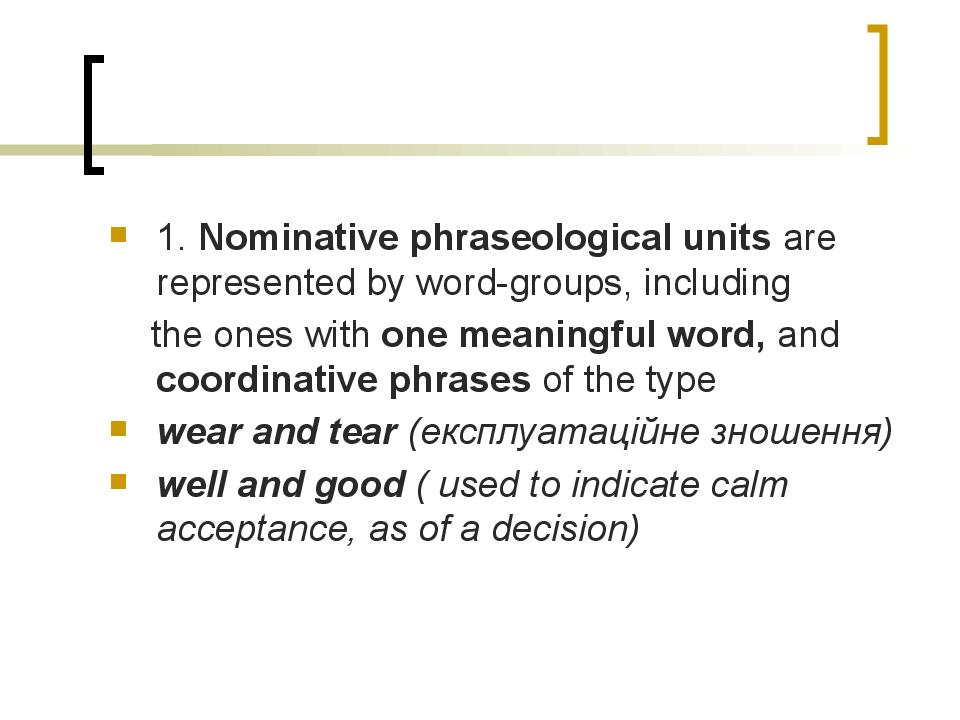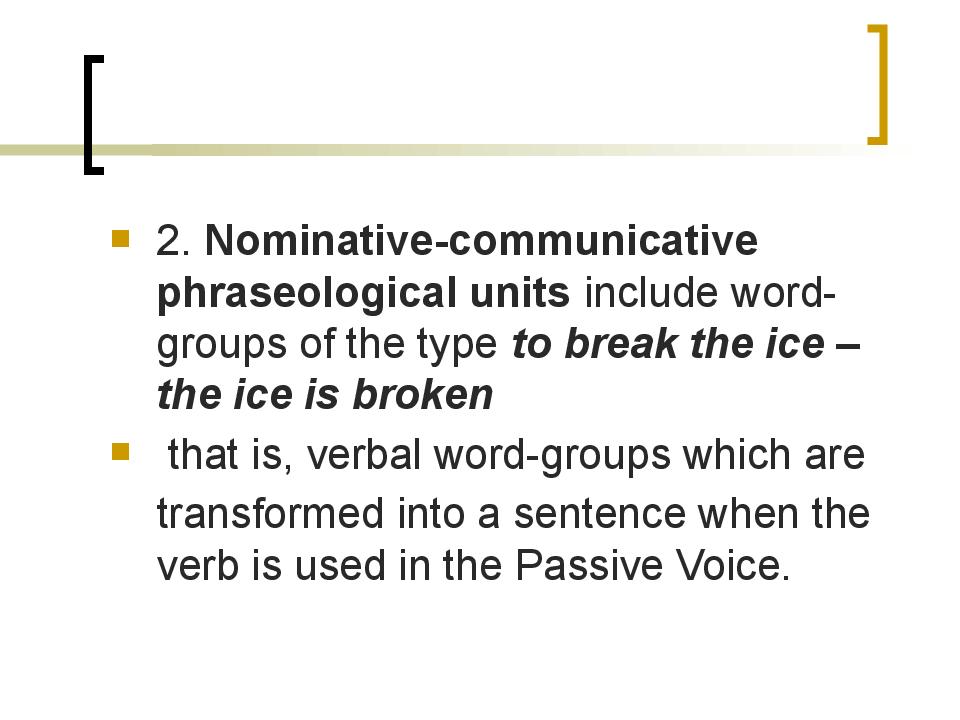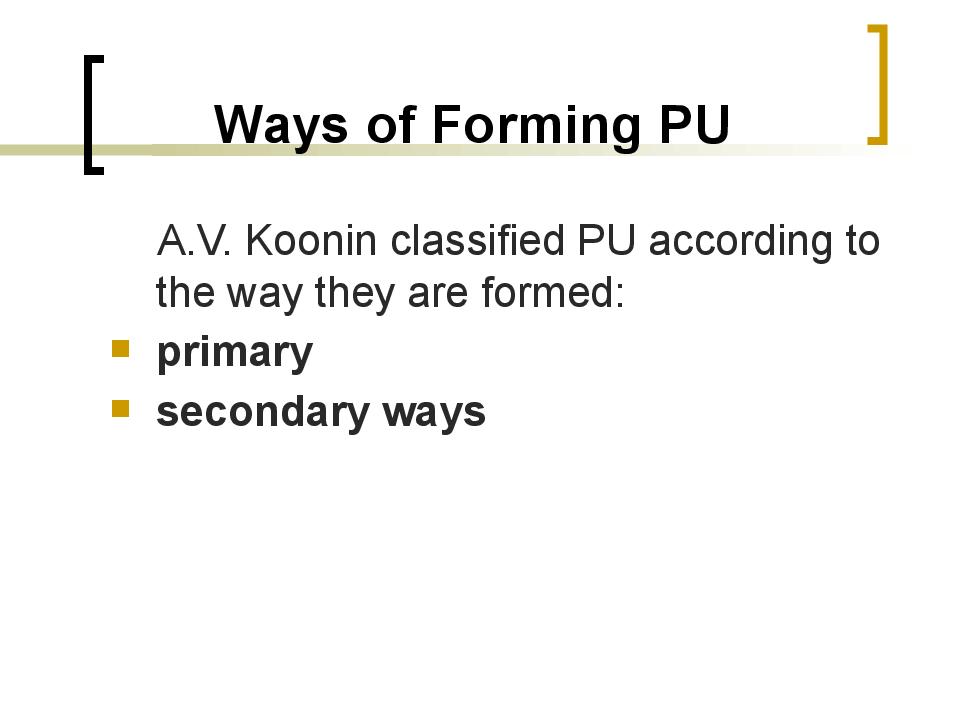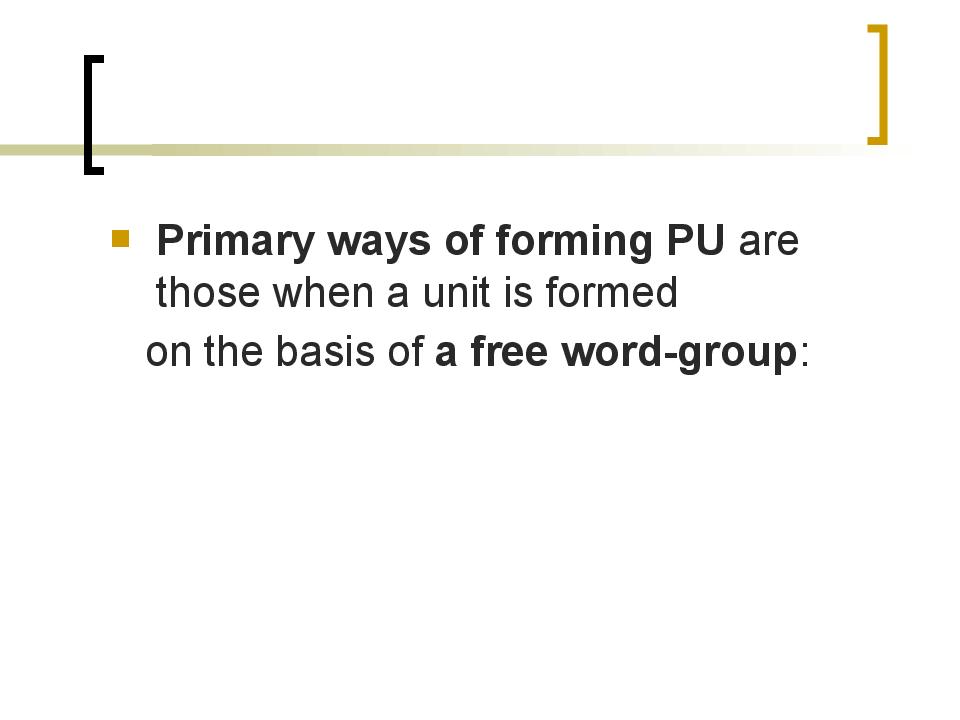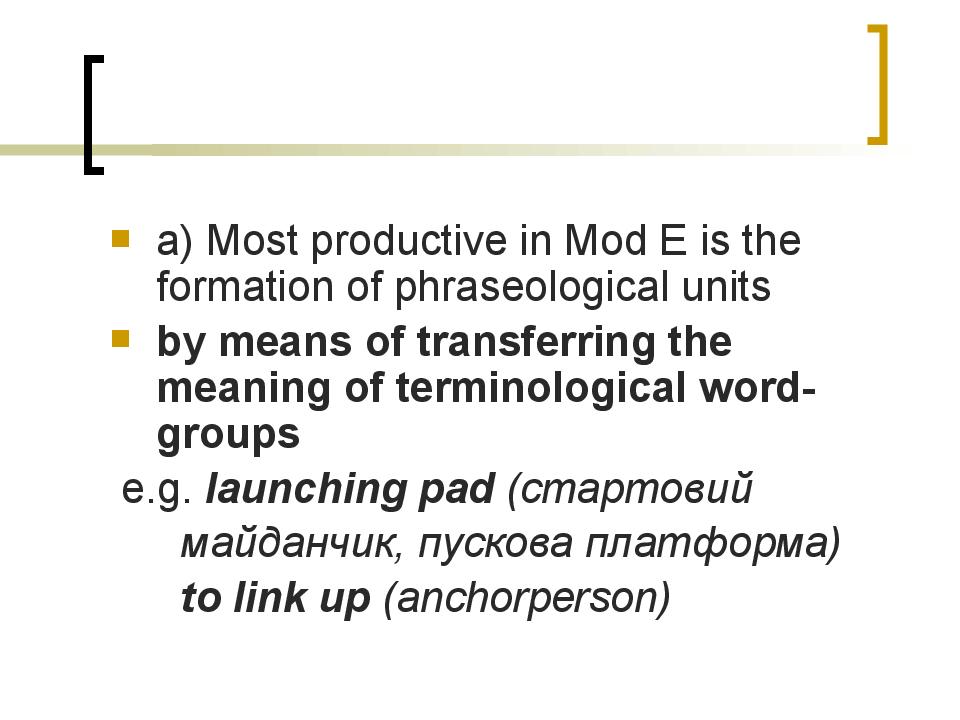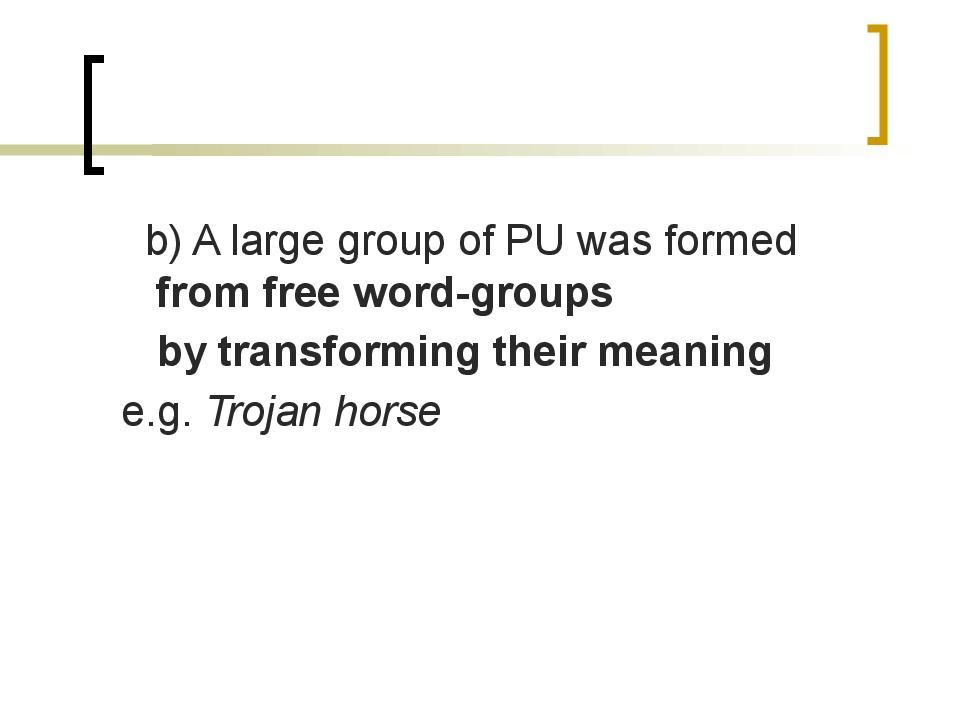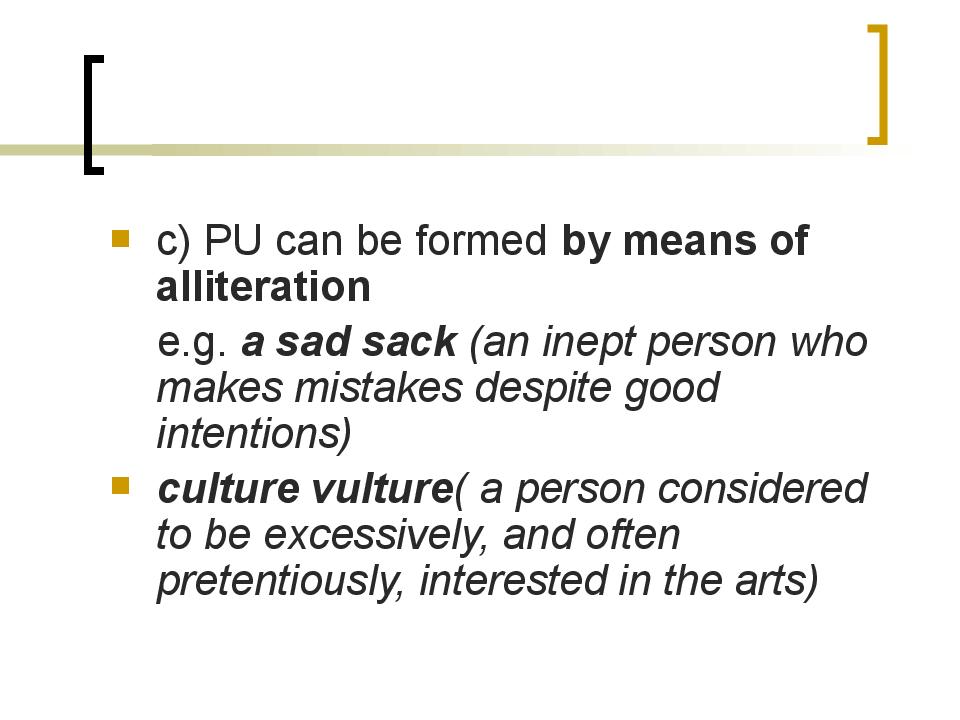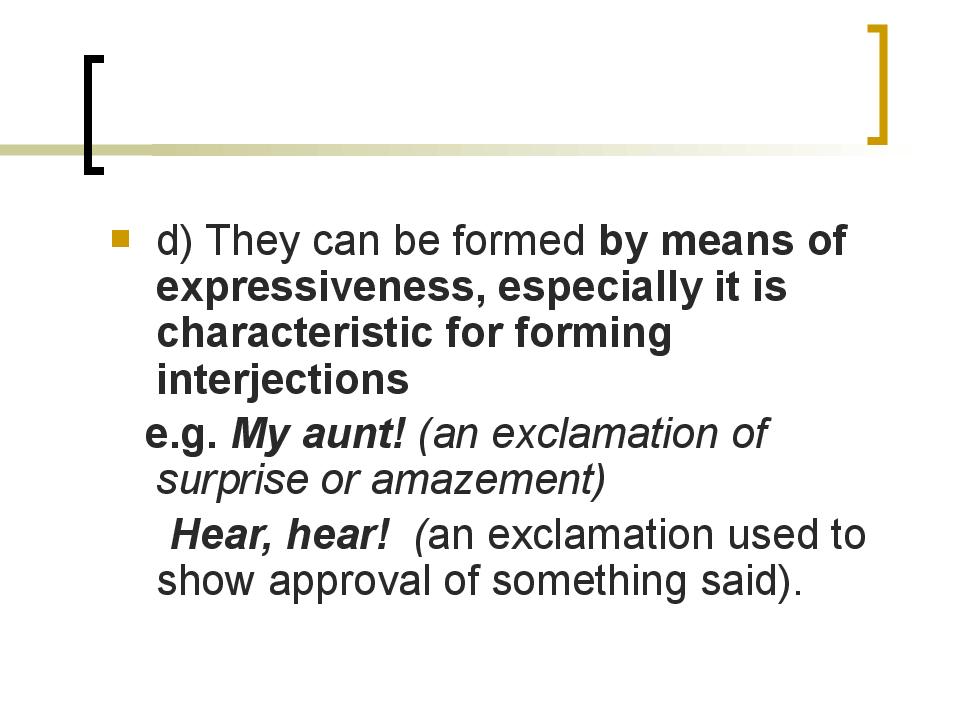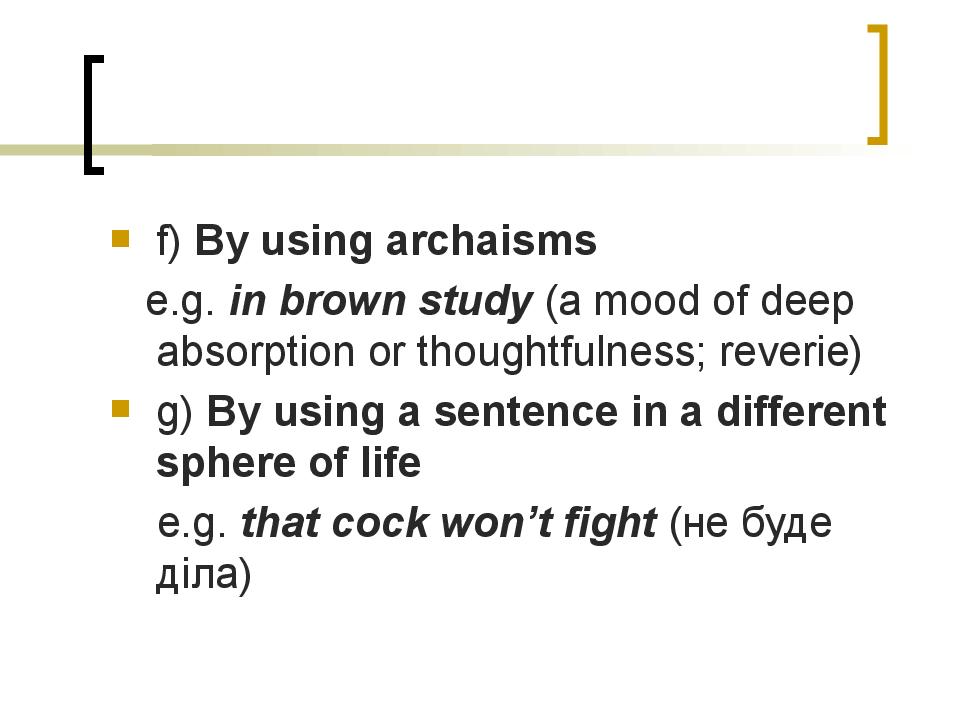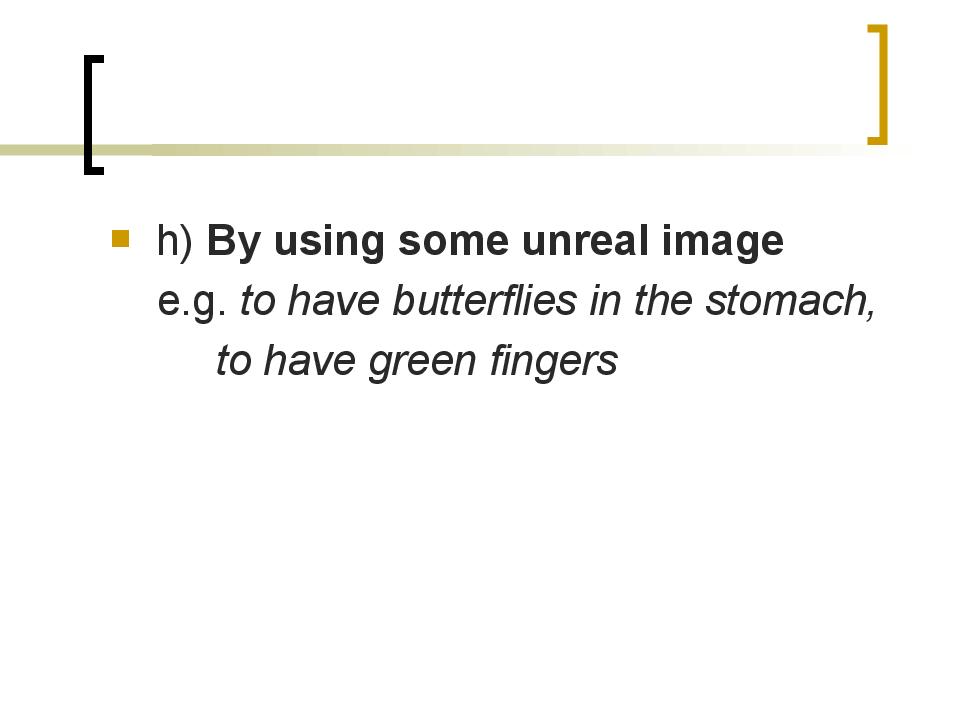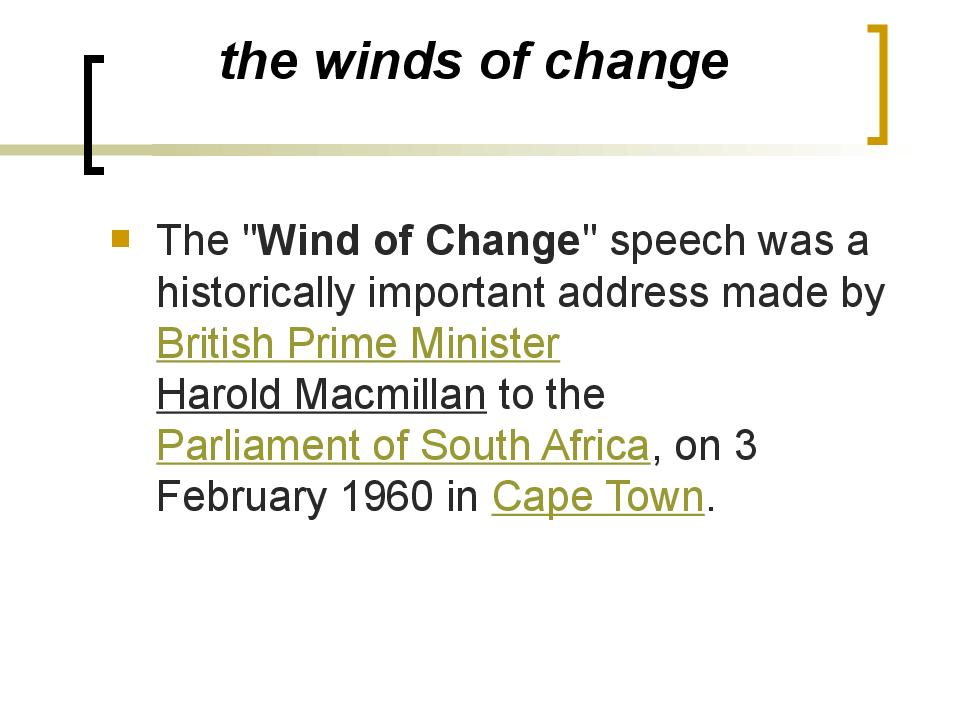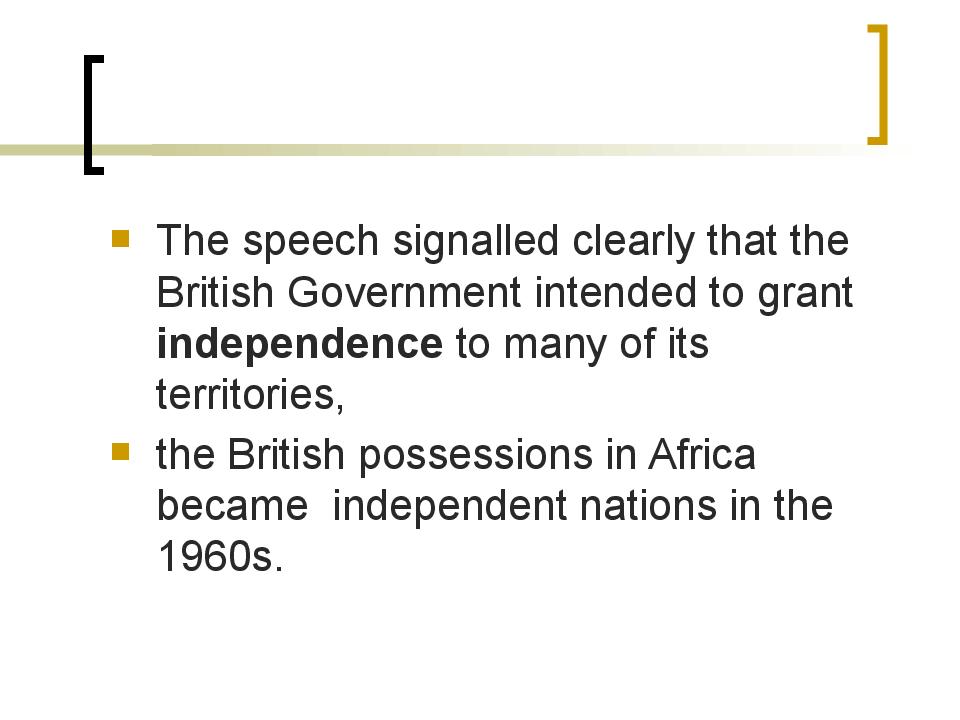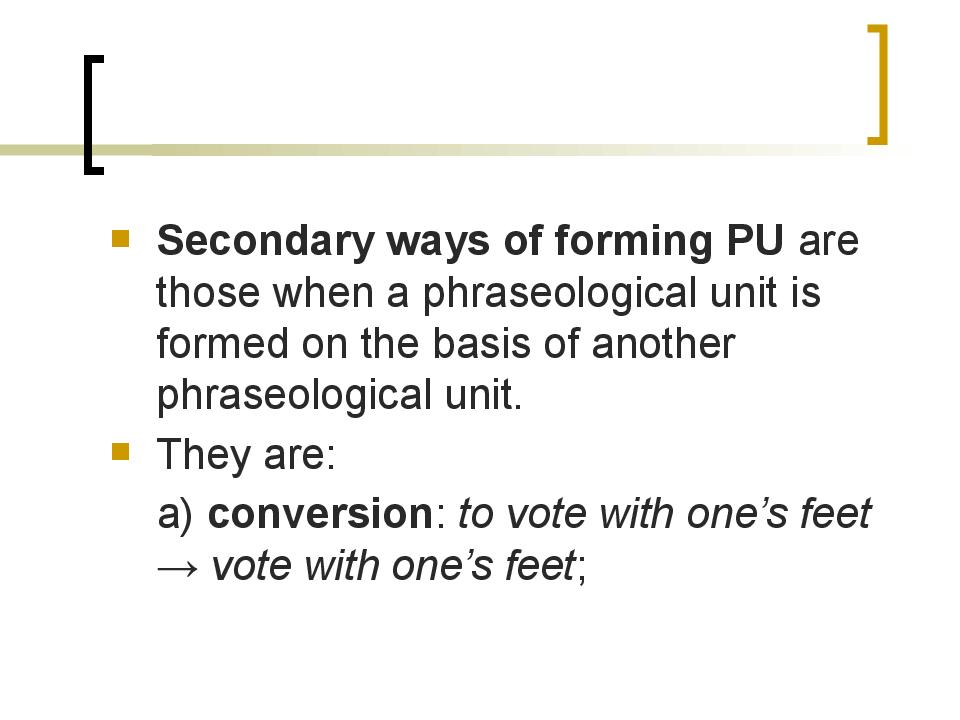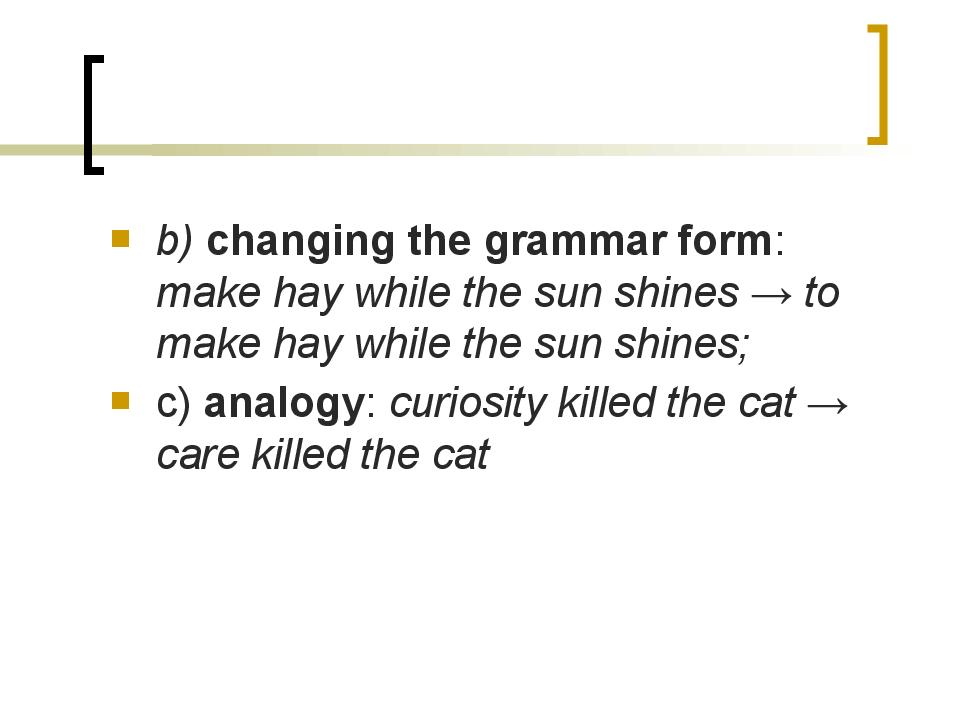Changeable
and
Unchangeable
Set Expressions
Every
utterance is a patterned, rhythmed and segmented sequence of
signals. On the lexical level these signals building up the utterance
arc
not exclusively words. Alongside with separate words speakers use
larger
blocks consisting of more than one word yet functioning as a whole.
These set expressions are extremely variegated structurally,
functionally,
semantically and stylistically. Not only expressive colloquialisms,
whether motivated like a
sight
for sore eyes and
to
know the ropes,
or
demotivated like tit
for fat, but
also terms like blank
verse, the
great vouel shift, direct object, political
cliches: cold
war, round-table
conference, summit meeting, and
emotionally and stylistically neutral
combinations: in
front of, as well as, a great deal, give up, etc.
ma}
be referred to this type. Even this short list is sufficient to show
1
For a concise summary formulation of all the moot points in this new
branch of
linguistics and a comprehensive bibliography the reader is referred
to the works of A.V.
Koonin.
166
that
the number of component elements, both notional and formal, varies,
and that the resulting units may have the distribution of different
parts of speech.
Set
expressions have sometimes been called «word equivalents»,
and
it has been postulated by A.I. Smirnitsky that the vocabulary of a
language consists of words and word equivalents (word-groups),
similar
to words in so far as they are not created in speech but introduced
into the act of communication ready-made. It is most important to
keep in mind that here equivalence means only this and nothing more.
Much
confusion ensues from taking equivalence too literally. It does not
concern us at thisstagewhether word equivalents have other features
similar
to those of words although we naturally hope that being guided
by the most important primary feature we shall obtain in its wake
important
secondary characteristics. That is, we have reason to expect that at
least some of the units will show indivisibility, express one
action, and function as one member of the sentence, but in
selecting the units we shall not take these secondary characteristics
into consideration.
Go
off ‘to
explode’ and similar constructions form a boundary set of
phrasal verbs described in the chapter of compounds. The above
approach
is not the only one possible, but it meets the demands of applied
linguistics,
especially foreign language teaching and information retrieval.
In both fields set expressions form a section of the vocabulary which
has to be set apart and learned or introduced to pupils and into the
«memory» of machines as whole stereotype groups of words.
The integration
of two or more words into a unit functioning as a whole with a
characteristic unity of nomination (bread
and butter =j=
butter
and bread) is
chosen for the fundamental property, because it seems to permit
checking
by a rigorous enough linguistic procedure, namely, by the
substitution
test.
Set
expressions are contrasted to free
phrases
and semifixed
combinations.
All
these are but different stages of restrictions
imposed upon co-occurrence of words, upon the lexical filling of
structural patterns
which
are specific
for
even’ language. The restrictions
may be independent of the ties existing in extra-linguistic reality
between the objects spoken of and be conditioned by purely
linguistic
factors, or have extra-linguistic causes in the history of the
people.
In free combinations the linguistic factors are chiefly connected
with
grammatical properties of words.
A
free phrase such as to
go early permits
substitution of any of its elements
without semantic change in the other element or elements. The
verb go
in
free phrases may be preceded by any noun or followed by any
adverbial. Such substitution is, however, never unlimited.
In
semi-fixed combinations we are not only able to say that such
substitutes
exist, but fix
their boundaries by stating the semantic properties
of words that can be used for substitution, or even listing them.
That
is to say, in semi-fixed combinations these lexico-semantic limits
are manifest in restrictions imposed upon types of words which can
be used in a given pattern. For example, the pattern consisting of
the
verb go
followed
by a preposition and a noun with no article before
167
it
(go
to school, go to market, go to courts, etc.)
is used only with nouns of
places where definite actions or functions are performed.
If
substitution is only pronominal, or restricted to a few synonyms for
one of the members only, or impossible, i.e. if the elements of the
phrase
are always the same and make a fixed context for each other, the
word-group is a set
expression.
No
substitution of any elements whatever is possible in the following
stereotyped (unchangeable) set expressions, which differ in many
other respects: all
the world and his wife, the man in the street, red tape, calf love,
heads or tails, first night, to gild the pill, to hope for the best,
busy as
a bee, fair and square, stuff and nonsense, time and again, to and
fro. These
examples represent the extreme of restrictions defined by
probabilities
of co-occurrence of words in the English language. Here
_no_yari-ztion
and no substitution is possible, because it would destroy the
meaning or the euphonic and expressive qualities of the whole.
Many of these expressions
are also interesting from the viewpoint of their informational
characteristics, i.e. the sum total of information contained in the
word-group
including expressiveness and stylistic and emotional colouring
is created by mutual interaction of elements. The expression red
tape, for
instance, as a derogatory name for trivial bureaucratic formalities
originates in the old custom of Government officials and lawyers
tying
up their papers with red tape. Heads
or tails comes
from the old custom
of deciding a dispute or settling which of two possible alternatives
shall be followed by tossing a coin.
In a free
phrase the semantic correlative ties are fundamentally different.
The information is additive and each element has a much greater
semantic independence. Each component may be substituted without
affecting
the meaning of the other: cut
bread, cut cheese, eat bread. Information
is additive in the sense that the amount of information we had on
receiving the first signal, i.e. having heard or read the word cut,
is
increased, the listener obtains further details and learns what is
cut. The
reference of cut
is
unchanged. Every notional word can form additional
syntactic ties with other words outside the expression. In a set
expression information furnished by each element is not additive:
actually
it does not exist before we get the whole. No substitution for either
cut
or
figure
can
be made without completely ruining the following: /
had
an uneasy fear that he might cut a poor figure beside all these
clever
Russian officers (Shaw).
He
was not managing to cut much of a figure
[ (Murdoch).
The
only substitution admissible for the expression cut
a poor figure concerns
the adjective. Poor
may
be substituted by ridiculous,
grand, much
of a and
a few other adjectives characterizing the way in which a
person’s behaviour may appear to others. The very limited character
of
this substitution seems to justify referring cut
a poor figure to
semifixed
set expressions. In the stereotyped set expression cut
no ice ‘to
have no
influence’ no substitution is possible. Pronominal substitution of
constant
elements is also possible. N.N. Amosova shows that it needs context
to stand explained. E. g. A
sullen December morning. Black
168
frost.
Such frost reminded me of my last days in Stanton (Mitford).
Black
frost
means
‘frost without ice or snow*.
In
a free combination the adjective would denote colour. It receives
this
different meaning only in correlation with the word frost.
The
pronoun
such
when
replacing it also signals this new meaning. But pronominal
replacement of this kind, according to N.N. Amosova, is possible
onh under certain very definite circumstances, which shows how close
are the semantic ties between the parts of a set expression.
Numerous
intermediate types existing between free combinations r
the one hand, and set expressions on the other, cause many
discussions.
These
are the hoary problems of the units described as stone
&allt
give
up and
take
a walk types.
We discussed them together with compounds.
The so-called typical phrases or phrasal verbs: get
a talk with, give c
laugh, give a look, force a smile, make a blush, ‘ji-ear a grin, etc.
are se-mantically
almost equivalent to the corresponding simple verbs talkt
laugh,
look, smile and so
on, yet they are more expressive, allowing syntactic
expansion and inversion. E. g.: She
only gave him one of her deep-gleaming
smiles; And there was that glance she had- given him.
Соседние файлы в предмете [НЕСОРТИРОВАННОЕ]
- #
- #
- #
- #
- #
- #
- #
- #
- #
- #
- #
Lexicology 4 – Semantics (cont.)
Set expressions (fixed expressions, idioms) — the word-groups consisting of two or more words, combination of which is integrated as one unit with specialised non-literal meaning of the whole E.g. to sleep like a log, Can a leopard change its spots?, to be busy as a bee.
Classification according to the function Set expressions functioning like nouns E.g. white elephant, a skeleton in the cupboard, brains trust, dog days Set expressions functioning like verbs Special group – phrasal verbs E.g. the cap fits , to bark up the wrong tree, to keep up with the Jonses; to give up, to make (sth) up, to put (sb) up
Classification according to the function Set expressions functioning like adjectives. A lot of them are similes — expressions of comparison. E.g. like a bull in a china shop, as old as the hills, as mad as a hatter Set expressions functioning like adverbs E.g. once in a blue moon, time and again, to drink like a fish Set expressions functioning like interjections E.g. Bless (one’s) soul!, God bless me!, Hang it (all)!
Phrases, Proverbs, Quotations Set phrases E.g. Tell it to the horse marines. His bark is worse than his bite. Proverbs – wise sayings, often warnings, which have been passed from generation to generation. Their advice will never be out of date (adages). E.g. It’s no use crying over spilt milk. Don’t count your chickens before they hatch. Familiar quotations E.g. Shakespeare: “Frailty, thy name is woman.” Caesar: “The die is cast.”
Assignment 1 Give Slovak translation or explanation.
Assignment 2 Fill in the table with similes with “as … as”.
Assignment 3 Fill in the table with similes with “like”.
Collocations Words can usually be combined (collocated) only with certain words. If we want to master a language properly we should know what words of the language are most likely to occur together – what are the typical collocations. E. g. the noun rain may be collocated with adjectives: driving, heavy, pouring, soaking, torrential, freezing, intermittent, light, steady.
Classification of collocations A verb + a noun/pronoun. E.g. reach a verdict, fly a kite, execute a will, reverse a decision, revoke a licence These collocations are highly important for polysemantic nouns. E.g. perform an operation (in a hospital), carry out (conduct) an operation (on the battlefield). An adjective + a noun. E.g. warm, warmest (not “hot”), kind, kindest, best (not “good”) regards; a rough estimate; a formidable challenge
Classification of collocations A noun + a verb. E.g. alarms go off (ring, sound), blizzards rage An adverb + an adjective E.g. strictly accurate, sound asleep, keenly (very much) aware A verb + an adverb. E.g. amuse thoroughly, argue heatedly, appreciate sincerely A unit associated with a noun. E.g. a pack of dogs, a pride of lions, a school of whales, a lump of sugar, a drop of oil
Assignment 4 Fill in the chart.
Assignment 5 Fill in the chart.
Изображение слайда
1. Phraseology. Free word-groups vs. set expressions.
2. Different approaches to the classification of phraseological units.
3. Ways of forming phraseological units.
Изображение слайда
3
Слайд 3: 1.Phraseology. Free word-groups vs. set expressions
Words put together to form lexical units make phrases or word-groups.
The degree of structural and semantic cohesion of word-groups may vary.
Изображение слайда
The component members in some word-groups (e.g. man of wisdom, to take lessons ) possess semantic and structural independence.
Word-groups of this type are defined as free phrases and are usually studied in syntax.
Изображение слайда
Some word-groups (e.g. by means of, to take place ) are functionally and semantically inseparable.
They are set-phrases or phraseological units that are non-motivated and cannot be freely made up in speech but are reproduced as ready-made.
Изображение слайда
They are the subject-matter of phraseology.
Phraseology is a branch of lexicology that studies sequence of words that are semantically and often syntactically restricted and they function as single units similar to individual words.
Изображение слайда
Phraseological units (PU), or idioms represent the most picturesque, colorful and expressive part of the language’s vocabulary.
Phraseology draws its resources mostly from the very depths of popular speech.
Изображение слайда
8
Слайд 8: confusion about the terminology
Most Ukrainian and Russian scholars use the term phraseological unit (фразеологічна одиниця).
It was first introduced by V.V. Vinogradov.
Изображение слайда
The term «idiom» widely used by western scholars has comparatively recently found its way into Ukrainian/Russian phraseology.
Изображение слайда
set-expressions
set-phrases
phrases
fixed word-groups
collocations
Изображение слайда
The terminology confusion reflects insufficiency of reliable criteria by which PUs can be distinguished from FWGs.
Изображение слайда
The «freedom» of free word-groups is relative and arbitrary.
FWGs are so called because they are each time built up anew in the speech process.
Изображение слайда
But idioms are used as
ready-made units
with fixed and constant structures.
Изображение слайда
14
Слайд 14: Free word-groups vs. set-expressions
The criteria for distinguishing between FWGs and set-phrases.
Изображение слайда
1. Criterion of stability of the lexical components and lack of motivation.
The constituents of FWG may vary according to communication needs.
Member-words of PU are always reproduced as single unchangeable collocations.
Изображение слайда
E.g., the constituent red in the free word-group red flower may be substituted for by any other adj. denoting color, without essentially changing the denotational meaning of the word-group.
Изображение слайда
But in the PU red tape
(“bureaucratic methods”) no substitution like this is possible,
A change of the adj. would involve a complete change in the meaning of the whole group.
Изображение слайда
2. Criterion of function.
PUs function as word-equivalents
Their denotational meaning belongs to the word group as a single semantically inseparable unity
Изображение слайда
and grammatical meaning i.e. the part-of-speech meaning is belonging to the word-group as a whole irrespective of the part-of-speech meaning of the component words.
Изображение слайда
E.g.:
the free word group a long day
and the phraseological unit
in the long run
Изображение слайда
3. Criterion of context.
FWG make up variable contexts
PU makes up a fixed context.
Изображение слайда
E. g. in FWG small town/ room the adj. small has the meaning “ not large”
but in PU small hours the
meaning of s mall has nothing to do with the size ( early hours from 1 to 4
a.m.)
Изображение слайда
4. Criterion of idiomaticity.
PU are ready-made phrases registered in dictionaries
FWG are made up spontaneously
Изображение слайда
The task of distinguishing between FWG and PU is further complicated by the existence of a great number of
marginal cases, the so-called semi-fixed or semi-free word-groups,
Изображение слайда
also called nonphraseological word-groups which share with PU their structural stability but lack their semantic unity and figurativeness
e. g. to go to school, to go
by bus, to commit suicide
Изображение слайда
O ther major criteria for distinguishing between PU and FWG :
semantic
structural
Изображение слайда
E.G. 1. A C a m b r i d g e don: I’m told they’re inviting more American professors to this university. Isn’t it rather carrying coals to Newcastle ?
«to take something to a place where it is already plentiful and not needed»
E.G.2 This cargo ship is carrying coal to Liverpool.
Изображение слайда
28
Слайд 28: the semantic difference of the two word groups
is carrying coal is used in the direct sense in the second context
The first context has nothing to do either with coal or with transporting it, and the meaning of the whole word-group is something entirely new and far removed from the current meanings of the constituents.
Изображение слайда
The meanings of the constituents merge to produce an entirely new meaning
Изображение слайда
e. g. to have a bee in one’s bonnet means
to have an obsession about something;
to be eccentric or even a littl e mad
Изображение слайда
The humorous metaphoric comparison with a person who is distracted by a
bee continually buzzing under his cap has become erased and half-forgotten, and the
speakers using the expression hardly think of bees or bonnets but accept it in its
transferred sense: «obsessed, eccentric».
Изображение слайда
That is what is meant when phraseological units are said to be characterized by semantic unity.
Изображение слайда
In the traditional approach, PUs have been defined as word-groups conveying a single concept.
whereas in FWG each meaningful component stands for a separate concept.
Изображение слайда
T his feature makes PU similar to words:
both words and PU possess semantic unity.
Изображение слайда
A. V. Koonin,
«A phraseological unit is a stable word-group characterized by a
completely or partially transferred meaning.»
Изображение слайда
36
Слайд 36: The term idiom
The term idiom is mostly applied to
phraseological units with completely transferred meanings,
that is, to the ones in which the meaning of the whole unit does not correspond to the current meanings of the components.
Изображение слайда
37
Слайд 37: The structural criterion
Structural invariability is an essential feature of PU,
though some of them possess it to a lesser degree than others.
Изображение слайда
Structural invariability of PU finds expression in a number of restrictions.
Изображение слайда
39
Слайд 39: restriction in substitution
N o word can be substituted for any meaningful component of a PU without destroying its sense.
Изображение слайда
The second type of restriction is the restriction in introducing any additional components into the structure of a PU.
The third type of structural restrictions in PU is grammatical invariability.
Изображение слайда
to find fault with somebody
e. g. The teacher always found
f a u l t s with the boy ( is not
correct)
Изображение слайда
Proverbs are different from the PU.
The first distinctive feature is the obvious structural dissimilarity.
Изображение слайда
PU are a kind of ready-made blocks which fit into the structure of a sentence performing a certain syntactical function, more or less as words do.
Изображение слайда
e.g. George liked her for she never put on airs (predicate).
Big bugs like him care nothing about small fry like ourselves (subject, prepositional object).
Изображение слайда
Proverbs, in their structural aspect, are sentences,
and so cannot be used in the way in which phraseological units are used.
Изображение слайда
In the semantic aspect, proverbs sum up the collective experience of the community.
They moralize (Hell is paved with good intentions),
give advice (Don’t judge a tree by its bark),
Изображение слайда
give warning ( Y ou sing before breakfast, you will cry before night),
admonish (Liars should have good memories),
criticize (Everyone calls his own geese swans).
Изображение слайда
The function of proverbs in speech is communicative (i. e. they impart certain information).
Изображение слайда
PUs do not stand for whole statements as proverbs do
but for a single concept.
Their function in speech is purely nominative (i. e. they denote an object, an act etc.)
Изображение слайда
The question of whether or not proverbs should be regarded as
a subtype of PU and studied together with the phraseology of a language is a controversial one.
Изображение слайда
A. V. Koonin includes proverbs in his classification of PU as communicative phraseological units.
Изображение слайда
T here does not exist any rigid border-line between proverbs and PU
as PUs rather frequently originate from the proverbs
Изображение слайда
E.g. the PU the last straw
originated from the proverb The last straw breaks the camel’s back
birds of a feather < the proverb Birds of a feather flock together
to catch at a straw (straws) <
A drowning man catches at straws
Изображение слайда
S ome proverbs are easily transformed into PU
e.g. Don’t put all your eggs in one basket > to put all one’s eggs in one basket
D on’t cast pearls before swine > to cast pearls before swine
Изображение слайда
55
Слайд 55: 2. Different approaches to the classification of PU
Etymological approach considers the source of PU
Semantic approach stresses the importance of idiomaticity
F unctional is focused on syntactic inseparability
C ontextual – stability of context combined with idiomaticity.
Изображение слайда
56
Слайд 56: Etymological classification
The traditional and oldest principle for classifying phraseological units is based on their original content and might be called thematic or etymological.
Изображение слайда
I dioms are classified according to their sources of origin.
“ S ource» refers to the particular sphere of human activity, of life of nature, of natural phenomena, etc.
Изображение слайда
58
Слайд 58: Typical sources are
Cultural beliefs, traditions and customs
E.g. to keep one’s fingers crossed
Historical events
E.g. to meet one’s Waterloo
Mythology, the Bible
E.g. Achiles’ hill
Изображение слайда
Names of organizations and posts
E.g. the White House,
the House of Lords
Barbarisms and translation loans
E.g. persona non grata,
alma mater
Изображение слайда
L. P. Smith gives in his classification groups of idioms used by sailors, fishermen, soldiers, hunters and
associated with the realia, phenomena and conditions of their occupations.
Изображение слайда
In Smith’s classification there are groups of idioms associated with
domestic and wild animals and birds,
agriculture and cooking.
from sports, arts
Изображение слайда
L.P. Smith makes a special study of idioms borrowed from other languages,
but that is onl y a small part of his classification system.
Изображение слайда
Smith points out that word-groups associated with the sea and the life of seamen are especially numerous in English vocabulary.
Изображение слайда
But m ost of them have developed metaphorical meanings which have no longer any association with the sea or sailors
E.g. to be all at sea — to be unable to understand, be in a state of ignorance or bewilderment about s mth
Изображение слайда
to sink or swim — to fail or succeed
in deep water — in trouble or danger
in low water, on the rocks — in
strained financial circumstances
Изображение слайда
to be in the same boat with s mb — to be in a situation in which people share the same difficulties and dangers
to weather (to ride out) the storm — to overcome difficulties
Изображение слайда
The thematic /etymological principle of classifying phraseological units has real merit
but it does not take into account the linguistic characteristic features of the phraseological units.
Изображение слайда
68
Слайд 68: T he semantic principle
Victor Vinogradov’s classification system was based on the semantic
principle.
H is classification was founded on the degree of semantic cohesion between the components of a PU ( its motivation )
Изображение слайда
V.V. Vinogradov developed some points first advanced by the Swiss linguist Charles Bally.
This classification was further developed by Nikolai Shanskii.
Изображение слайда
Units with a partially transferred meaning show the weakest cohesion between their components.
The more distant the meaning of a PU from the current meaning of it s constituent parts, the greater is its degree of semantic cohesion.
Изображение слайда
71
Слайд 71: V. Vinogradov ’s classification
phraseological combinations /collocations
( сполучення)
P unities (єдності)
P fusions (зрощення)
Изображение слайда
N.Shanskii added one more type :
P expressions.
They are motivated FWGs and their stability is explained by their frequent usage,
e. g. Pop music, the Department of State.
Изображение слайда
P combinations are word-groups with a partially changed meaning.
They are clearly motivated, that is, the meaning of the unit can be easily deduced from the meanings of its constituents.
Изображение слайда
e.g. to be at one’s wits’ end,
t o be good at something,
to have a bite,
to come to a sticky end
Изображение слайда
P unities are word-groups with a completely changed meaning.
T he meaning of the unit does not correspond to the meanings of its constituent parts.
Изображение слайда
They are partially motivated units.
T he meaning of the whole unit can be deduced through the metaphoric meanings of the constituent parts.
T he metaphor, on which the shift of meaning is based, is clear and transparent.
Изображение слайда
e.g. to stick to one’s guns — to be true to one’s views or convictions. The image is that of a gunner or gun
crew who do not desert their guns even if a battle seems lost
to sit on the fence — in
discussion, politics, etc. refrain from committing oneself to either side
Изображение слайда
catch/clutch at a straw/straws — when in extreme danger, avail oneself of even the slightest chance of rescue;
to lose one’s head — to be at a loss about what to do; to be out of one’s mind)
to lose one’s heart to smb. — to fall in love
Изображение слайда
P fusions are word-groups with a completely changed meaning but,
in contrast to the unities, they are demotivated.
T heir meaning cannot be deduced from the meanings of the constituent parts.
Изображение слайда
T he metaphor, on which the shift of meaning was based, has lost its clarity and is obscure.
E.g. to pull one’s leg
to kick the bucket
red tape
Изображение слайда
T he border-line separating unities from fusions is vague and even subjective. One and the same phraseological unit may appear motivated to one person (and therefore be labeled as a unity) and demotivated to another (and be regarded as a fusion).
Изображение слайда
e.g. to come a cropper – to come to disaster
a t sixes and sevens — in confusion or in disagreement
to set one’s cap at smb. — to try
and attract a man ( about girls and women ).
Изображение слайда
83
Слайд 83: Structural Classification
The structural principle of classifying phraseological units is based on their ability to perform the same syntactical functions as words.
In the traditional structural approach, the following principal groups of phraseological units are distinguis hed.
Изображение слайда
Verbal ( the head word is a verb)
to run for one’s ( dear) life,
to get (win) the upper hand
Изображение слайда
Nominative (the head word is a N) :
dog’s life
cat-and-dog life
calf love
white lie
birds of a feather
Изображение слайда
Adjectival ( the head word is an Adj) :
high and mighty
brand new
safe and sound
Изображение слайда
In this group the so-called comparative word-groups are particularly expressive :
(as) cool as acucumber,
(as) nervous as a cat,
(as) weak as a kitten,
(as) good as gold
Изображение слайда
(as) pretty as a picture,
as large as life,
(as) slippery as an eel,
(as) drunk as an owl (sl.),
(as) mad as a hatter/a hare in March;
Изображение слайда
Adverbial (the head word is an Adv or Adv. element) :
by hook or by crook,
in cold blood,
in the dead of night,
between the devil and the deep sea
Изображение слайда
Interjectional (the head word is an interjection)
M y God!
B y George!
G oodness gracious!
Good h eavens!
Изображение слайда
91
Слайд 91: Structural + semantic principles
A.I. Smirnitsky offered a classification system for English PU c ombin ing the structural and the semantic principles.
Изображение слайда
PU in this classification system are grouped according to
the number and
semantic significance of their constituent parts.
Изображение слайда
T wo large groups are established:
(1) one-summit units, which have one meaningful constituent
e. g. to give up, to make out,
to pull out, to be tired,
to be surprised
Изображение слайда
(2) two-summit and multi-summit units which have two or more meaningful constituents
E. g. black art, first night,
common sense,
to fish in troubled waters
Изображение слайда
Within each of these large groups the phraseological units are classified accordingto the category of parts of speech of the summit constituent.
So, one-summit units are subdivided into: a) verbal-adverbial units equivalent to verbs in which the semantic and the grammatical centers coincide in the first constituent (e. g. to give up);
Изображение слайда
b) units equivalent to verbs which have their semantic centre in the second constituent and their grammatical centre in the first
e. g. to be tired
Изображение слайда
c ) prepositional-substantive units equivalent either to adverbs or to copulas and having their semantic centre in the substantive constituent and no grammatical centre
e. g. by heart, by means of
Изображение слайда
Two-summit and multi-summit phraseological units are classified into:
a ) attributive-substantive two-summit units equivalent to nouns
( e. g. black art) ;
Изображение слайда
b) verbal-substantive two-summit units equivalent to verbs (e. g. to take the floor),
c) phraseological repetitions equivalent to adverbs (e. g. now or never);
d ) adverbial multi-summit units (e. g. every other day).
Изображение слайда
Smirnitsky also distinguishes proper phraseological units which are units with non-figurative meanings
idioms that are units with transferred meanings based on a metaphor.
Изображение слайда
A.V. Koonin, the leading Russian authority on English phraseology, pointed out certain inconsistencies in this classification system.
1. The subdivision into phraseological units (as non-idiomatic units) and idioms contradicts the leading criterion of a phraseological unit suggested by Smirnitsky:
Изображение слайда
It should be idiomatic.
Koonin also objects to the inclusion of such wordgroups as black art, best man, first night in phraseology (in Smirnitsky’s
classification system, the two-summit phraseological units) as all these word-groups are not characterized by a transferred meaning.
Изображение слайда
It is also pointed out that verbs with post-positions (e. g. give up) are included in the classification but their status as phraseological units is not supported by any convincing argument.
Изображение слайда
104
Слайд 104: Koonin’s Classification
is based on the combined structural-semantic principle and
it also considers the quotient of stability of phraseological units
Изображение слайда
PU are subdivided into the four classes according to their function in communication determined by their structural-semantic characteristics.
Изображение слайда
1. Nominative phraseological units are represented by word-groups, including
the ones with one meaningful word, and coordinative phrases of the type
wear and tear ( експлуатаційне зношення )
well and good ( used to indicate calm acceptance, as of a decision)
Изображение слайда
The first class also includes word-groups with a predicative structure,
as the crow flies (as directly as possible)
and predicative phrases of the type
see how the land lies ( подивимося, як
ідуть справи )
ships that pass in the night ( побіжні / випадкові зустрічі )
Изображение слайда
2. Nominative-communicative phraseological units include word-groups of the type to break the ice – the ice is broken
that is, verbal word-groups which are
transformed into a sentence when the verb is used in the Passive Voice.
Изображение слайда
3. Phraseological units which are neither nominative no r communicative.
They include interjectional word-
groups.
Изображение слайда
4. Communicative phraseological units :
proverbs
sayings
Изображение слайда
These four classes are divided into sub-groups according to the type of structure of the phraseological unit.
The sub-groups include further rubrics representing types of structural-semantic meanings according to the kind of relations between the constituents and to either full or partial transference of meaning.
Изображение слайда
112
Слайд 112: Ways of F orming PU
A.V. Koonin classified PU according to the way they are formed :
primary
secondary ways
Изображение слайда
Primary ways of forming PU are those when a unit is formed
on the basis of a free word-group :
Изображение слайда
a) Most productive in Mod E is the formation of phraseological units
by means of transferring the meaning of terminological word-groups
e.g. launching pad ( стартовий
майданчик, пускова платформа )
to link up ( anchor person)
Изображение слайда
b) A large group of PU was formed from free word-groups
by transforming their meaning
e.g. Tro j an horse
Изображение слайда
c) PU can be formed by means of alliteration
e.g. a sad sack (an inept person who makes mistakes despite good intentions)
culture vulture ( a person considered to be excessively, and often pretentiously, interested in the arts)
Изображение слайда
d) They can be formed by means of expressiveness, especially it is characteristic for forming interjections
e.g. My aunt! (an exclamation of surprise or amazement)
Hear, hear! ( an exclamation used to show approval of something said).
Изображение слайда
e) By means of distorting a word group
e.g. odds and ends
Изображение слайда
f) By using archaisms
e.g. in brown study (a mood of deep absorption or thoughtfulness; reverie)
g) By using a sentence in a different sphere of life
e.g. that cock won’t fight ( не буде діла )
Изображение слайда
h) By using some unreal image
e.g. to have butterflies in the stomach,
to have green fingers
Изображение слайда
i) By using expressions of writers or politicians in everyday life
e.g. corridors of power,
American dream ( James Truslow
Adams in 1931 )
Изображение слайда
122
Слайд 122: the winds of change
The » Wind of Change » speech was a historically important address made by British Prime Minister Harold Macmillan to the Parliament of South Africa, on 3 February 1960 in Cape Town.
Изображение слайда
The speech signalled clearly that the British Government intended to grant independence to many of its territories,
the British possessions in Africa bec a m e independent nations in the 1960s.
Изображение слайда
Secondary ways of forming PU are those when a phraseological unit is formed on the basis of another phraseological unit.
They are:
a) conversion : to vote with one’s feet → vote with one’s feet ;
Изображение слайда
b) changing the grammar form : make hay while the sun shines → to make hay while the sun shines;
c) analogy : curiosity killed the cat → care killed the cat
Изображение слайда
d) contrast : acute surgery → cold surgery
e ) shortening of proverbs and sayings : you can’t make a silk purse out of a sow’s ear → a sow’s ear
Изображение слайда
f) borrowing PU from other languages, either as translation loans,
living space (German),
to take the bull by the horns (Latin)
Изображение слайда
128
Последний слайд презентации: Phraseology
or by means of phonetic borrowings :
sotto voce ( in an undertone ) (Italian)
Изображение слайда
Word combinations in Modern English Lexicology of the English language
�A Word combination (phrase ) is a non-predicative unit of speech which is, semantically, both global and articulated. 1. Word combination
�In grammar, it is seen as a group of words that functions as a single unit in the syntax of a sentence. It is an intermediate unit between a word and a sentence. �The main function of a word combination is polinomination (it describes an object, phenomenon or action and its attributes and properties at the same time). 2.
� There are two types of word combinations (also known as set-expressions, set-phrases, fixed word-groups, etc): � Free word combinations in which each component may enter different combinations � Set (phraseological) combinations consist of elements which are used only in combination with one another 3.
�Differences between free and set word combinations: SEMANTIC CRITERION �The meaning in phraseological units has partially or fully shifted. The words have a transferred (metaphorical or metonymical) meaning. �cf: a wolf in sheep’s clothing – a man in cheap clothing 4.
STRUCTURAL CRITERION. � Phraseological units are characterized by stability of components: � It is impossible to change the components of a phraseological unit; e. g. to have a bee in the bonnet (hat) � It is impossible to add new components; � It is impossible to change grammatical form of components, even if their form violates grammar rules: e. g. at (the) first sight, from head to foot (feet), to find faults with � However the degree of stability varies: a skeleton/skeletons in the cupboard, a (big) white elephant. � Other features ensuring stability are rhythm, alliteration, contrast, repetition, simile etc. � e. g. on and on, safe and sound, as busy as a bee � Free 5. word combinations allow any changes.
Classifications of phraseological units � According to thematic (etymological) classification, idioms are classified according to their sources of origin. ◦ E. g. Word-groups associated with the sea and the life of seamen are especially numerous in English vocabulary. Thus there may be singled out a group of “marine” phraseological units. � To be all at sea — to be unable to understand; to be in a state of ignorance or bewilderment about something (e. g. How can I be a judge in a situation in which I am all at sea? I’m afraid I’m all at sea in this problem � To sink or swim — to fail or succeed (e. g. It is a case of sink or swim. All depends on his own effort. ) � In deep water — in trouble or danger. � In low water, on the rocks — in strained financial circumstances. 6.
Semantic classification � describes word combinations from the viewpoint of the shift in meaning of words: � Phraseological fusions (idioms) are most idiomatic, the meaning of both words is fully transferred. � e. g. tit for tat, to skate on thin ice � Phraseological unities are motivated semantically, based on imagination. Usually one of the components has retained its meaning. � e. g. to fall ill, to fall in love, small talk � Phraseological combinations are less idiomatic, most motivated � e. g. as dead as mutton 7.
Structural classification takes into consideration the fact that phraseologisms are, in fact, equivalents of words. Phraseological units can perform the same functions as words. So, set expressions are classified according to their function. � Verbal : to run for one’s life, to get the upper hand � Substantive: dog’s life, red tape � Adjectival: high and mighty, safe and sound � Adverbial: high and low � Equivalents of auxiliary parts of speech: by way of, as long as, Good God! � Stereotyped sentences: take your time! 8.
Stylistic classification �Set expressions, as well as words, may be stylistically neutral and stylistically marked. �e. g. it’s raining cats and dogs (bookish) �to do smb. brown (colloquial) 9.
Notions related to set expressions �A simile is a figure of speech that directly compares two different things, usually by employing the words «like» , «as» , or «than» . �Even though both similes and metaphors are forms of comparison, similes indirectly compare the two ideas and allow them to remain distinct in spite of their similarities, whereas metaphors compare two things directly. �e. g. as alike as two peas in a pod (identical or nearly so) �as blind as a bat (completely blind) 10.
�A cliché is a stereotyped expression mechanically reproduced in speech, very often overused to the point of losing its intended force or novelty. �e. g. Love is blind. ◦ Put two and two together. 11.
�A proverb is a simple and concrete saying popularly known and repeated, which expresses a truth, based on common sense or the practical experience of mankind. They are often metaphorical. A proverb that describes a basic rule of conduct may also be known as a maxim. �If a proverb is distinguished by particularly good phrasing, it may be known as an aphorism. 12.
�A collocation is sequence of words or terms which co-occur more often than would be expected by chance. e. g. �time flies �Times passes �the appointed time �Present time �Right time �Wrong time �Opening time �Closing time 13.
�A phrasal verb is a phrase (as take off or look down on) that combines a verb with a preposition or adverb or both and that functions as a verb whose meaning is different from the combined meanings of the individual words. 14.
Translation Tips � Free word combinations and collocations are usually translated by calque (word-for-word). However, translating attributive word groups is challenging, because one and the same attributive word may be translated differently depending on the meaning of the defined head word. � E. g. public opinion – общественное мнение, jamoatchilik fikri � Public debt – государственный долг, davlat qarzlari � Public scandal – публичный скандал, ommaviy janajal � Sometimes more complicated transformations are needed: � E. g. working expectancy – ожидаемая продолжительность трудовой деятельности, ishchini kutilayotgan ishlash muddati 15.
� Phraseological unities are usually translated by one word or equivalent combinations: � e. g. to take a chance – рисковать, imkoniyat berish � To take offence – обидеться, arazlamoq � To put an end to – положить конец, преодолеть, tugatish � To take into account – принимать во внимание, e’tiborga olish � Phraseological fusions (idioms) are translated by their equivalents or analogues or description. e. g. � whip-and-carrot policy – политика кнута и пряника, qamchi va sabzi siyosati (equivalent) � To beat about the bush – ходить вокруг да около, butani o’rab olish (analogue) � Carbon footprint — негативные экологические последствия какой-либо деятельности, faoliyatni salbiy ekologik natijalari (decription) 16.
Origin of set expressions � One of the words becomes archaic: kith and kin of the meanings of a word becomes archaic: to be in two minds � An expression may pass from professional use into common use: to hit below the belt (from boxing) � Part of a proverb may become isolated: the last straw (that was the last straw which broke the camel’s neck) � Literary sources: a Troyan horse; to be or not to be � Translation borrowings: to kill two birds with one stone (calque translation from French) � 17.
� � � � � What do we call word combinations in which the components retain their main meaning, and can freely enter different combinations? What do we call word combinations in which the components typically have shifted meaning and are not freely chosen? What do we call a figure of speech that directly compares two different things, usually by employing the words «like» , «as» , or «than» ? What do we call a trite or overused phrase or expression? What is a simple and concrete saying popularly known and repeated, which expresses a truth, based on common sense or the practical experience of mankind? What do we call a familiar grouping of words that habitually appear together and thereby convey meaning by association? Which of the following underlined word combinations with the word “stand” is free and which one is fixed? a) The British government would not stand in the way of such a proposal. b) She was standing beside my bed staring down at me. 18. CHECK YOUR UNDERSTANDING
� Which of the following word combinations in bold are set phrases? 1) Where do you think you lost your purse? 2) Don’t lose your temper when you talk to her. 3) Have a look at the reverse side of the coat. 4) The reverse side of the medal is that we’ll have to do it ourselves. 5) Keep the butter in the refrigerator. 6) Keep an eye on the child. 19. Case study
� � � 1) lost your purse — it is a free word combination, as it allows any combinations without change of the basic (denotative) meaning of words, e. g. lost you bag, found your purse etc. 2) lose your temper – it is a set (phraseological) word combination, as the meaning of the word ‘lose’ in this combination is not direct but figurative (= to become angry). 3) reverse side of the coat — it is a free word combination, as it allows any combinations without change of the basic (denotative) meaning of words, e. g. reverse side of the dress 4) reverse side of the medal — it is a set (phraseological) word combination, as the meaning of the words in this combination is not direct but figurative (= other side of the matter) 5) Keep the butter — it is a free word combination, as it allows any combinations without change of the basic (denotative) meaning of words, e. g. keep the cheese in the refrigerator etc. 6) Keep an eye — it is a set (phraseological) word combination, as the meaning of the words in this combination is not direct but figurative (= to watch closely or carefully) 20. Key
ONE NINE TWO THREE FOUR(S) FIVE SIX(ES)S EVEN(S) TEN 1) 2) She crawled on all _____ to the window = on her knees, feet and hands. He is at _____ and _____ = He is confused and doesn’t know what to do. 3) He puts _____ and _____ together. = He begins to draw conclusions about something 4) He looks out for number _____ = He only thinks about his interests. 5) «the _____ R’s. » = The basics of education 6) He has a _____ o’clock shadow. = A man hasn’t shaved for a day or two 7) Things that are very cheap and common are _____ a penny. 
1) 2) 3) 4) 5) 6) 7) 
Presentation on theme: «PHRASEOLOGY Phraseology is the branch of lexicology specializing in word-groups, which are characterized by stability of structure and transferred meaning.»— Presentation transcript:
1
PHRASEOLOGY Phraseology is the branch of lexicology specializing in word-groups, which are characterized by stability of structure and transferred meaning.
2
. set-expressions . set-phrases . fixed word groups . collocations
. phraseological units . idioms
3
Free word-groups are so called not because of any absolute freedom in using them. Nothing is entirely free in speech as its linear relationships are governed, restricted and regulated, on the one hand, by requirements of logic and common sense and, on the other, by the rules of grammar. One can speak of a dark-eyed girl but not of a dark eyed table (unless in a piece of modernistic poetry where anything is possible). Also to say the child was glad is quite correct, but a glad child is wrong because in Modern English glad is attributively used only with a very limited number of nouns (e.g. glad news), and names of persons are not among them.
4
The syntactic criterion
substantive verbal adjectival adverbial interjectional
5
fixedness of components unchangeability of order metaphoric meaning
Characteristic features of phraseological units fixedness of components unchangeability of order metaphoric meaning
6
A phraseological unit can be defined as a reproduced and idiomatic (non-motivated) or partially motivated unit built up according to the model of free word-groups or sentences (proverbs and sayings) and semantically and syntactically brought into correlation with words.
7
semantic structure 1. Denotational (descriptive) macrocomponent that contains the information about the objective reality. 2. Evaluational macrocomponent that contains the information about the value of what is denoted by a phraseological unit.
8
3. Motivational macrocomponent that correlates with the notion of the inner form of a phraseological unit. 4. Emotive macrocomponent that is the contents of subjective modality expressing feeling-relation to what is denoted by a phraseological unit. 5. Stylistic macrocomponent that points to the communicative register in which a phraseological unit is used.
9
6. Grammatical macrocomponent that contains the information about all possible morphological and syntactic changes of a phraseological unit. 7. Gender macrocomponent that may be expressed explicitly, i.e. it points out the class of objects denoted by the phraseological unit: men, women, people.
10
The origin of phraseological units
Terminological and professional expressions — physics: center of gravity — to put the finishing touch
11
British literature the green-eyed monster — ‘jealousy’ (W.Shakespeare) never say die — ‘do not give up hope in a difficult situation’ (Ch.Dickens)
12
British traditions and customs
baker’s dozen — ‘a group of thirteen‘ by bell, book and candle good wine needs no bush
13
Superstitions and legends
a black sheep — ‘a less successful or more immoral person in a family or a group’. People believed that a black sheep was marked by the devil the halcyon days — ‘a very happy or successful period in the past’
14
historical facts and events, personalities
— to do a Thatcher — ‘to stay in power as prime minister for three consecutive terms (from the former Conservative prime minister Margaret Thatcher)
15
phenomena and facts of everyday life
— carry coals to Newcastle — ‘to take something to a place where there is plenty of it available’. Newcastle is a town in Northern England where a lot of coal was produced.
16
Borrowed phraseological units
the Holy Script the left hand does not know what the right hand is doing — ‘communication in an organization is bad so that one Part does not know what is happening in another part‘ the kiss of Judas — ‘any displav of affection whose purpose is to conceal any act of treachery’
17
ancient legends and myths
— a Procrustean bed — ‘a harsh, inhumane system into which the individual is fitted by force, regardless of his own needs and wishes’ (from Greek Mythology, Procrustes — a robber who forced travelers to lie on a bed and made them fit by stretching their limbs or cutting off the appropriate length of leg
18
facts and events of the world history
-to cross the Rubicon — ‘to do something which will have very important results which cannot be changed after’. Julius Caesar started a war which resulted in victory for him by crossing the river Rubicon in Italy
19
variants of the English language
— a heavy hitter — ‘someone who is powerful and has achieved a lot’ (American ) — be home and hosed — ‘to have completed something successfully’ (Australian)
20
other languages (classical and modern)
second to none — ‘equal with any other and better than most’ (from Latin: nulli secundus) the fair sex — ‘women’ (from French: le beau sex)
21
Classification of phraseological units
Vinogradov /1947; 1964/ Amosova/1963/ Arxangelskij /1964/ Babkin /1964/ Sanskij /1963/ Smirnitckij /1956/ Koonin /1963; 1977/
22
Phraseological fusions are completely non-motivated word groups such as kick the bucket; tit for tat; to make the bag. The meaning of the components has no connection whatever, at least synchronically, with the meaning of the whole group. Idiomaticity is, as a rule, combined with complete stability of the — lexical components and the grammatical structure of the fusion.
23
Phraseological unities are particularly non-motivated as their meaning can usually be gathered from the metaphoric meanings of the whole phraseological unit: to wash one’s dirty linen in public to praise to the skies. Phraseological units are as a rule marked by a high degree of stability of the lexical components.
24
Phraseological collocations are motivated but they are made up of words possessing a certain degree of stability in such word-combinations. In phraseological collocations the variations of the components is strictly limited -to bear a grudge may be changed into to bear malice, but not into bear a fancy or liking -We can say take a liking /fancy/, but not take hatred /disgust/
25
Phrasemes are two-member word groups in which one of the members has specialized meaning dependent on the second component: small beer — small hours. Idioms are distinguished from phrasemes by the idiomacity of the whole word-group: red tape. Idioms are semantically and grammatically inseparable units. They may comprise unusual combinations of words: -a mare’s nest
26
Nominative phraseological units are represented by word-groups, including the one’s with one meaningful word, and coordinative phrases: wear and tear; well and good. The first class also includes word-groups with a predicative structure, such as the crow flies; and also predicative phrases: see how the land lies; see how the cat jumps; ships that pass in the night.
27
Nominative-communicative phraseological units include word-groups of the type: to break the ice — the ice is broken, that is, verbal word-groups, which are transformed into a sentence when the verb is used in the Passive Voice.
28
Phraseological units which are neither nominative nor communicative include interjectional word-groups Good heavens! Hear, hear ! Like hell !
29
Communicative phraseological units are represented by proverbs and sayings
Life is not a bed of roses Speech is silvern, but silence is golden


